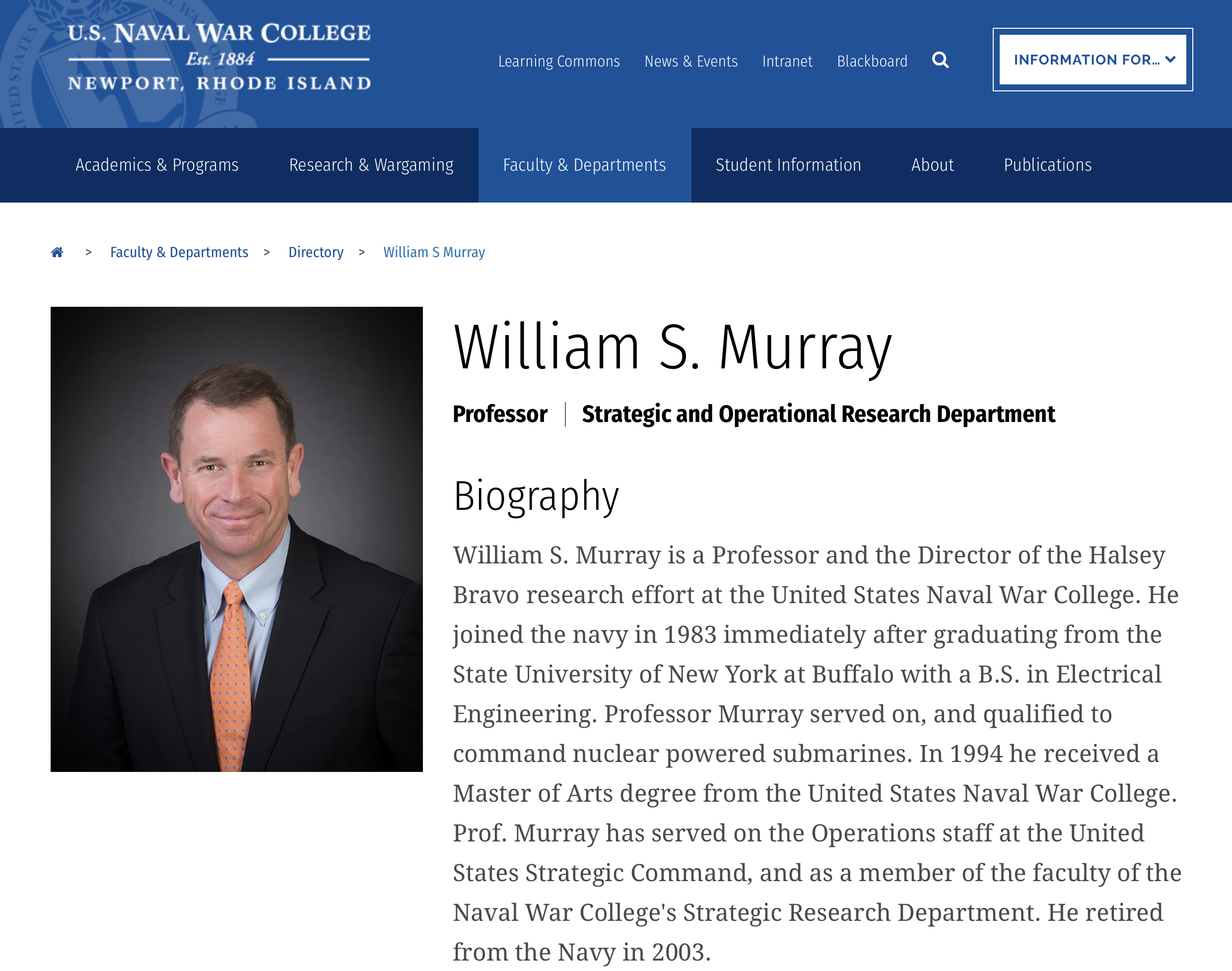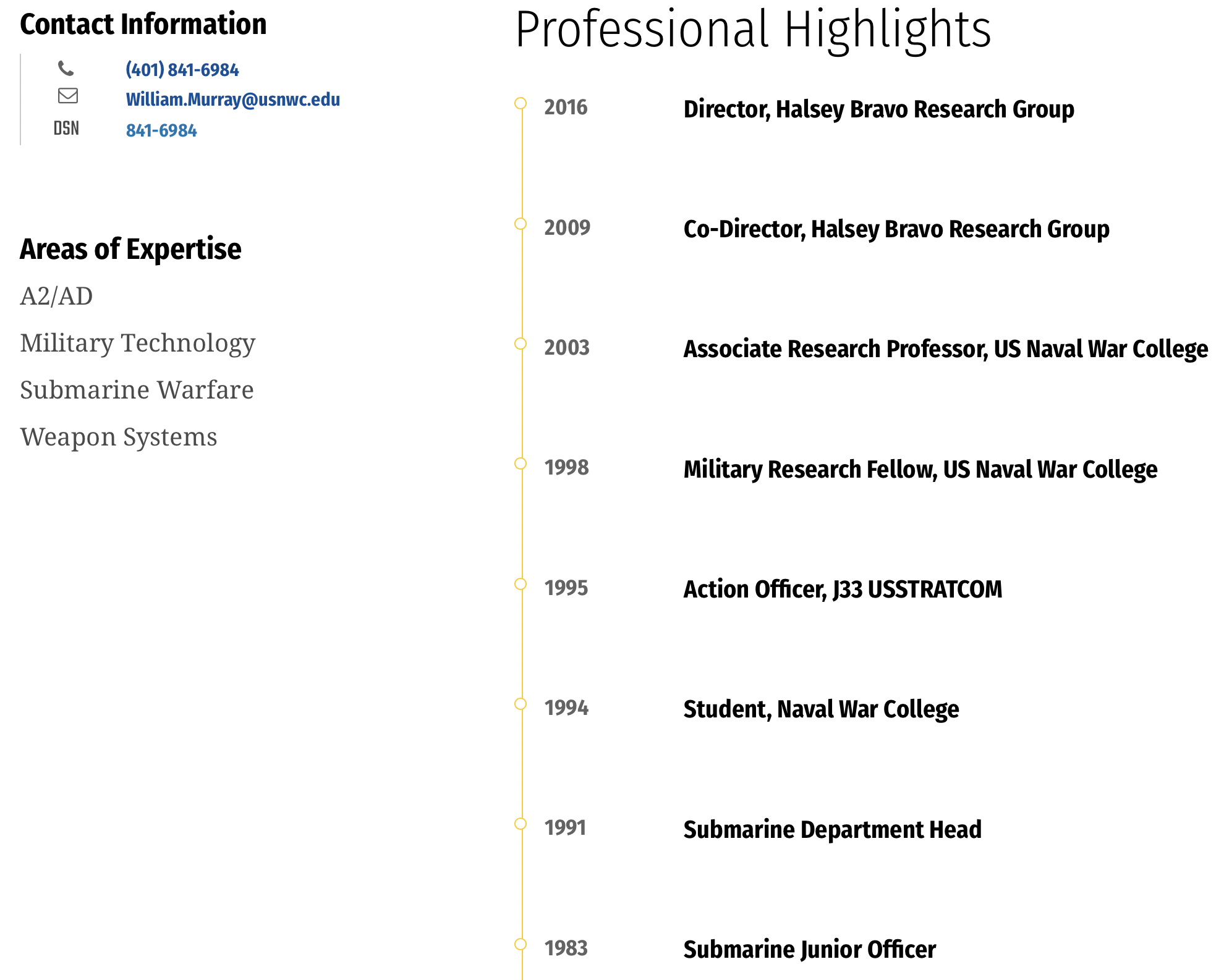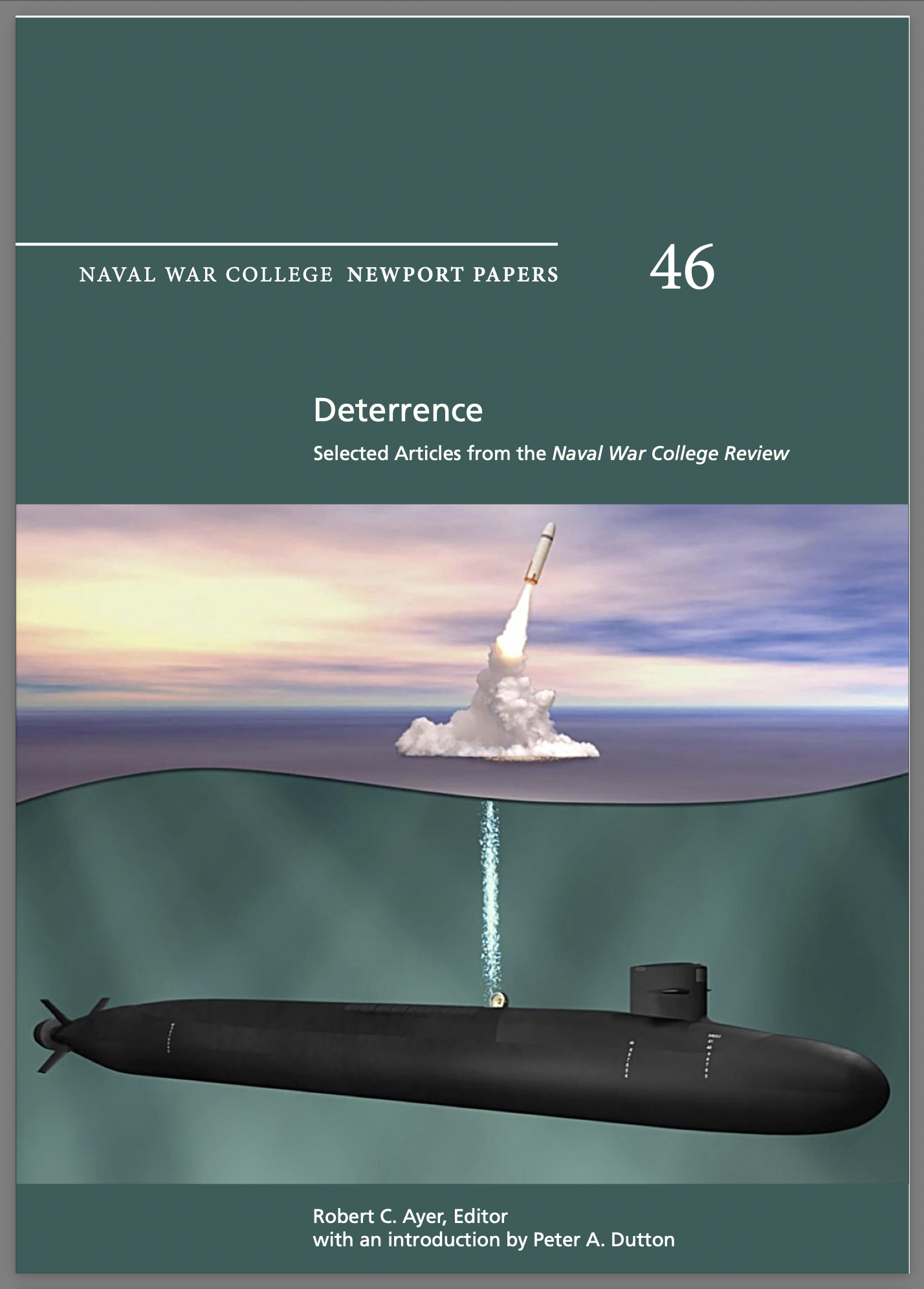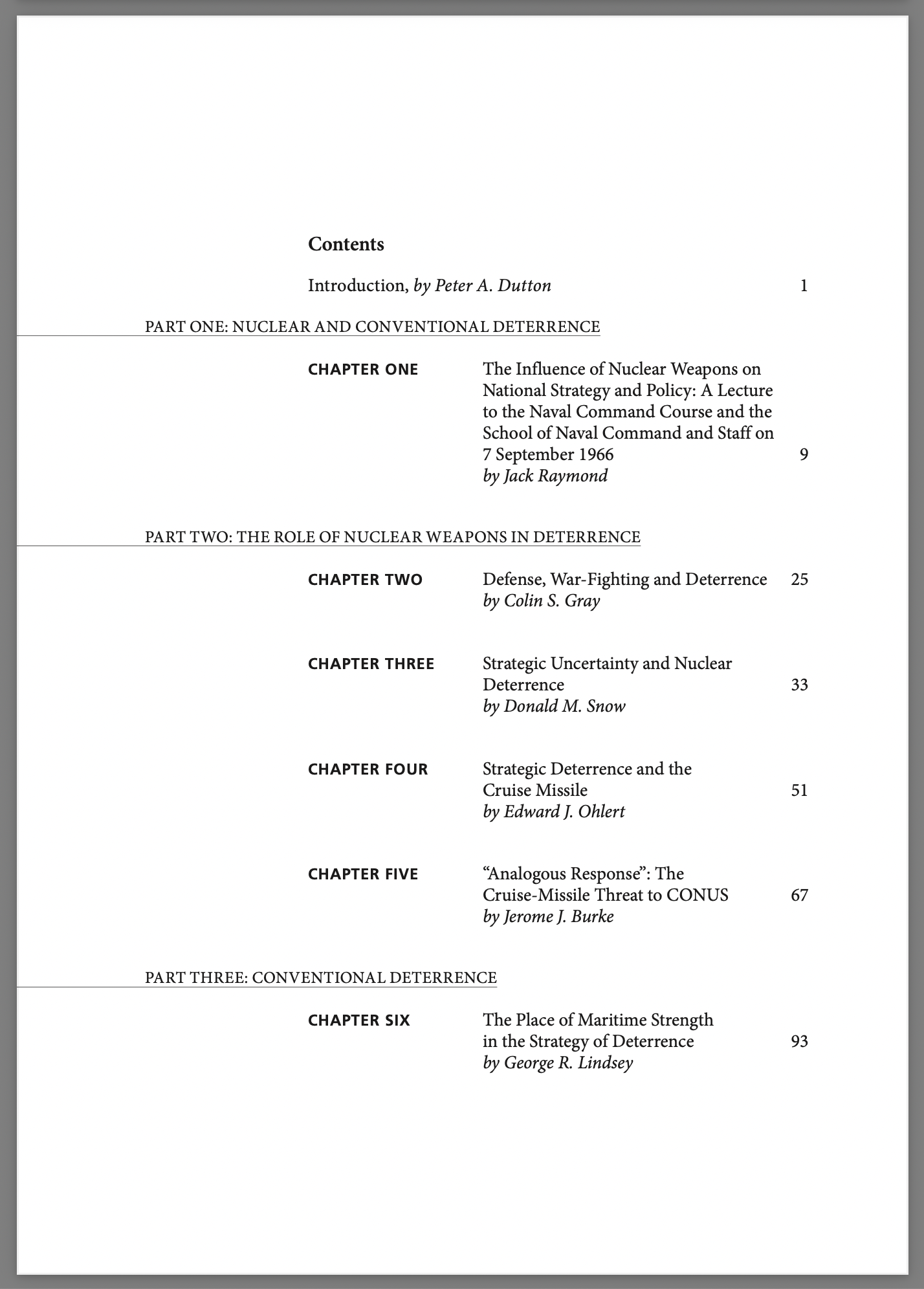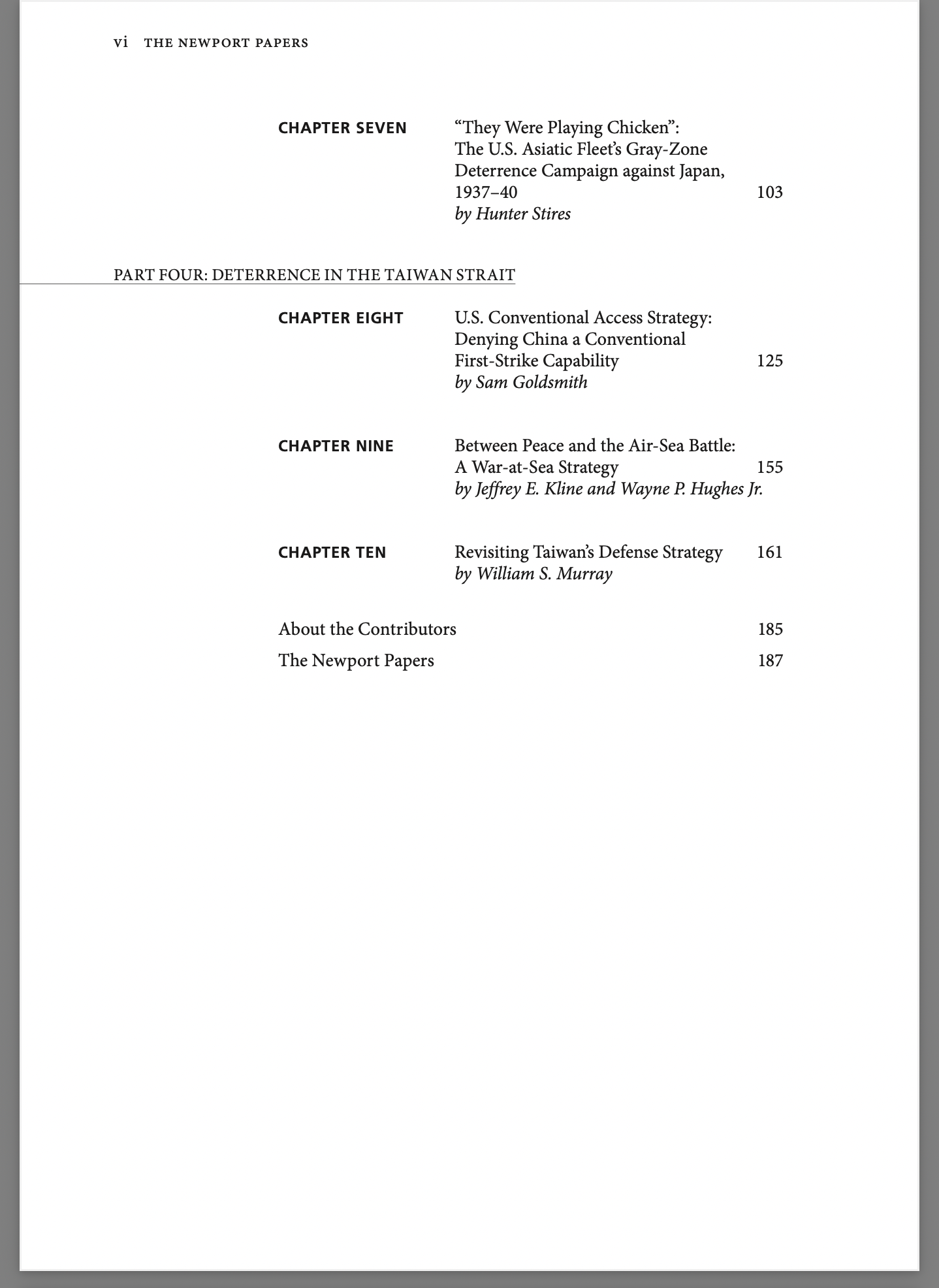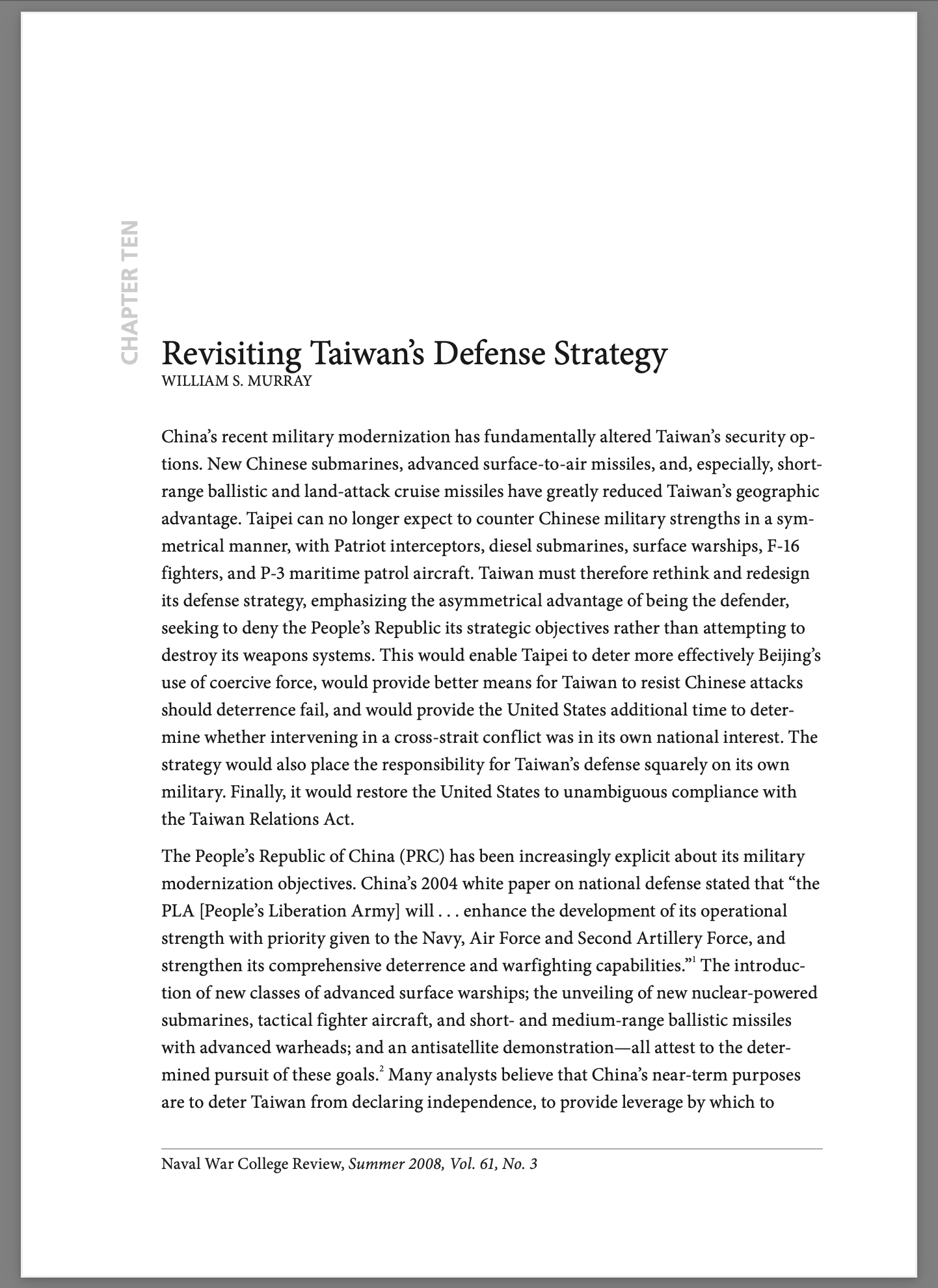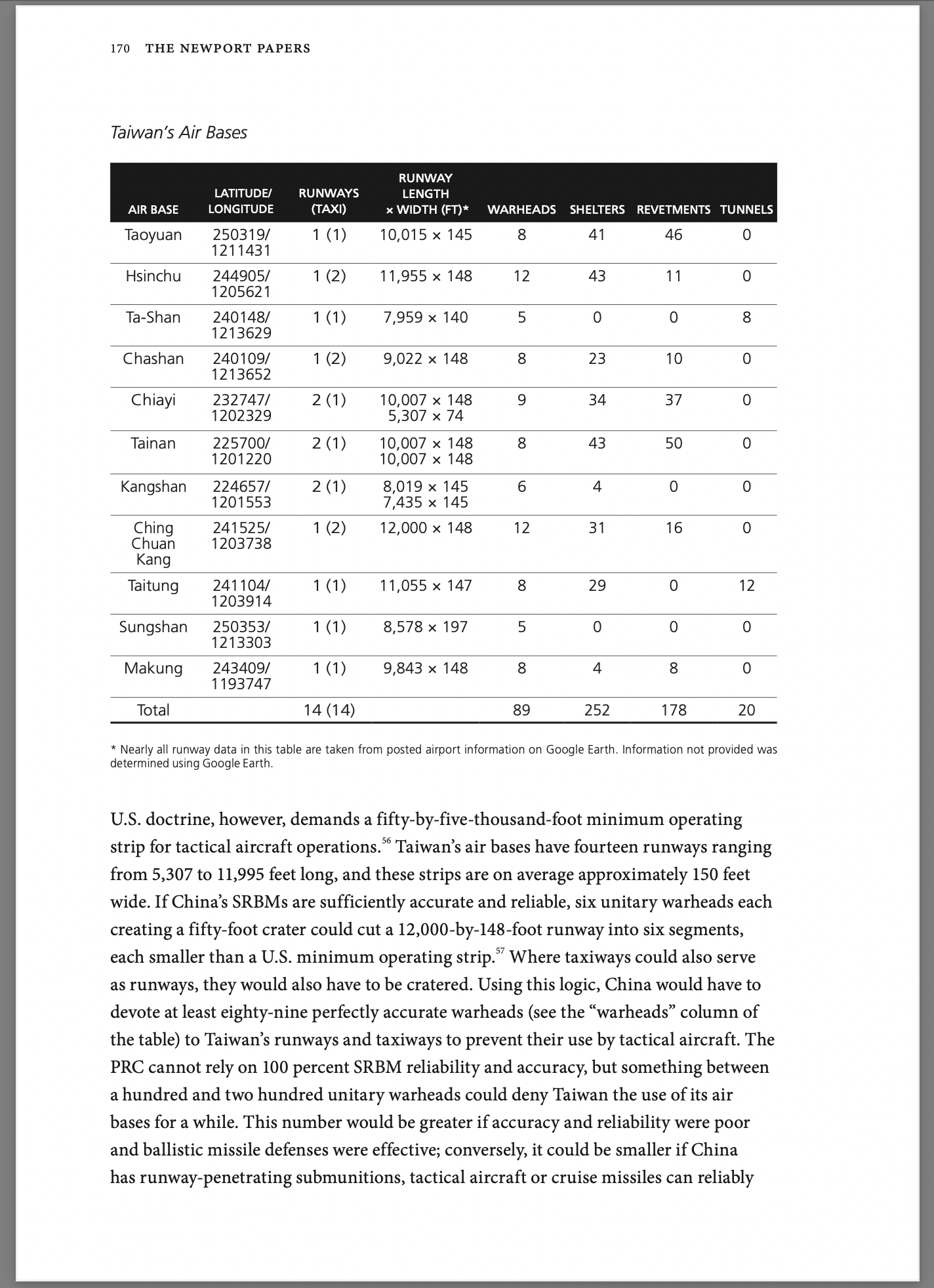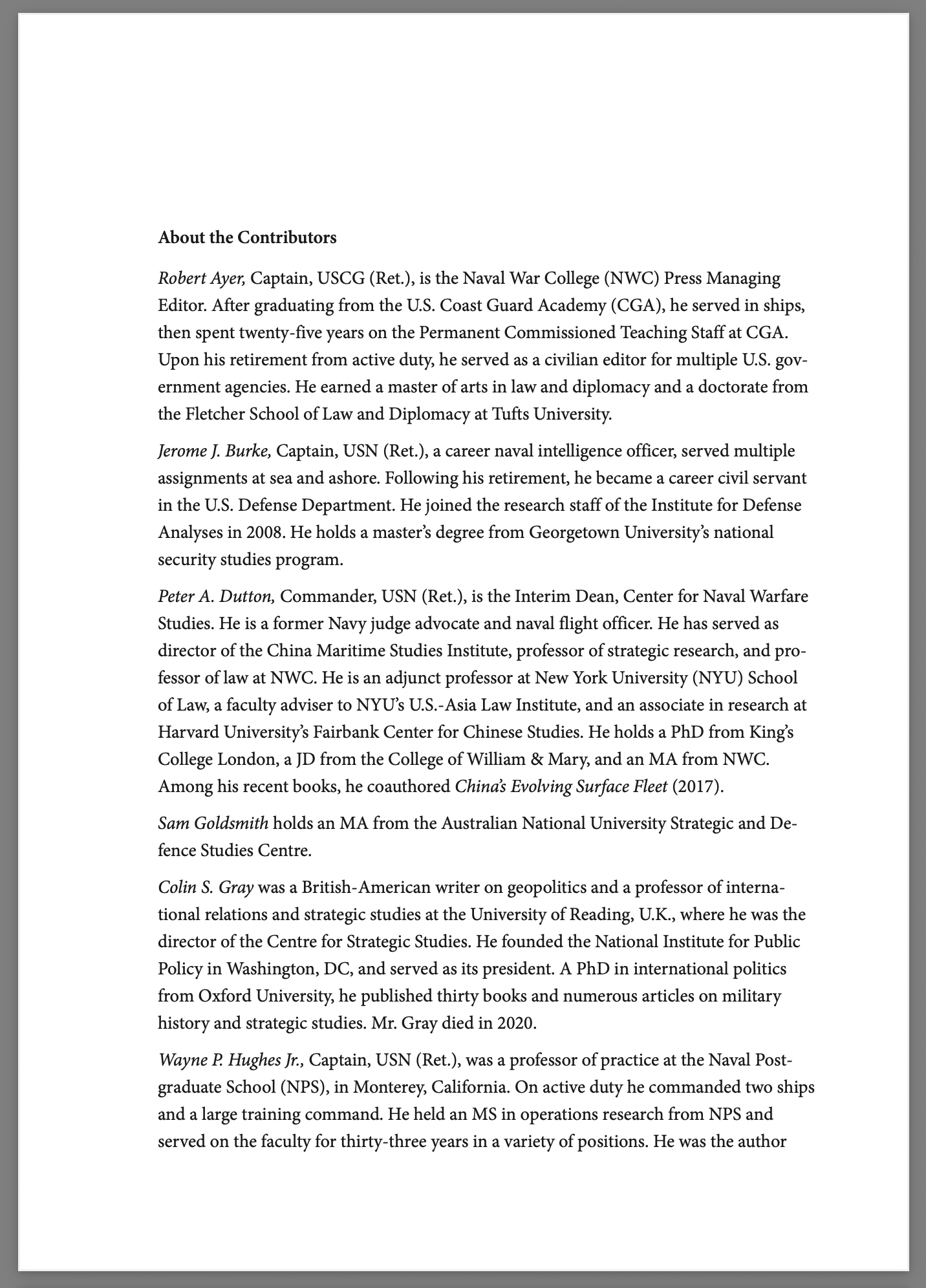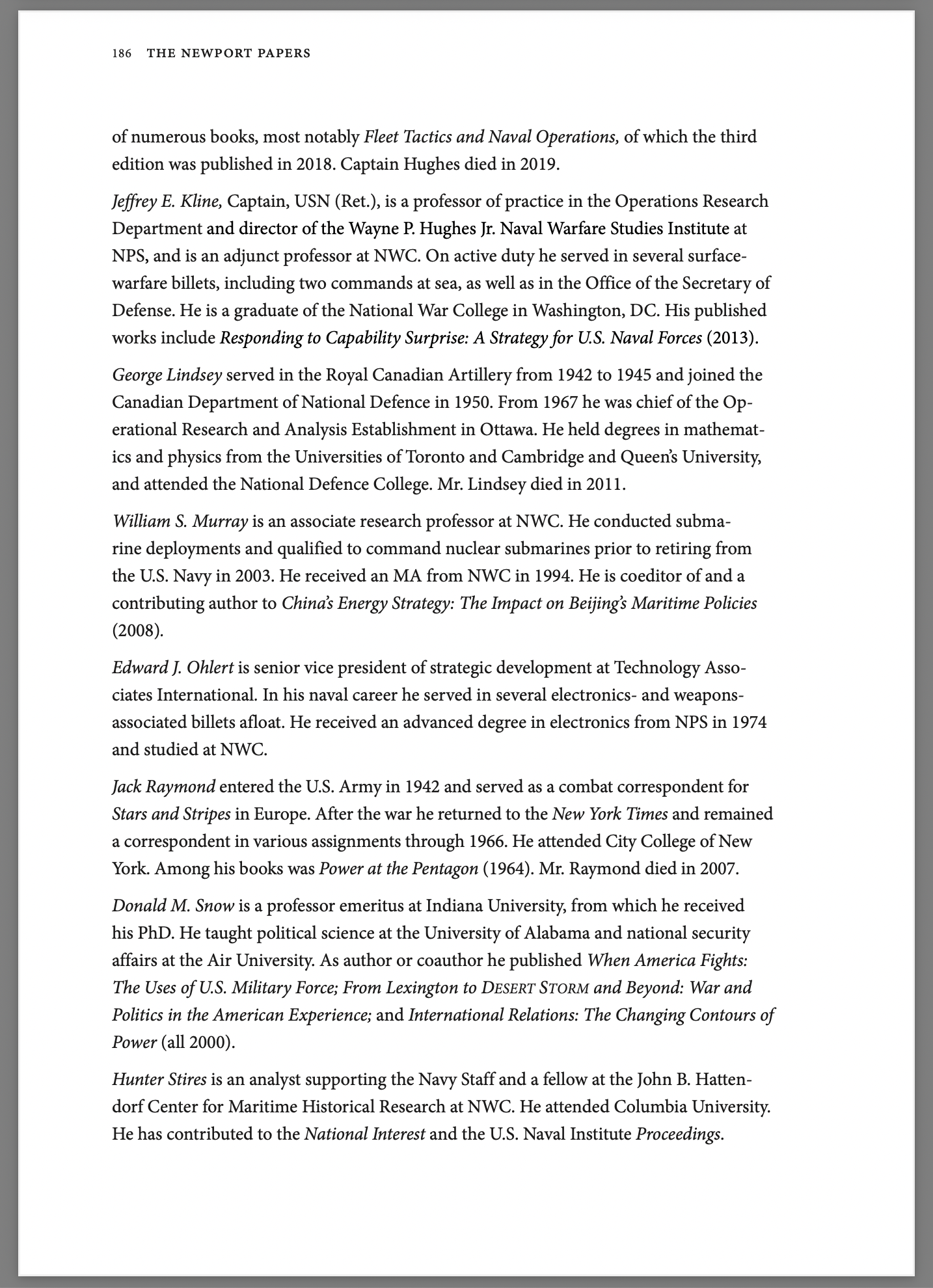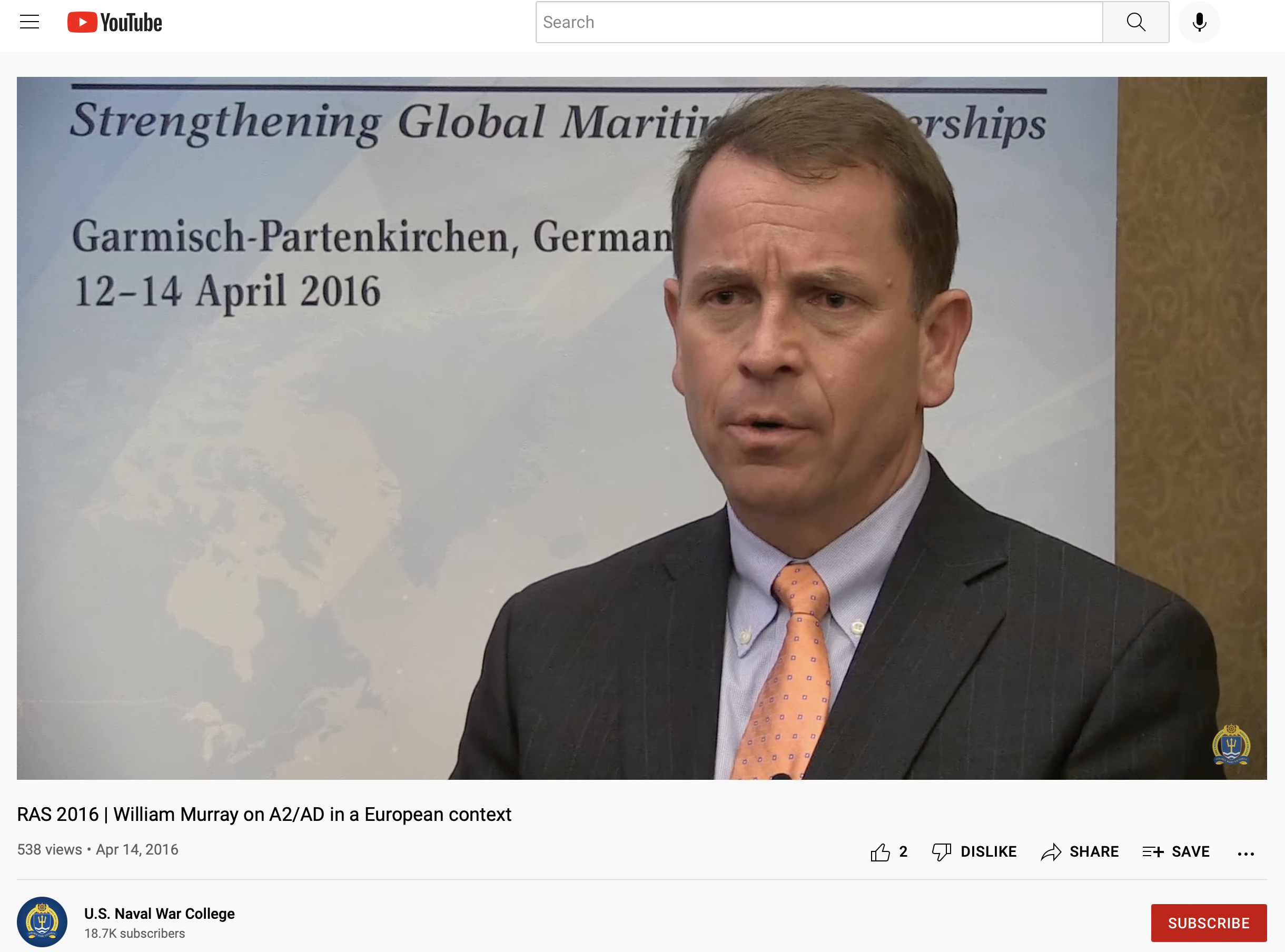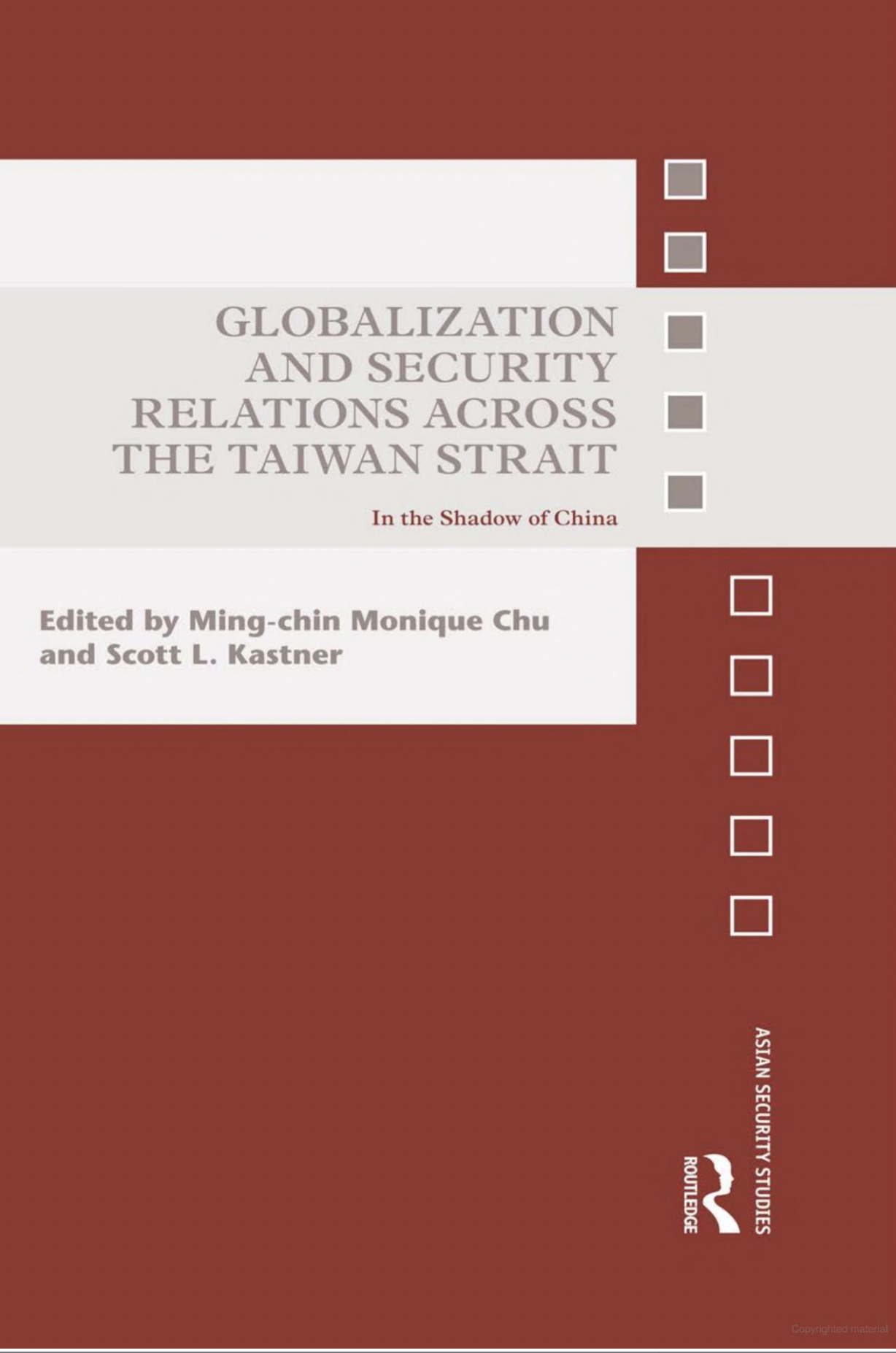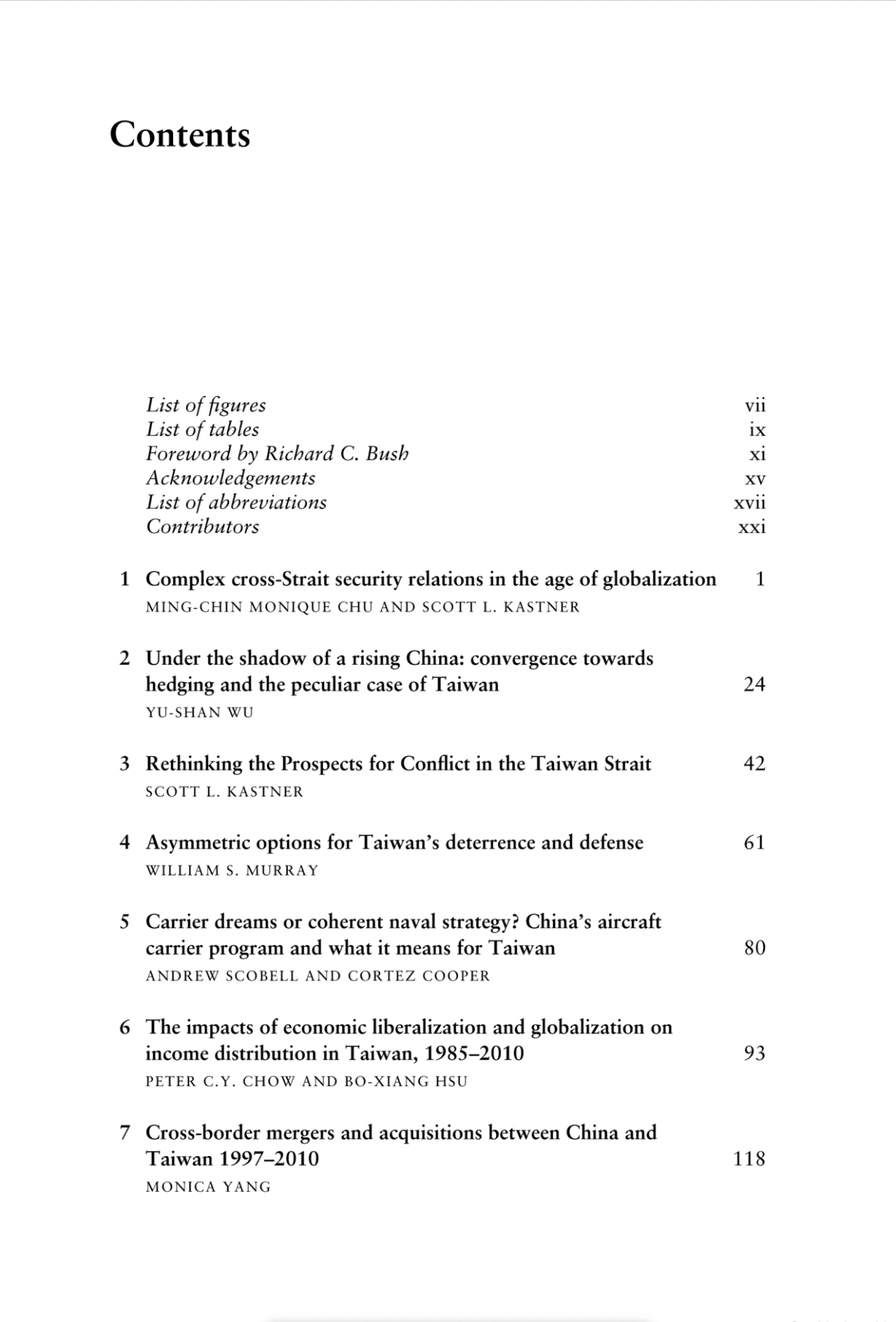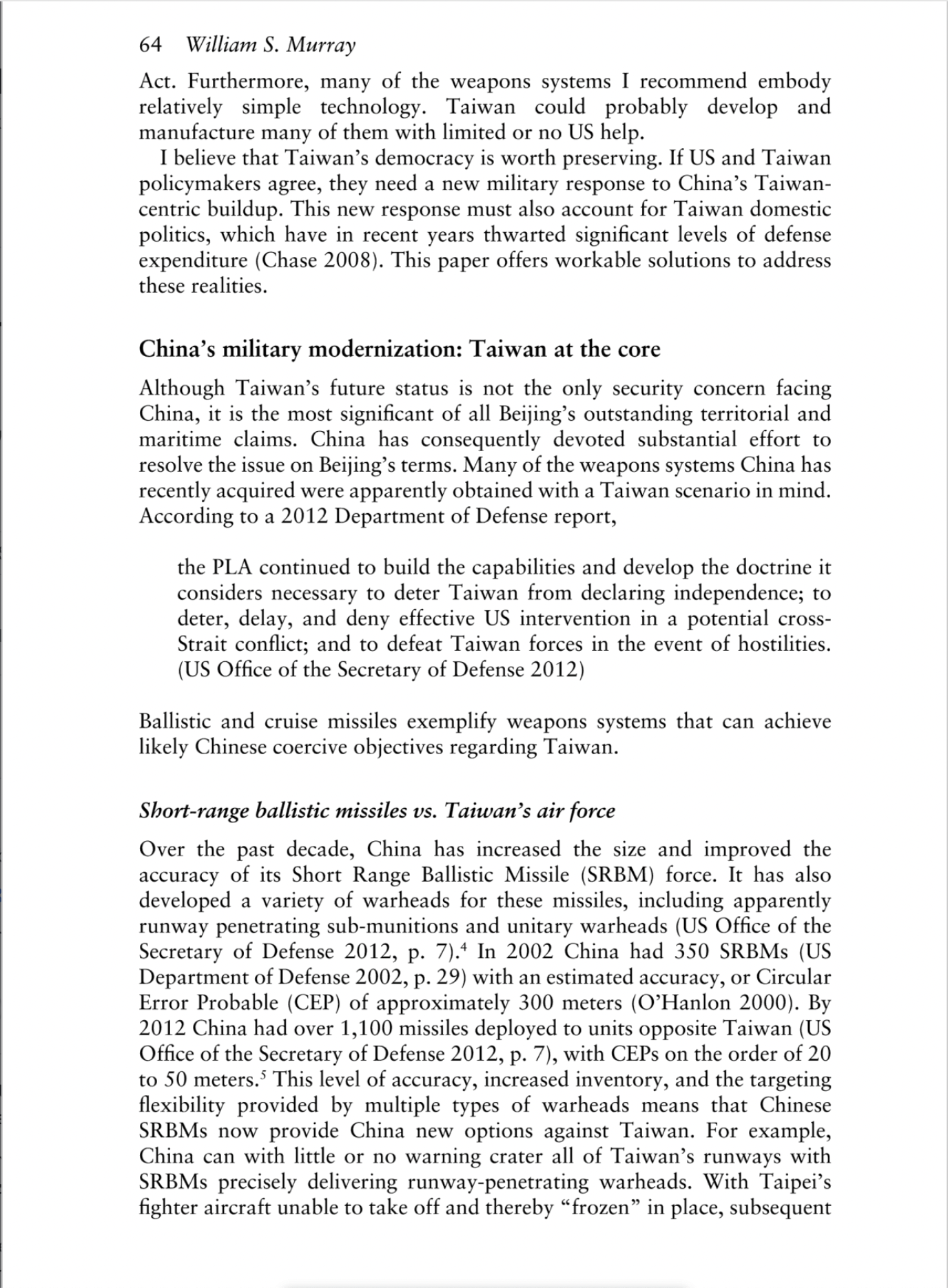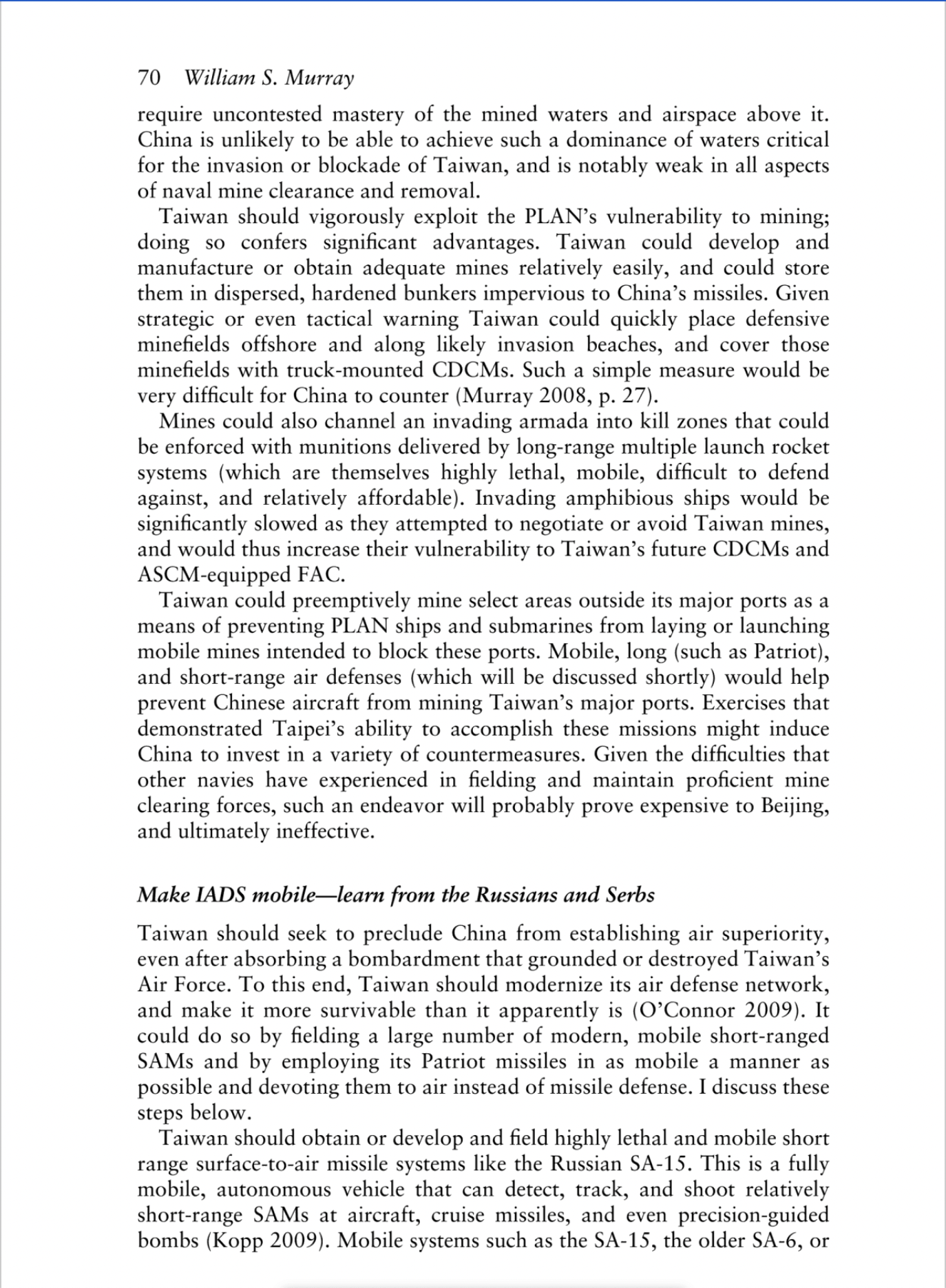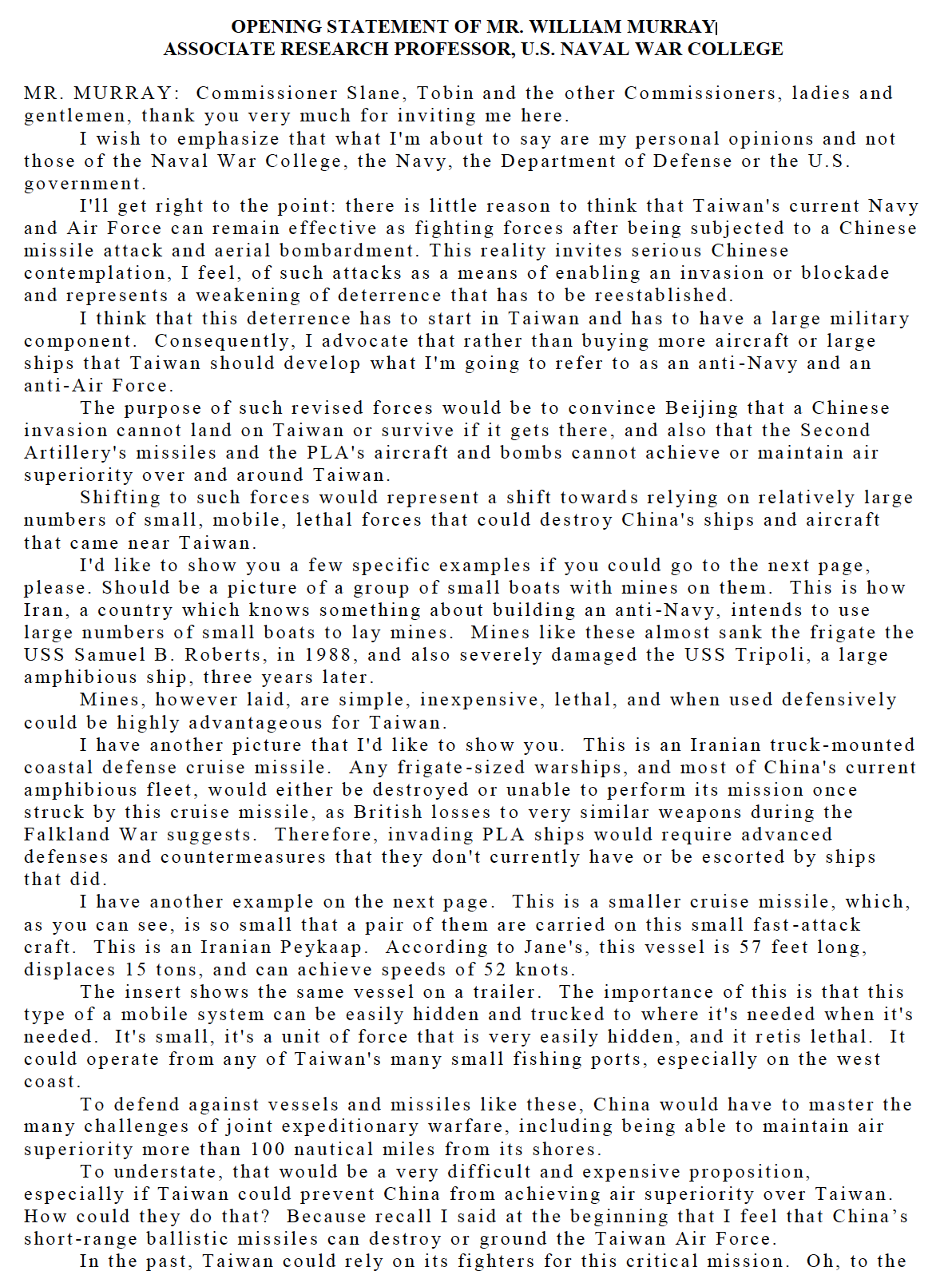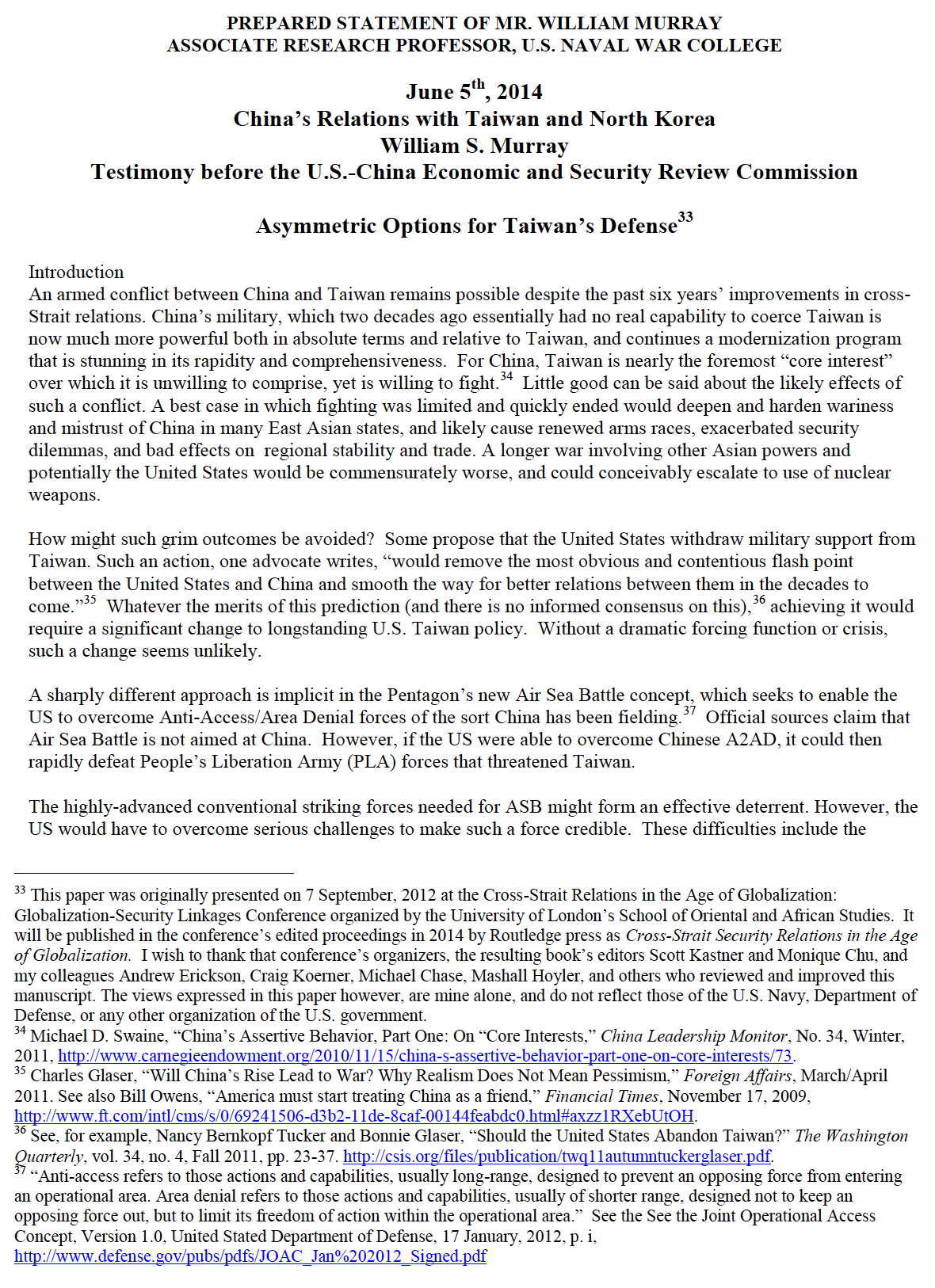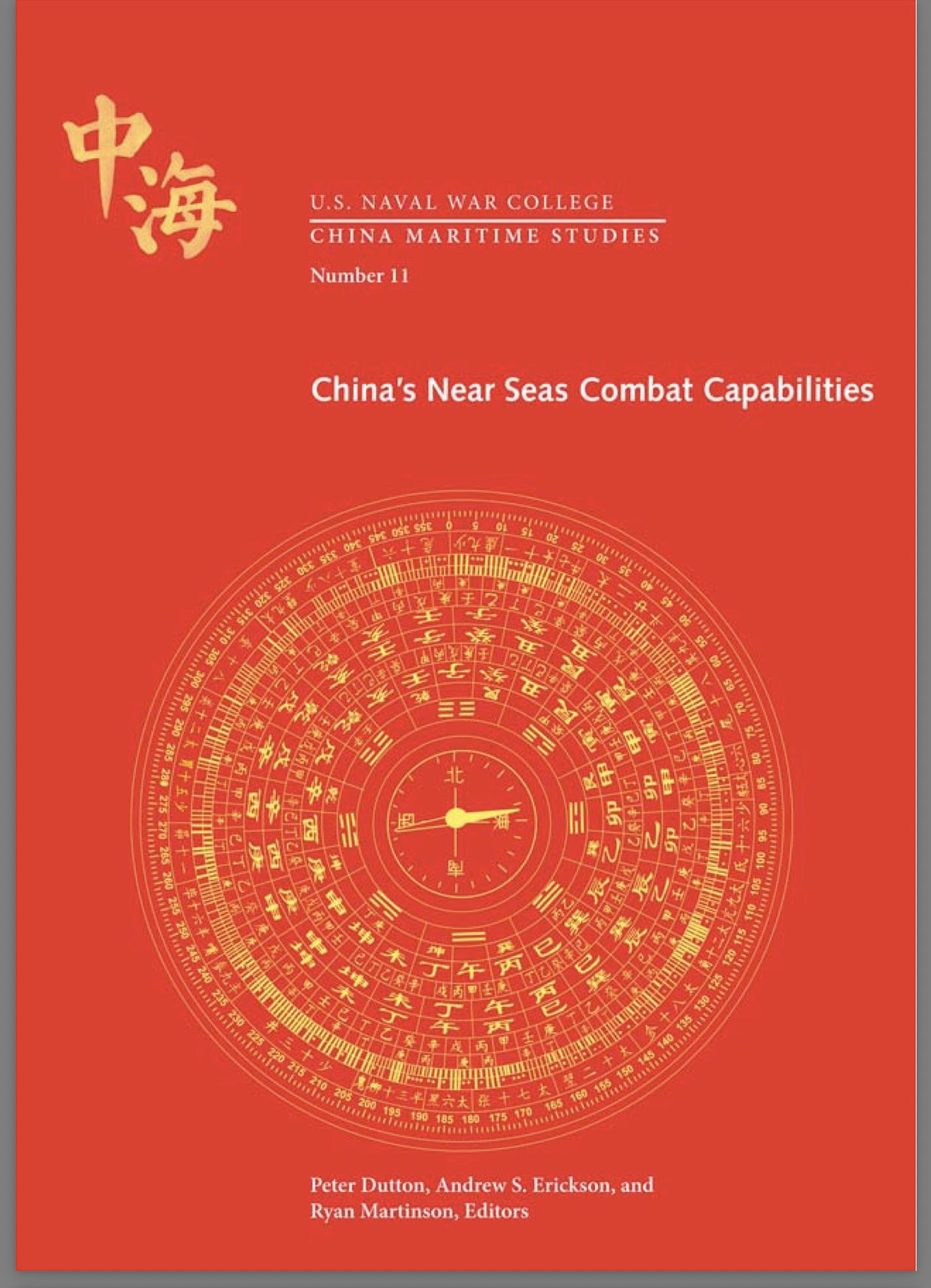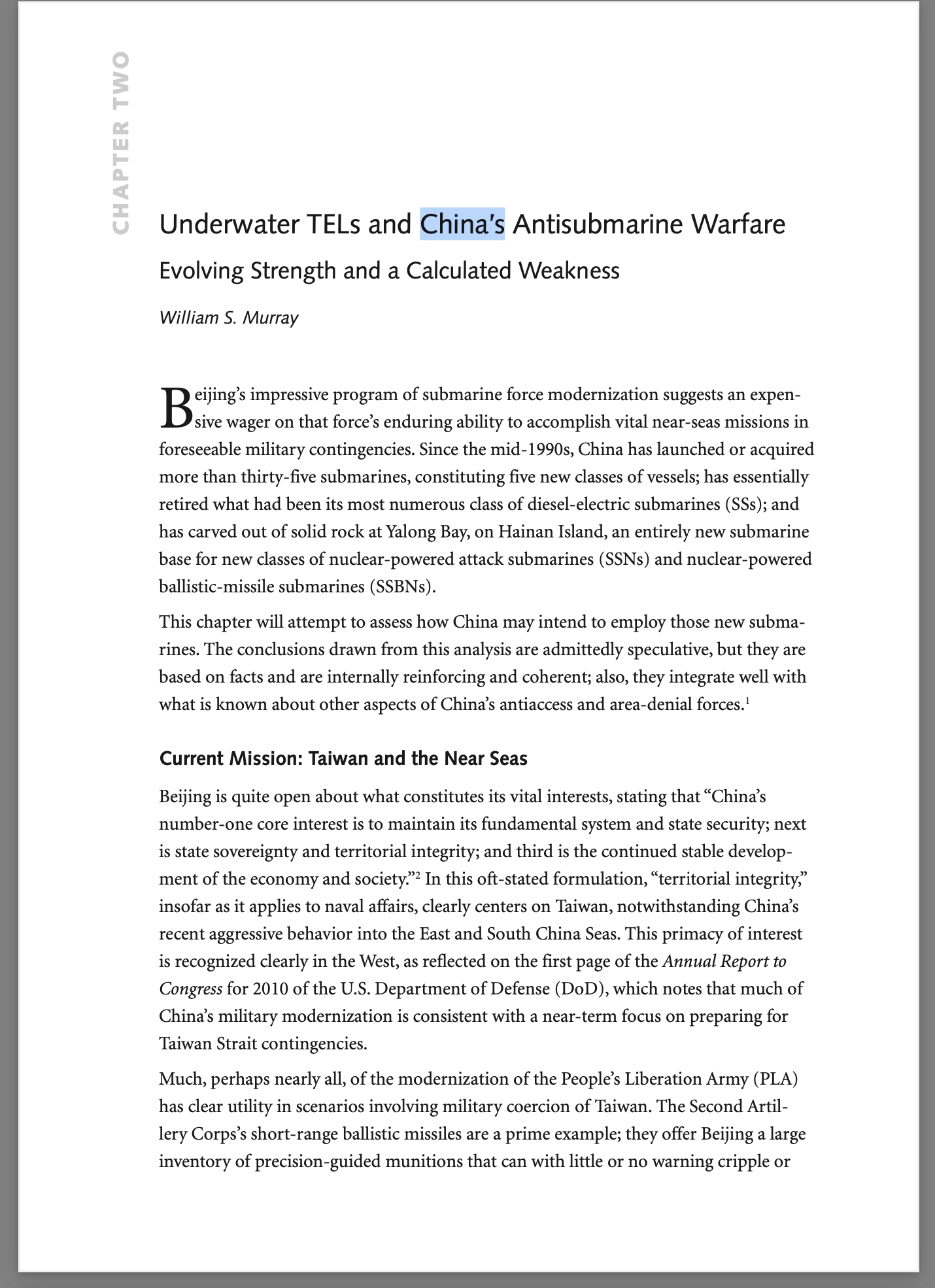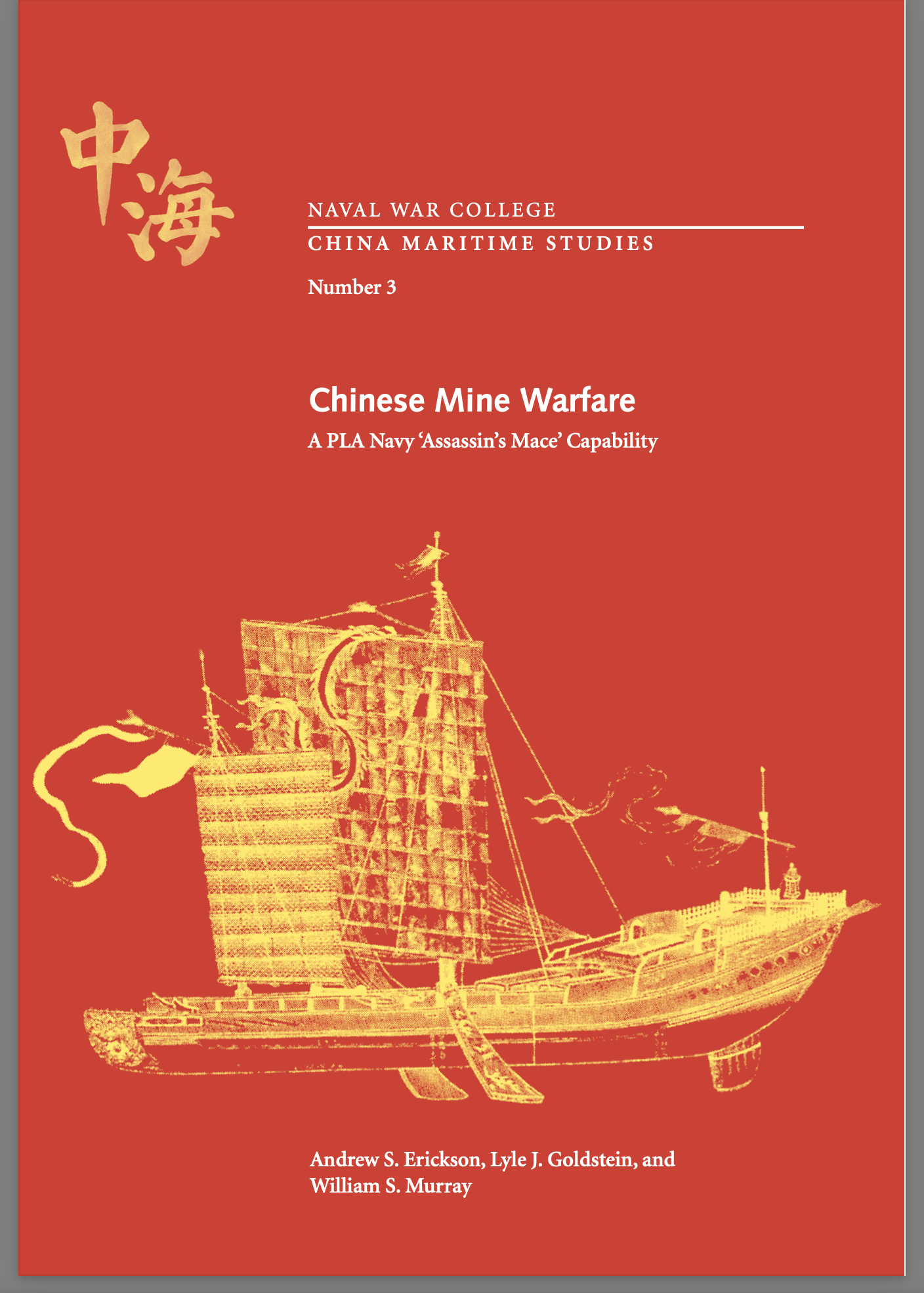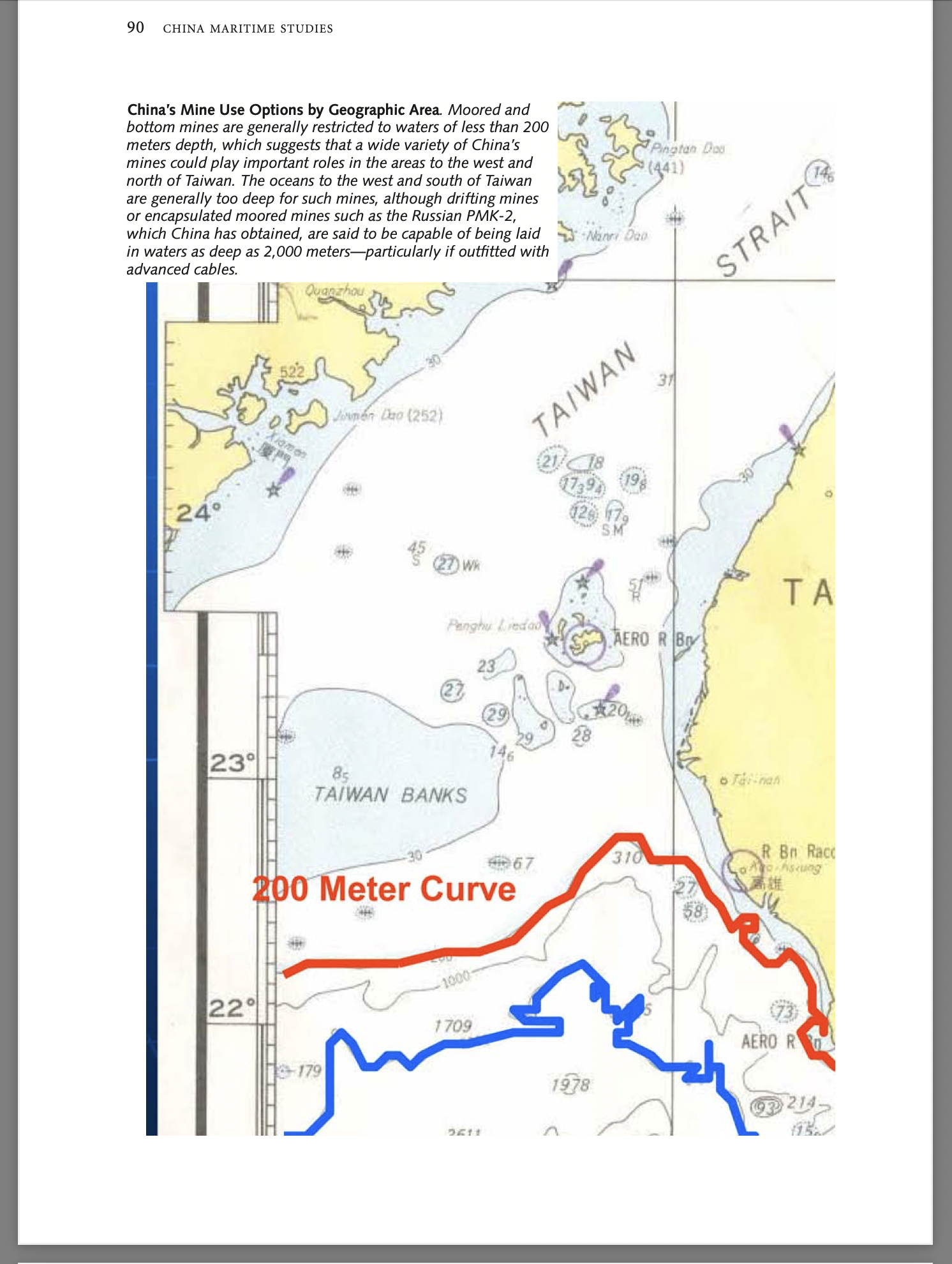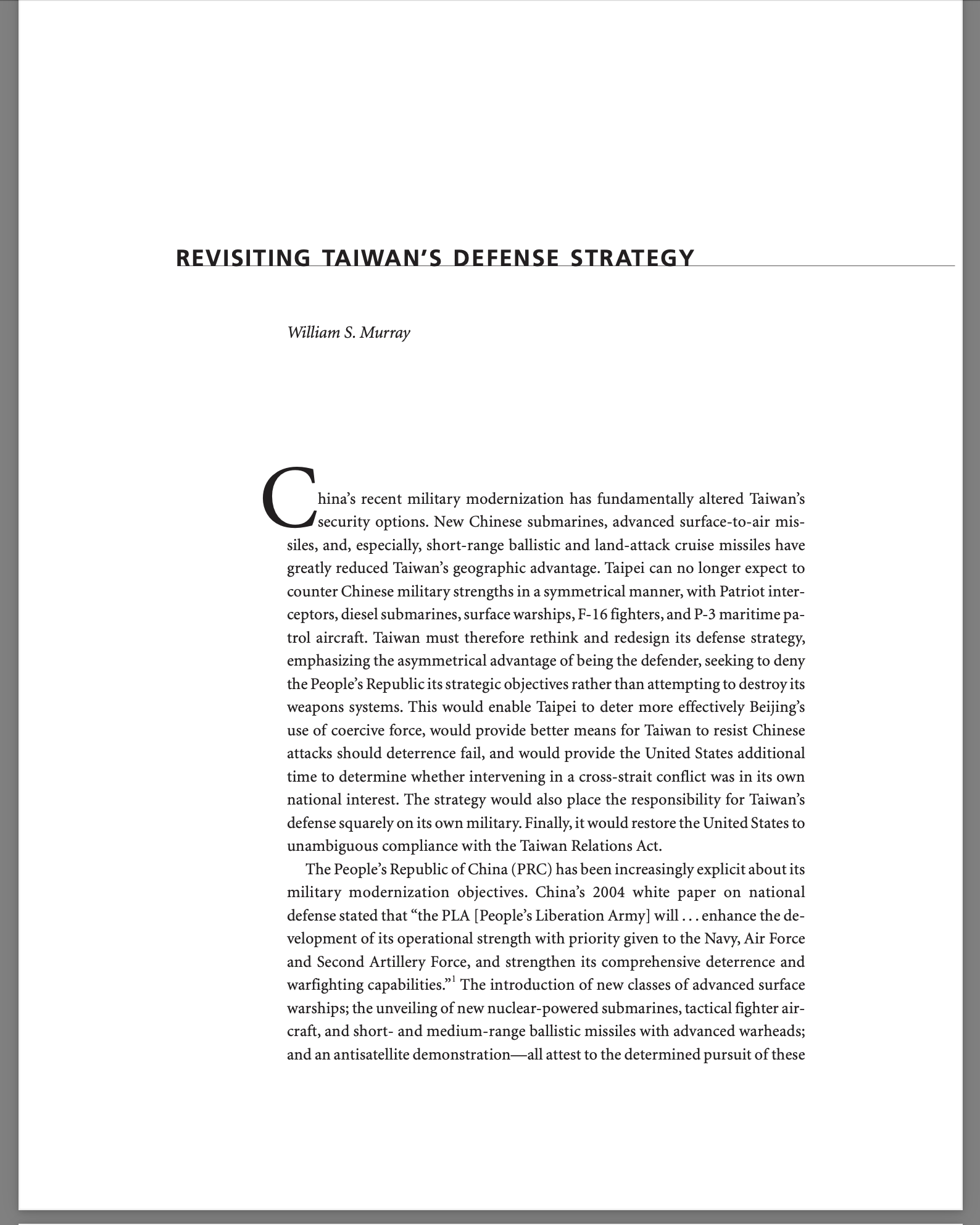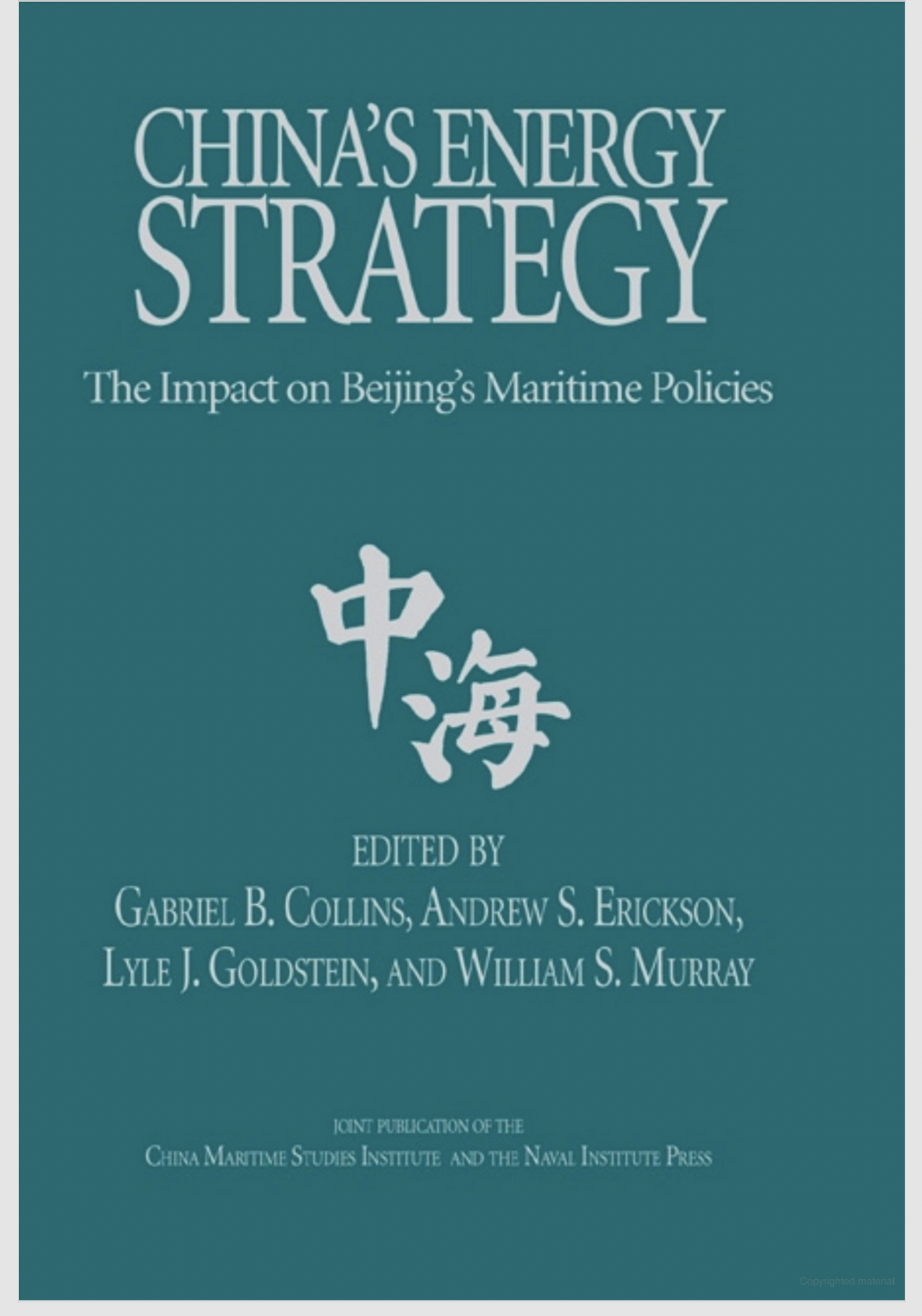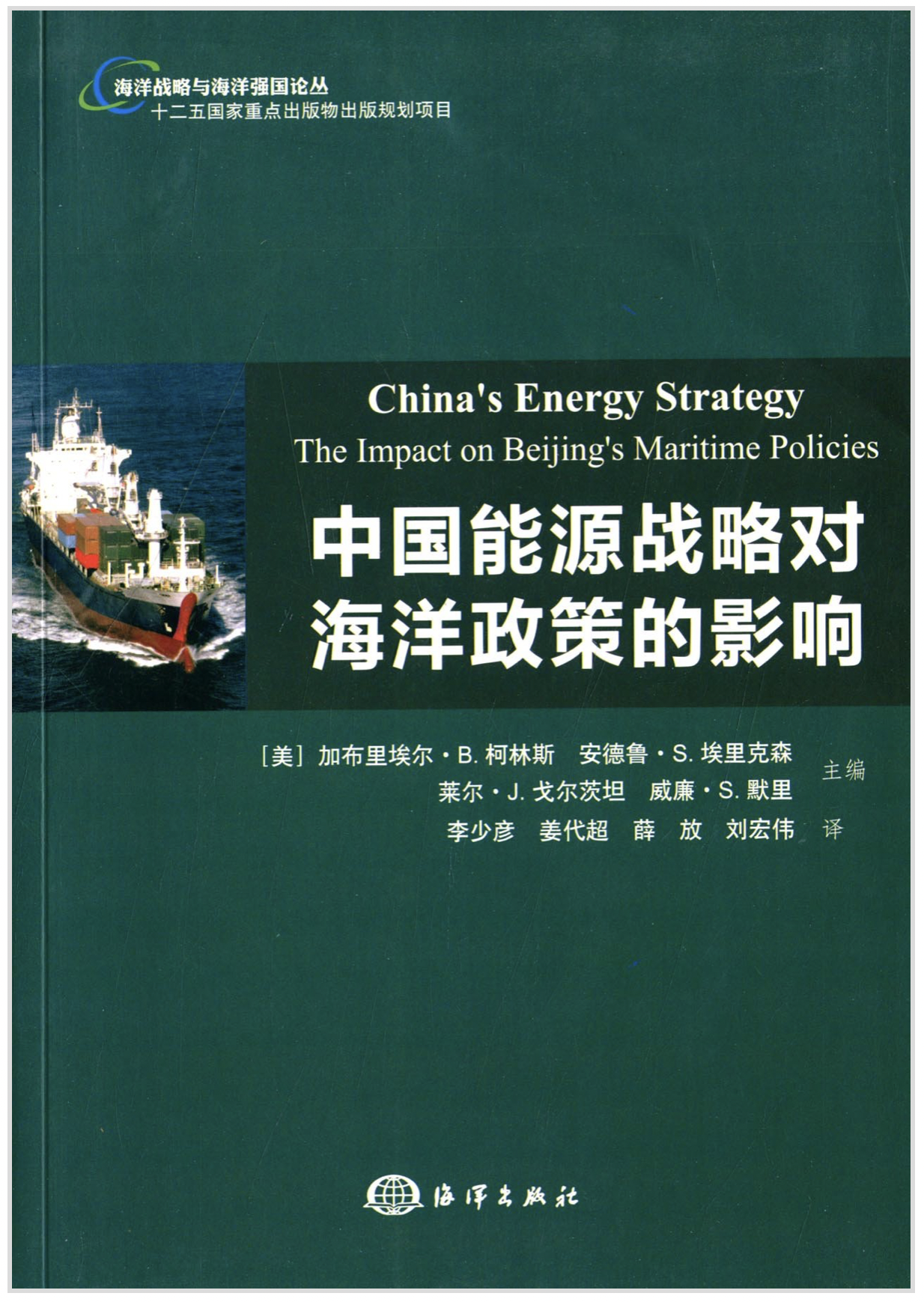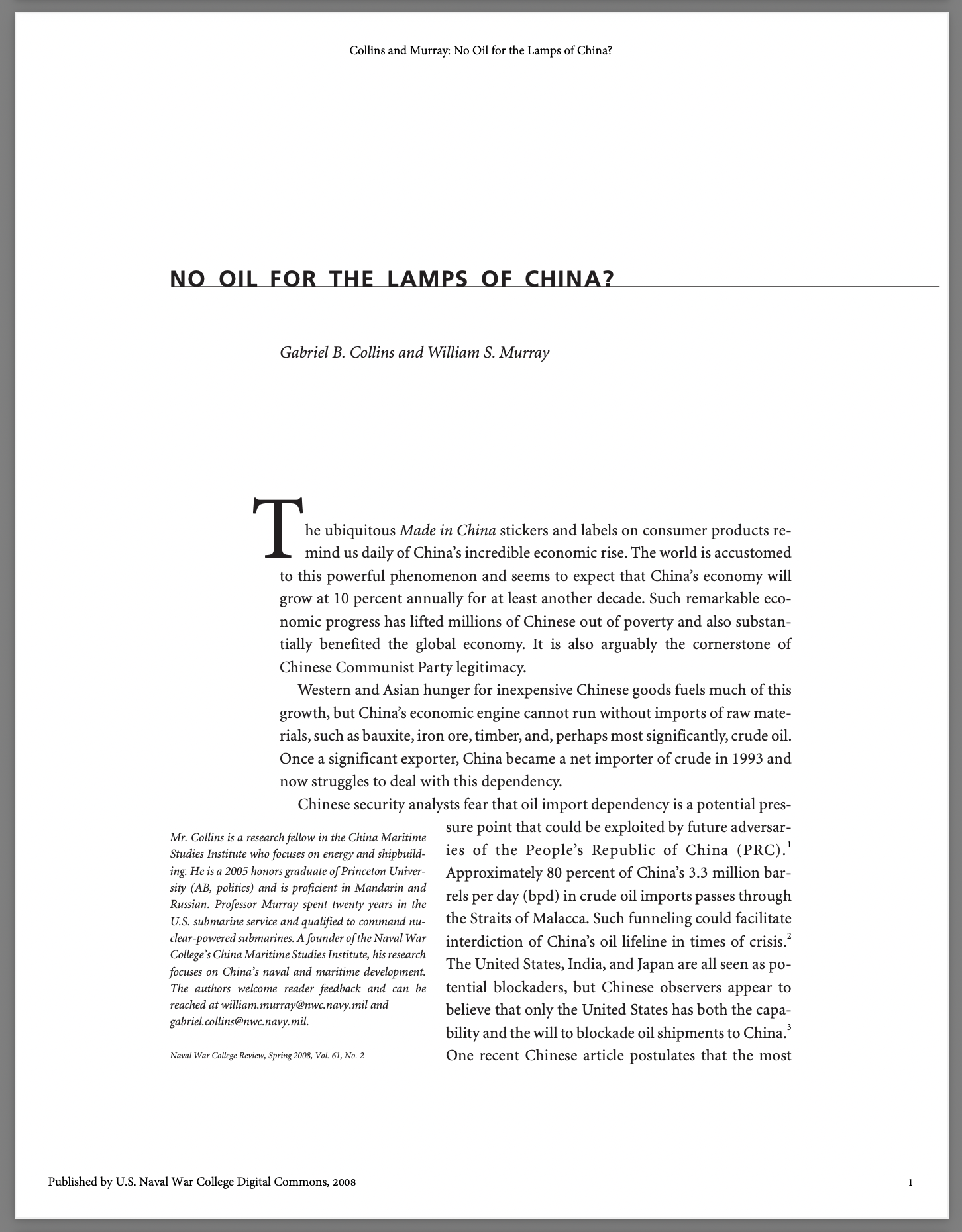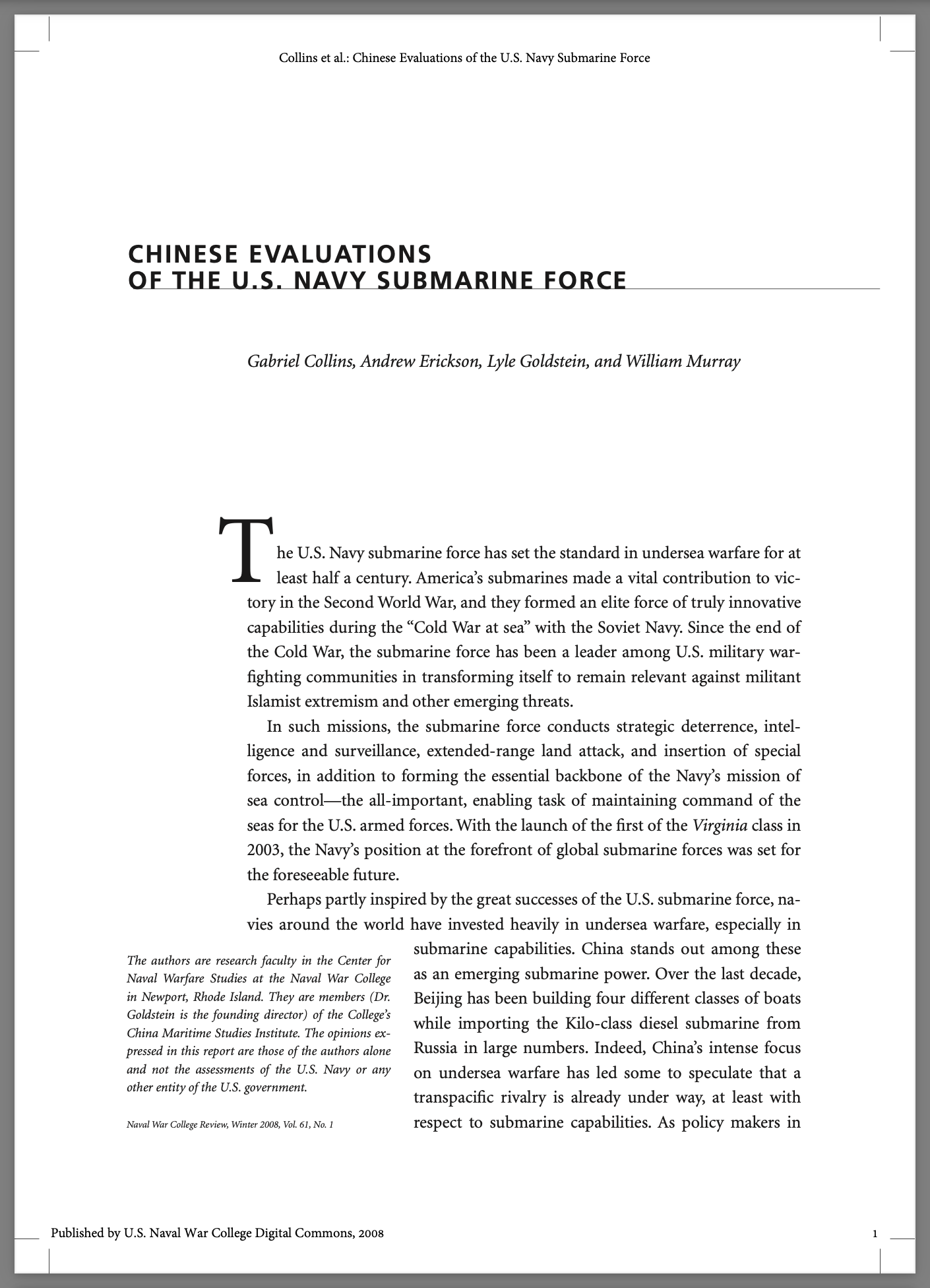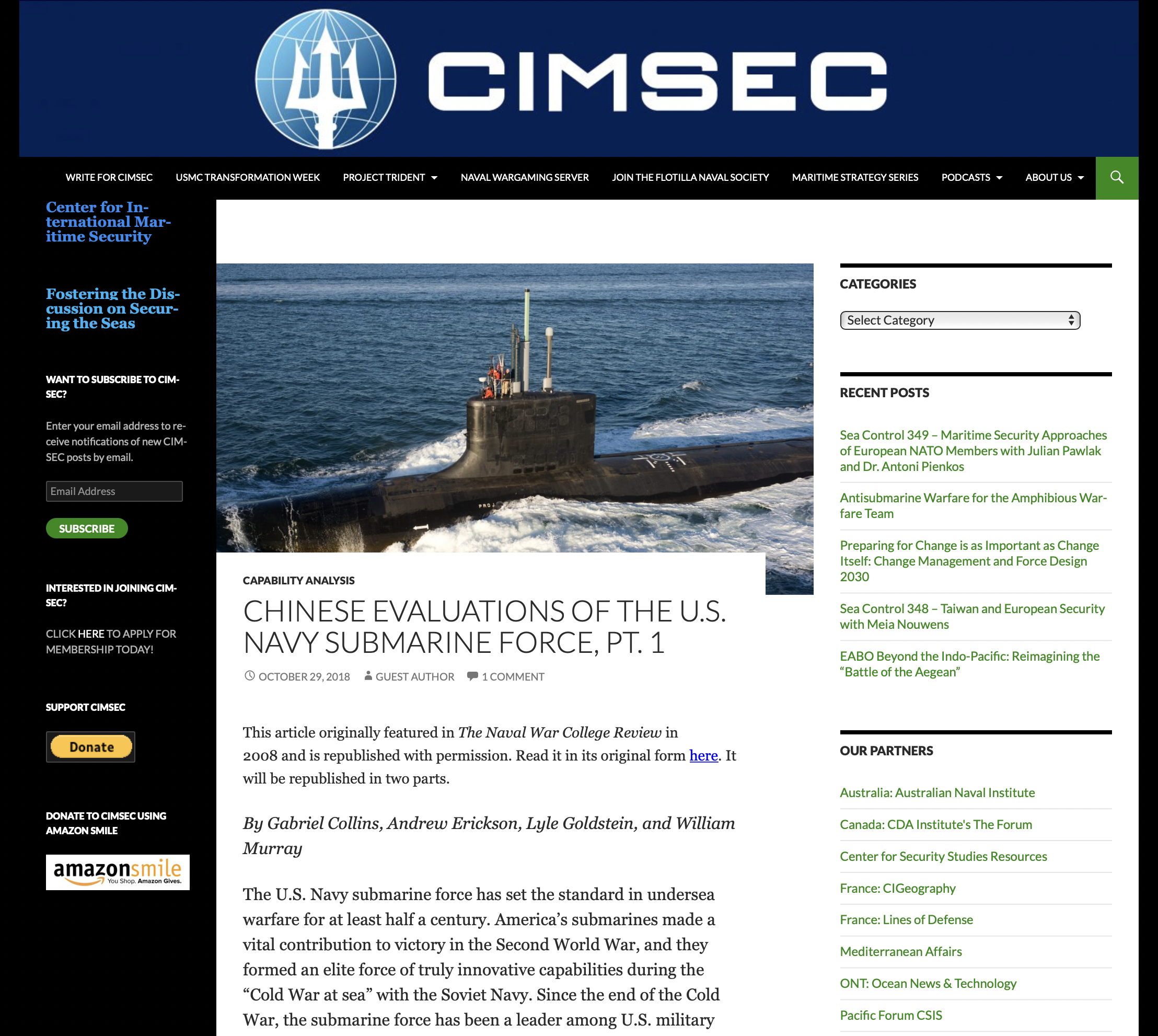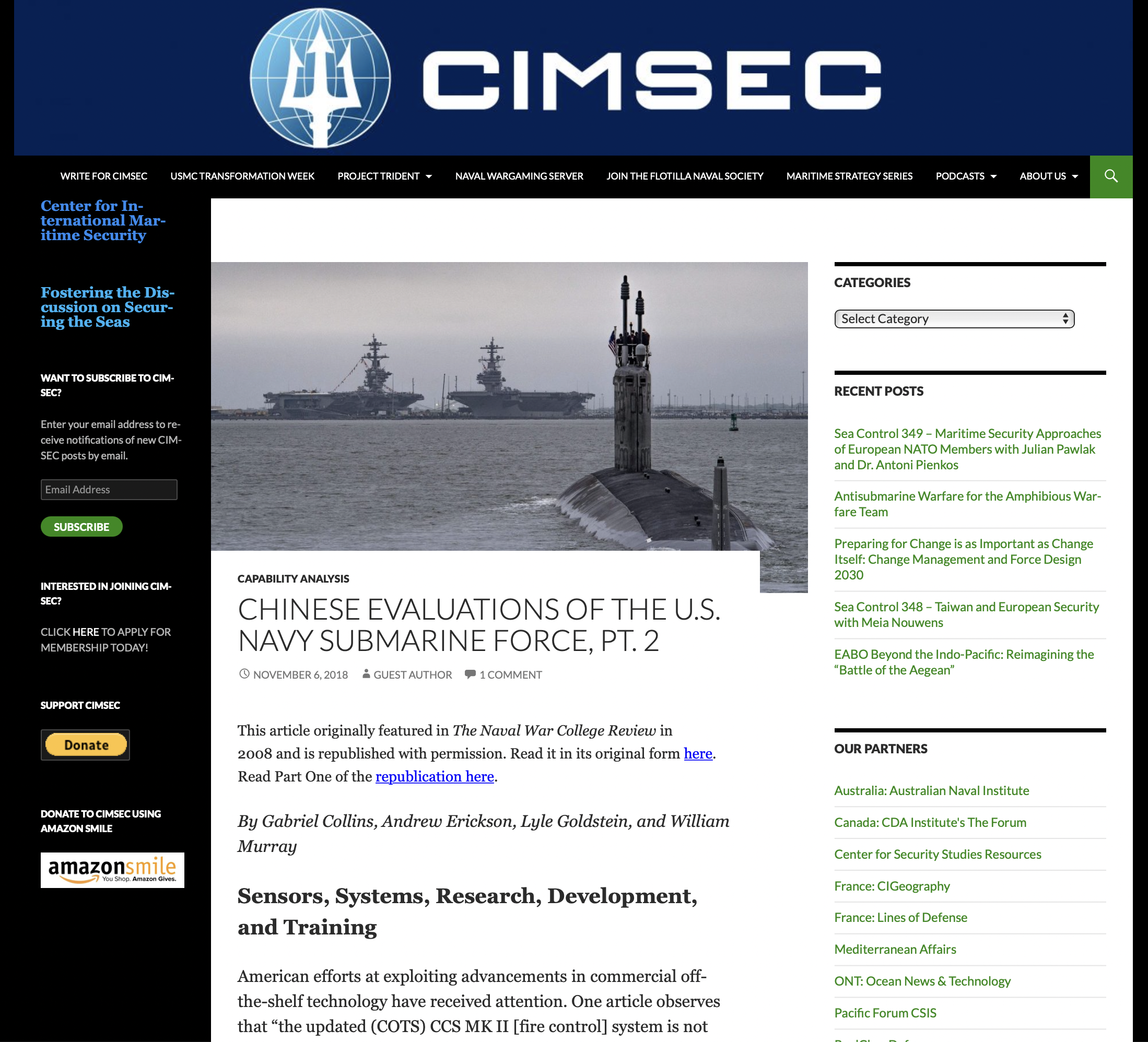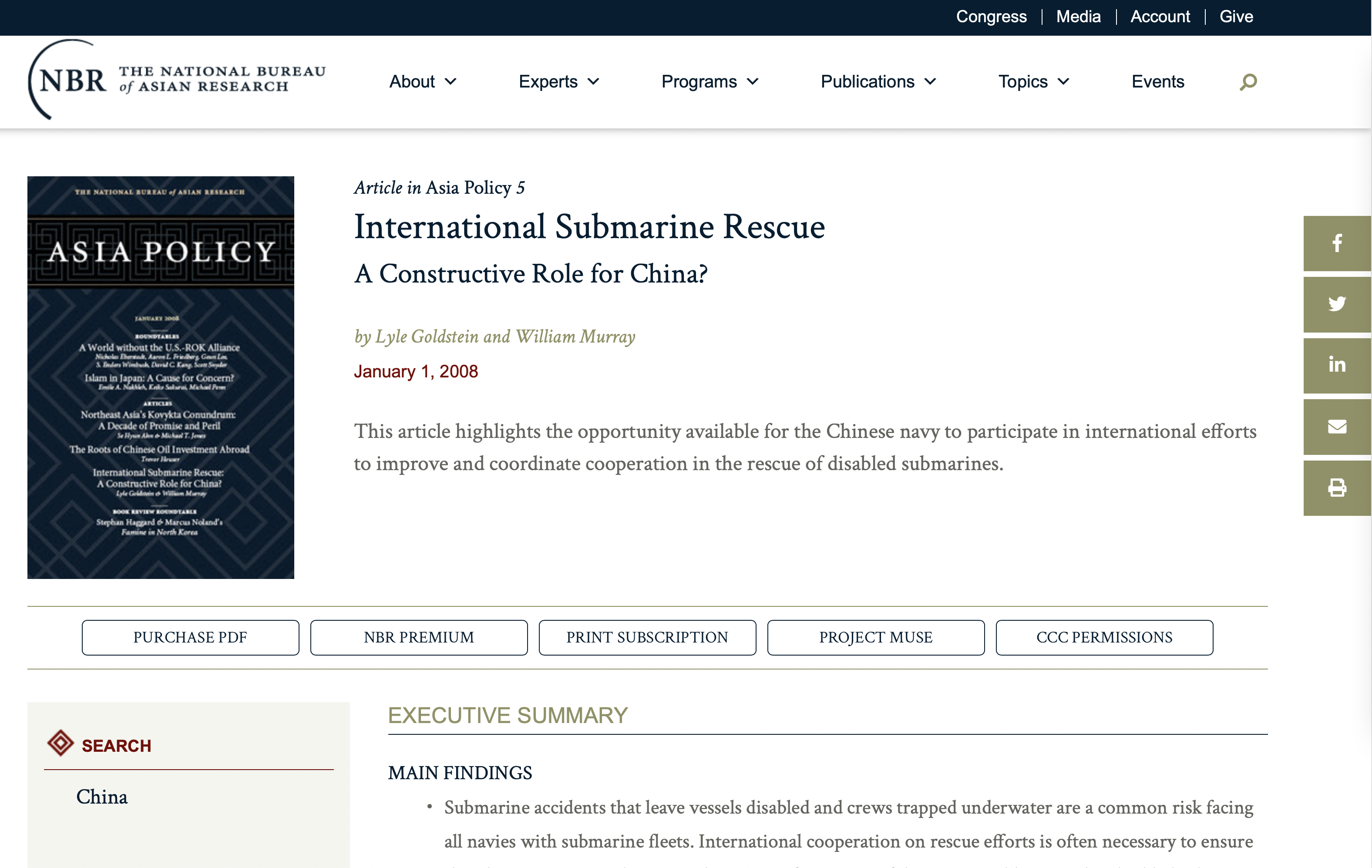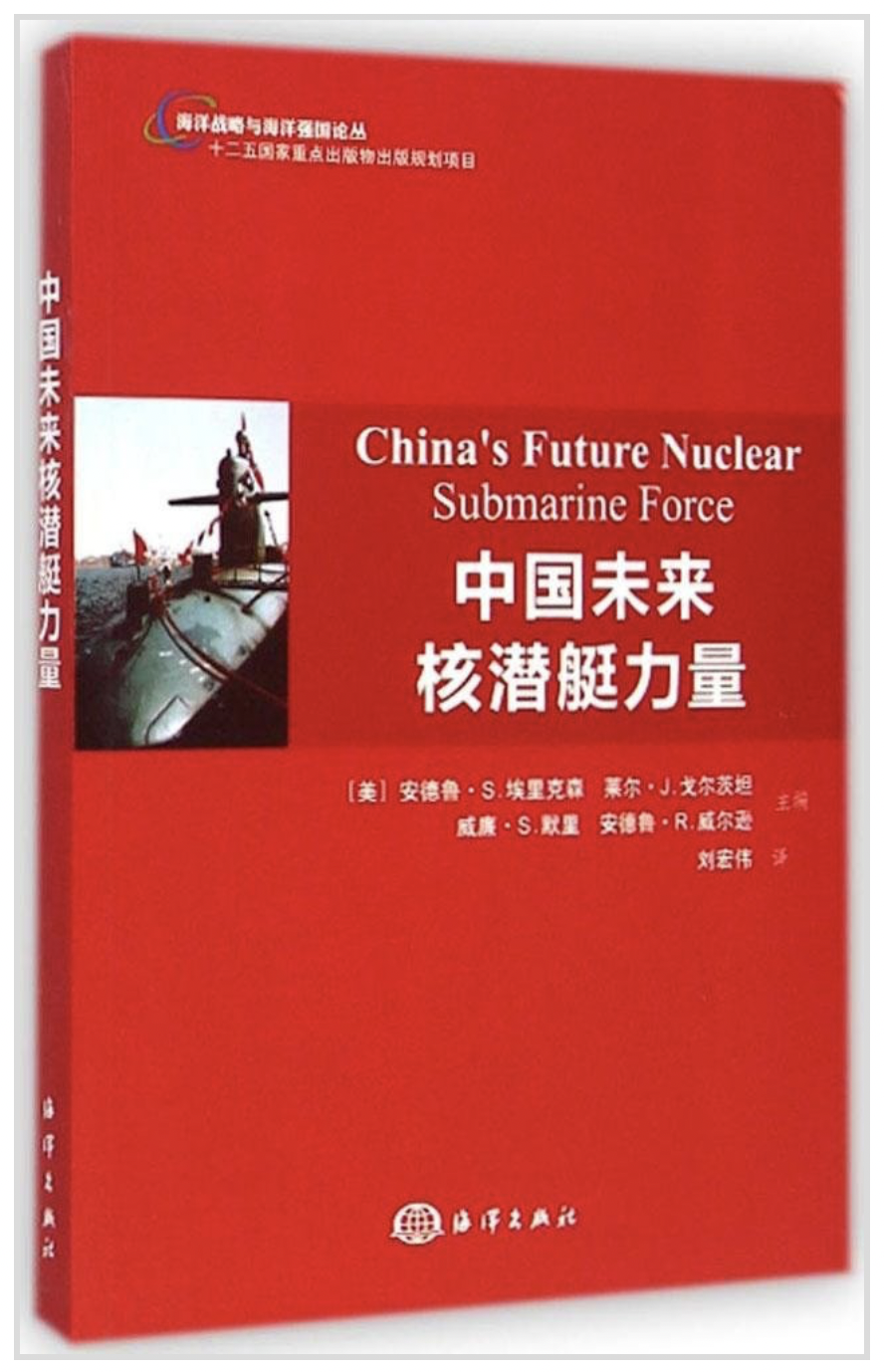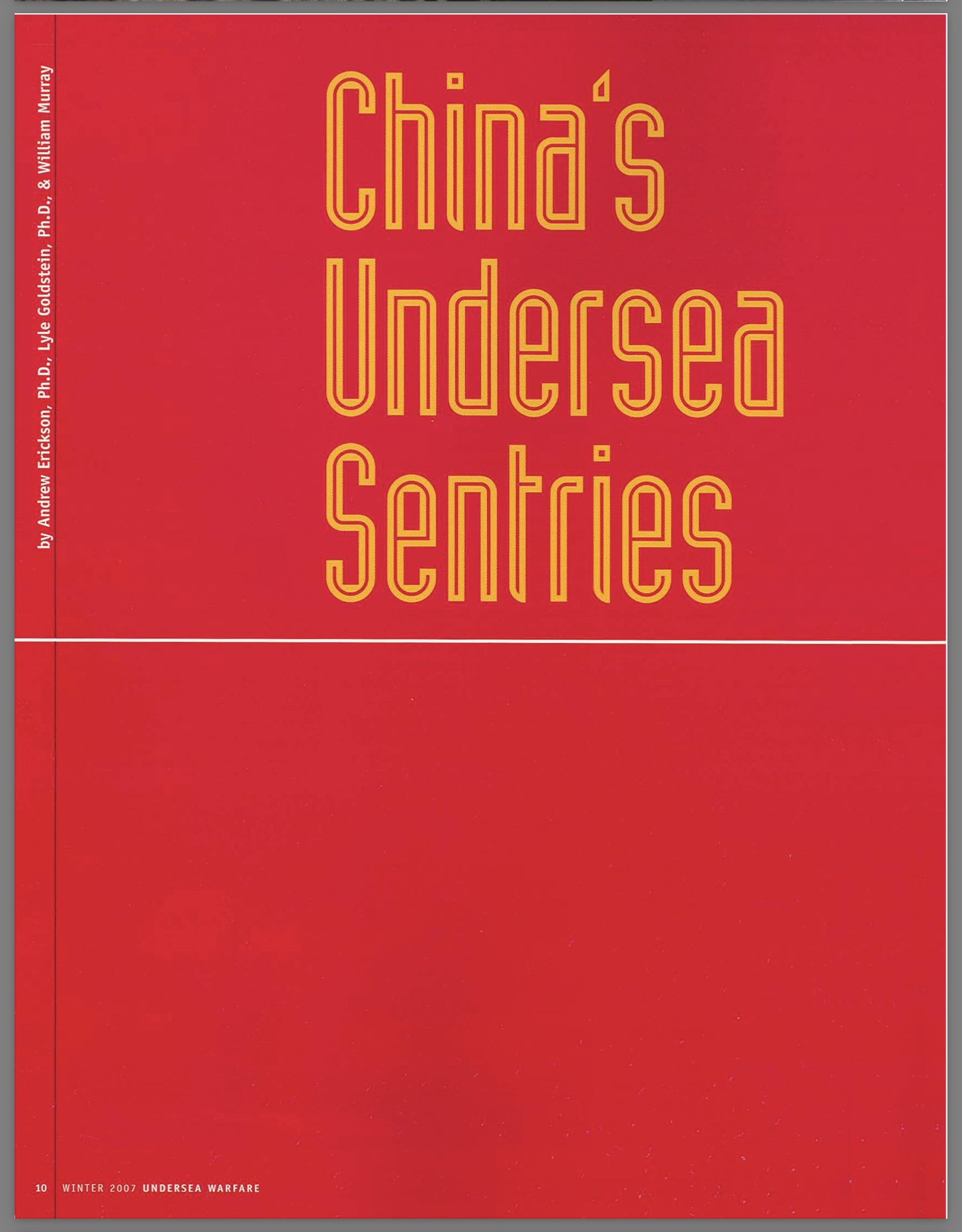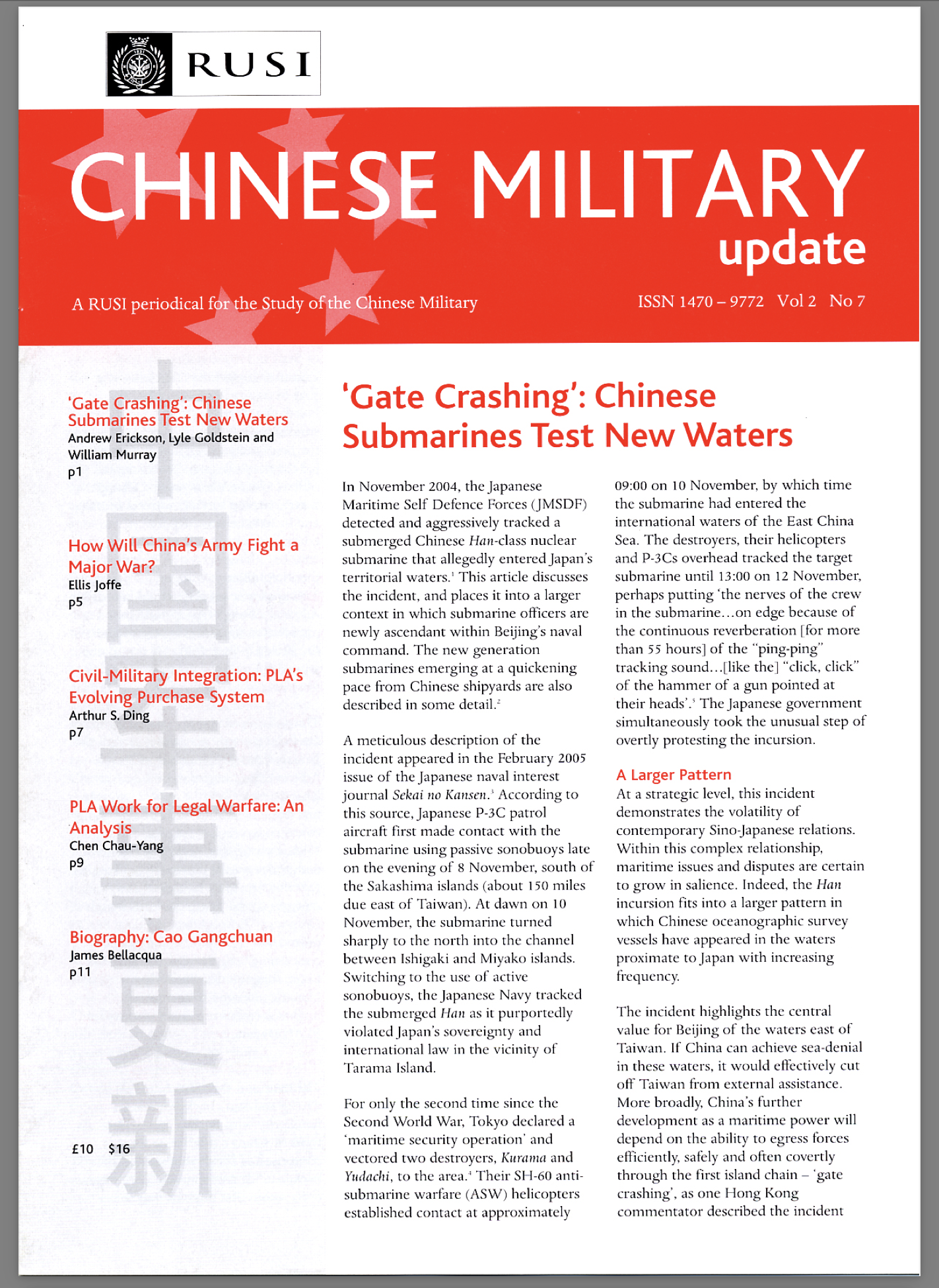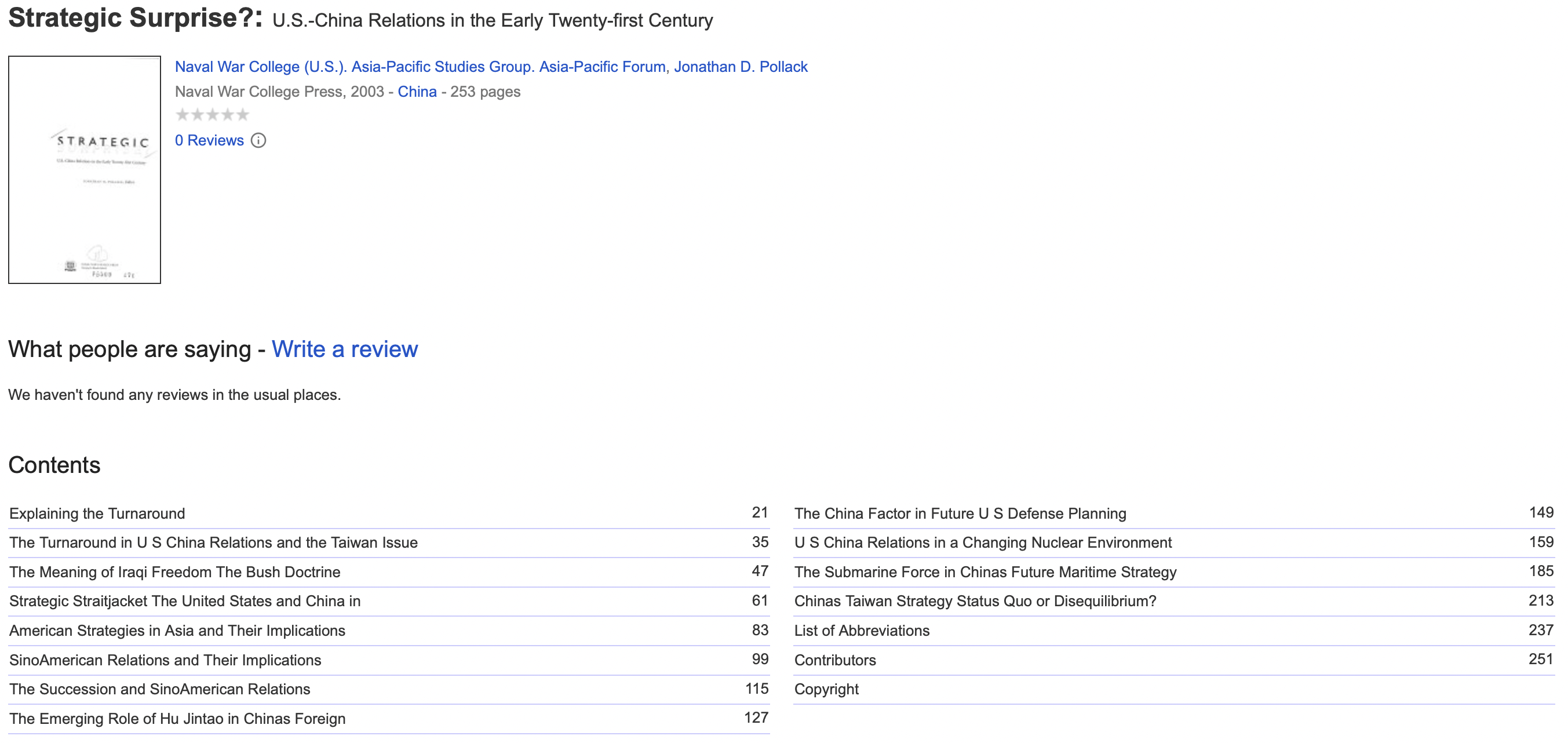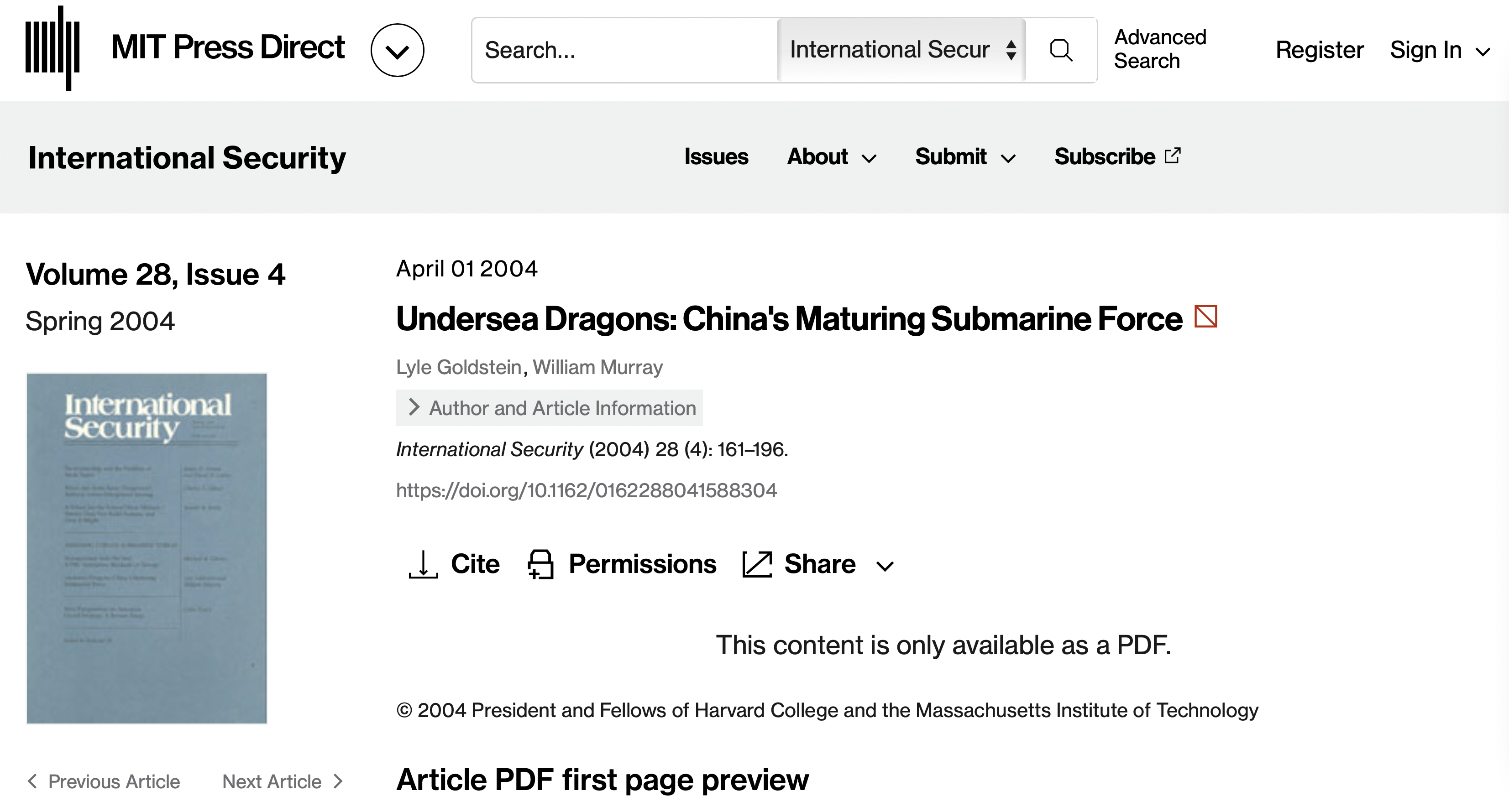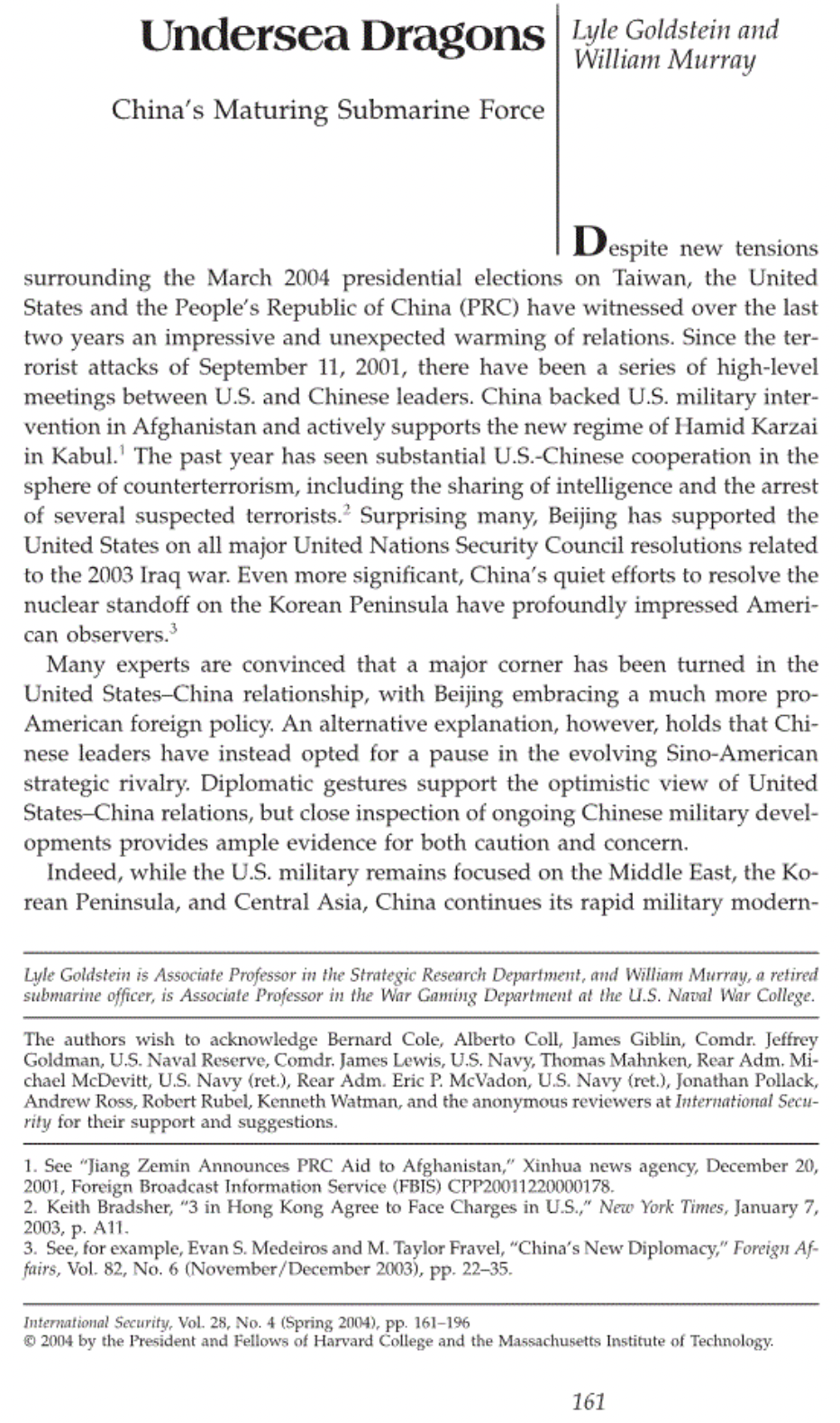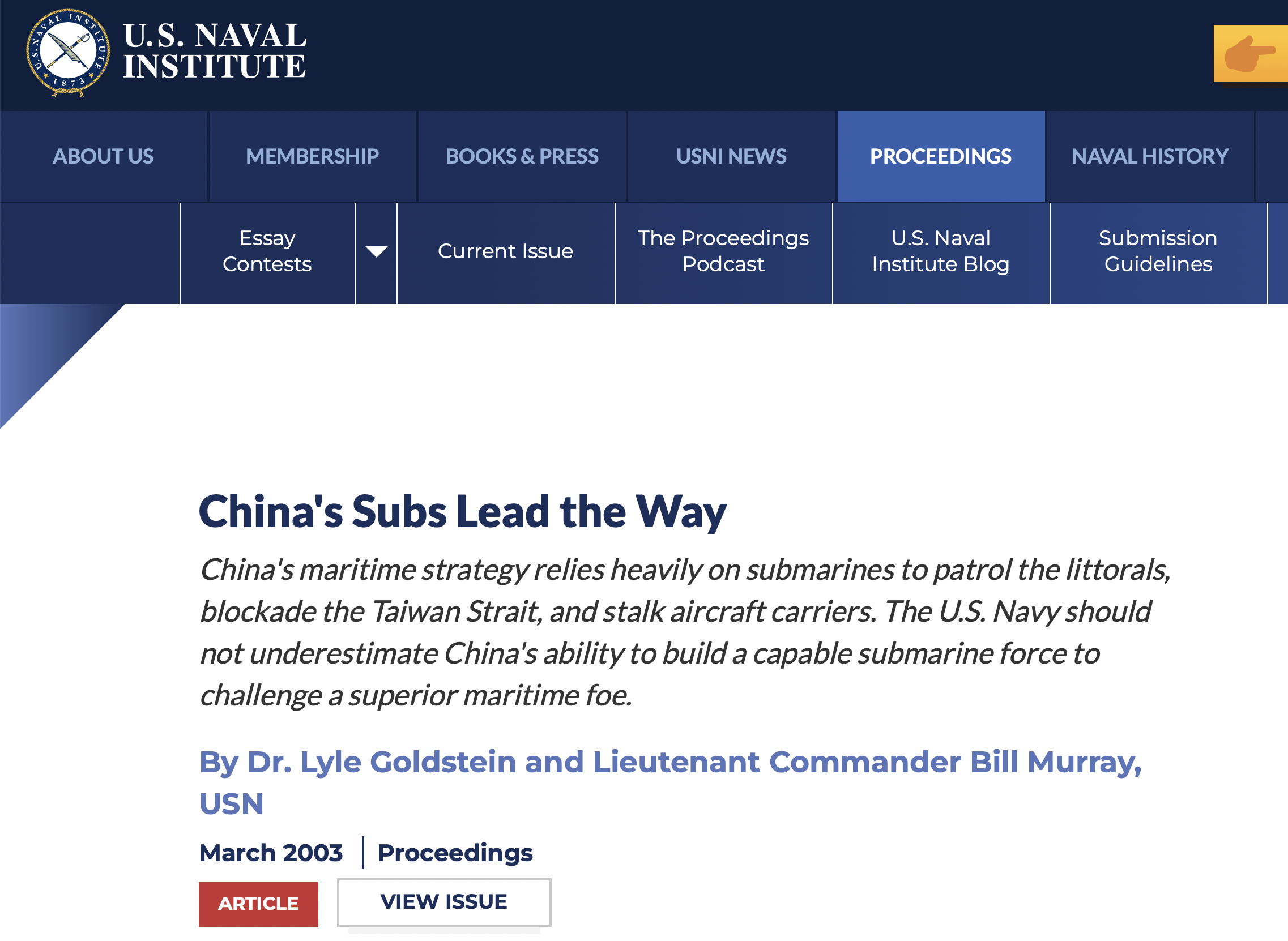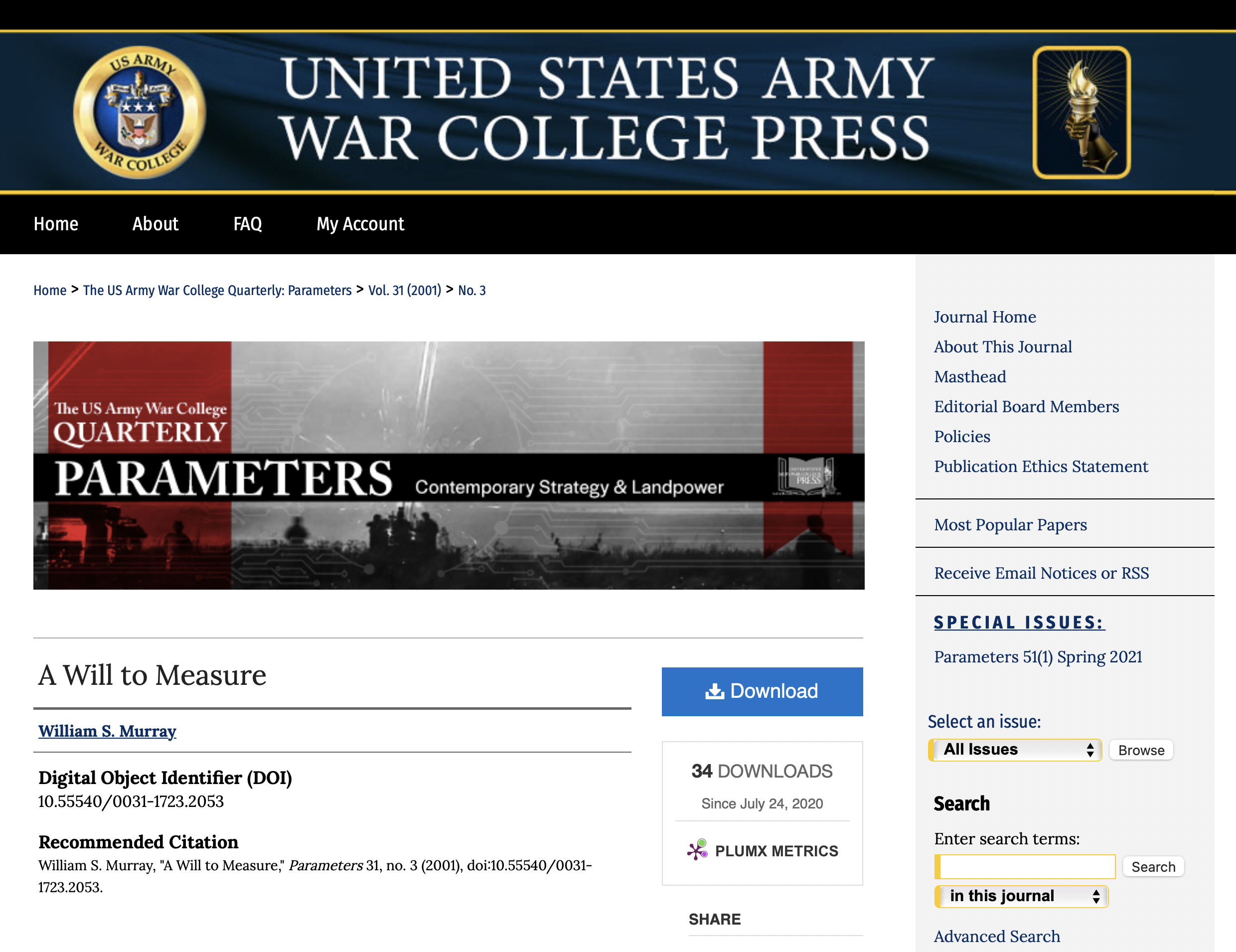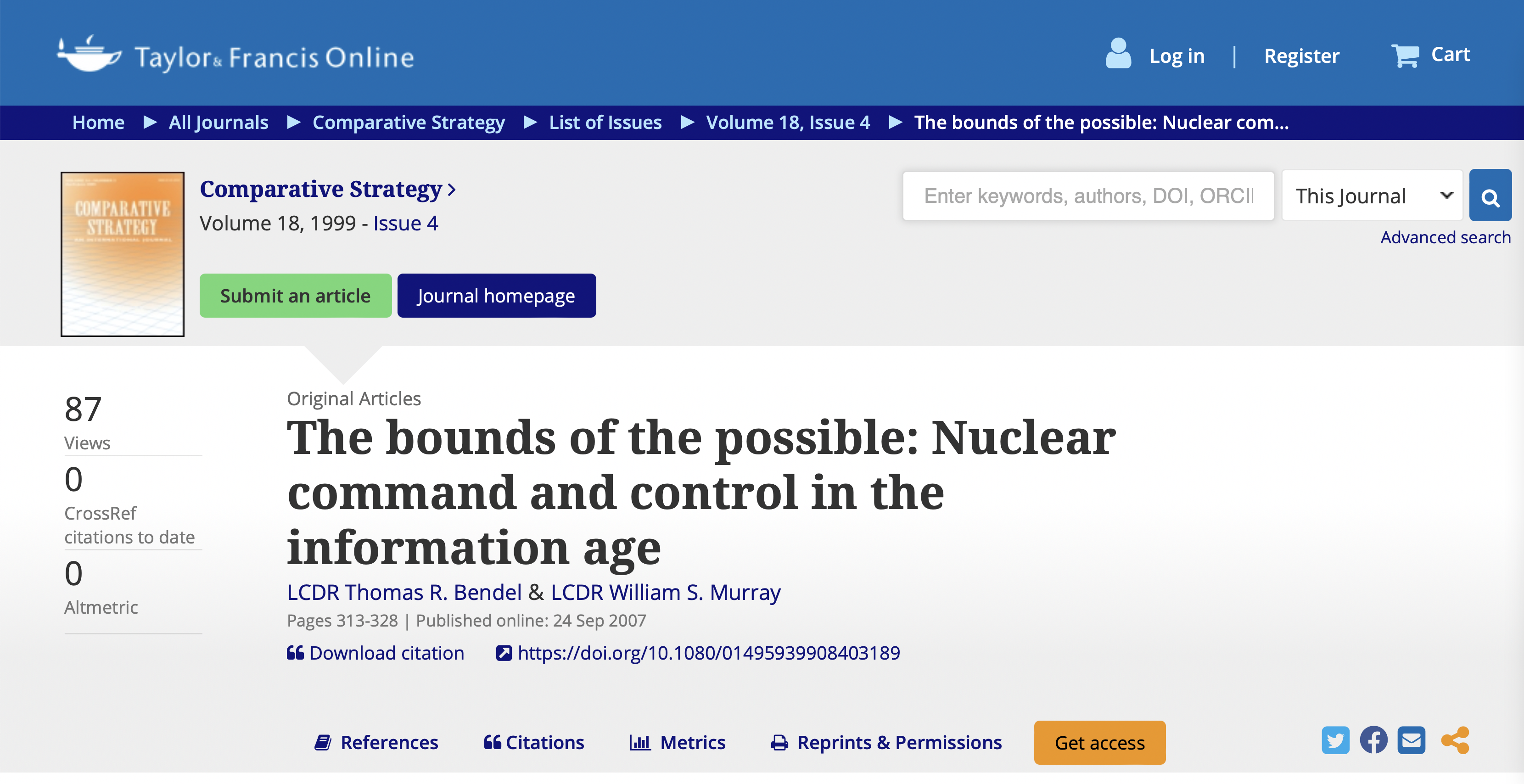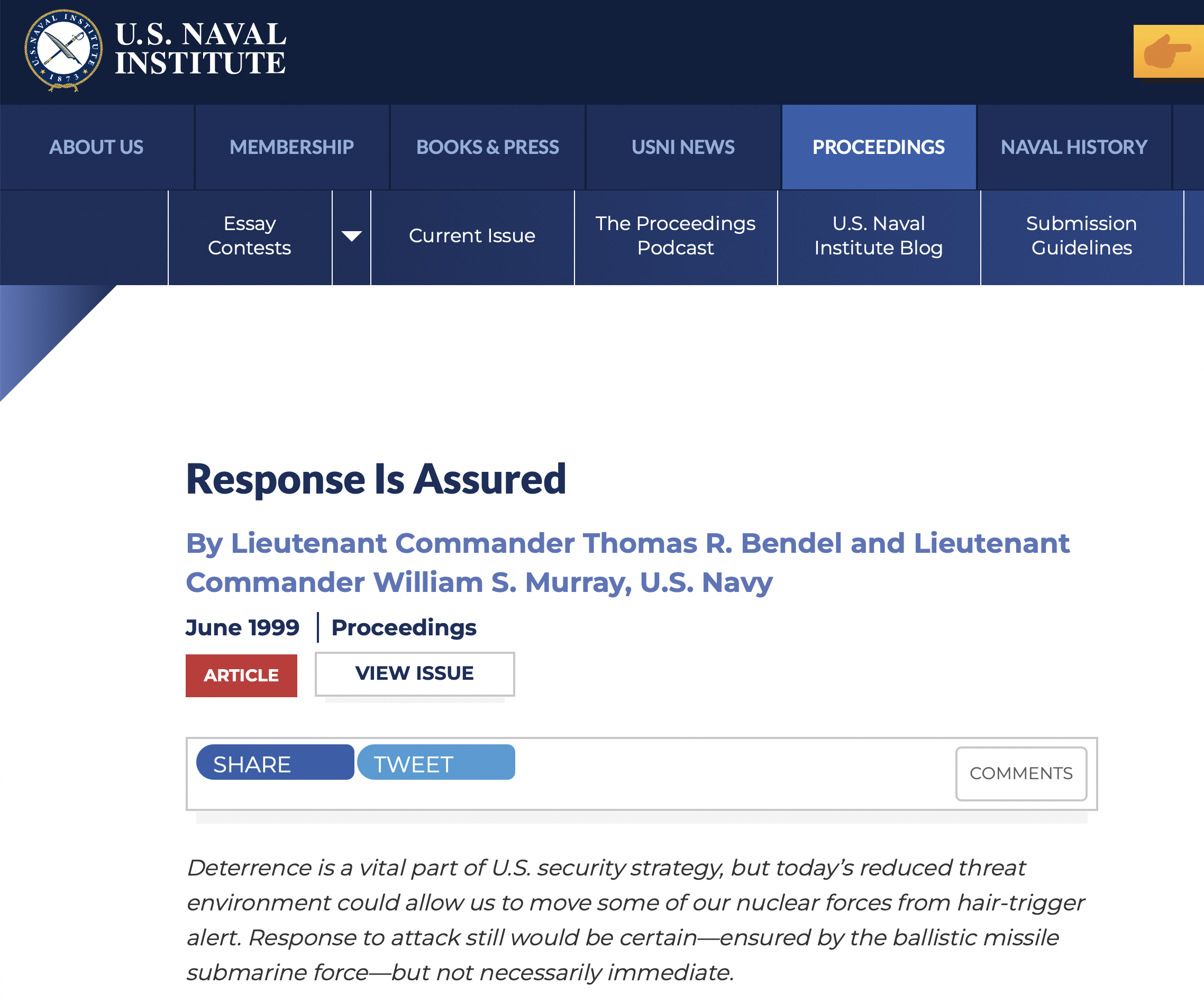The Prof. William Murray Bookshelf: Timely Insights into PLA Trends, Cross-Strait Dynamics & Taiwan’s Defense Options
U.S. Naval War College Professor William Murray’s scholarship on the military development and capacities of China and Taiwan is path-breaking, sobering, and thought-provoking. While others have worked hard to address these important issues, Prof. Murray’s scholarship is exemplary in its ability to distill complex and often misunderstood military operational issues to their essential dynamics based on his deep understanding of both key principles of physics and the technical parameters of the relevant weapons systems. Thanks to the importance of his insights and their grounding in enduring technological realities, Murray’s work has already had significant analytical and policy influence, and even his earlier publications remain extremely relevant today. It’s worth reviewing his farsighted early analyses of China’s naval, missile, and broader military development, which have stood the test of time. In particular, Murray’s seminal analysis on “Revisiting Taiwan’s Defense Strategy” gives him a place in the canon of Naval War College-related writings on deterrence since World War II. Links to and excerpts from this and Murray’s other major writings are available below. His entire corpus of Newport-based publications, including incisive book reviews, is available here. I commend Prof. Murray’s scholarship to anyone interested in these important and difficult issues. In these challenging times with so much at stake, it all merits a particularly careful read.
Professor William S. Murray is a tenured full professor in the Strategic & Operational Research Department and Director of the Halsey Bravo research effort at the U.S. Naval War College (NWC). He joined the U.S. Navy in 1983 immediately after graduating from the State University of New York at Buffalo with a B.S. in Electrical Engineering. Professor Murray served on, and qualified to command, nuclear-powered submarines. In 1994, he received a Master of Arts degree from NWC. Prof. Murray has served on the Operations staff at the U.S. Strategic Command. He retired from the Navy in 2003. He is a co-editor of the United States Naval Institute books China’s New Nuclear Submarine Force and China’s Energy Strategy: The Impact on Beijing’s Maritime Policies. He has published articles in International Security, the U.S. Army War College Parameters, the journal Comparative Strategy, the United States Naval Institute’s Proceedings, Jane’s Intelligence Review, Undersea Warfare, and the Naval War College Review.
William S. Murray, “Revisiting Taiwan’s Defense Strategy,” chapter ten in Robert C. Ayer, editor; with Jack Raymond, Colin S. Gray, Donald M. Snow, Edward J. Ohlert, Jerome J. Burke, George R. Lindsey, Hunter Stires, Sam Goldsmith, Jeffrey E. Kline, Wayne P. Hughes Jr., and William S. Murray, Deterrence: Selected Articles from the Naval War College Review, Newport Paper 46 (Newport, RI: Naval War College, 2022), 161–84.
The subject of deterrence fell away from the forefront of American strategic thinking during the three decades following the fall of the Soviet Union. Our ability to deter much weaker states by denying them the ability to achieve their aims was long assumed. But today there is a new global security situation that makes it imperative for American military officers and security specialists to begin to relearn the fundamental tenets of this aspect of national security.
The purpose of this volume is to contribute to that campaign of learning by drawing on some of the excellent scholarship published in the Naval War College Review during the Cold War and the decades since. Some of the articles included here lay out a few of the fundamentals of the theories of deterrence.
Original publication: William S. Murray, “Revisiting Taiwan’s Defense Strategy,” Naval War College Review 61.3 (Summer 2008): 13–38.
China’s recent military modernization has fundamentally altered Taiwan’s security options. New Chinese submarines, advanced surface-to-air missiles, and, especially, short-range ballistic and land-attack cruise missiles have greatly reduced Taiwan’s geographic advantage. Taipei can no longer expect to counter Chinese military strengths in a symmetrical manner, with Patriot interceptors, diesel submarines, surface warships, F-16 fighters, and P-3 maritime patrol aircraft. Taiwan must therefore rethink and redesign its defense strategy, emphasizing the asymmetrical advantage of being the defender, seeking to deny the People’s Republic its strategic objectives rather than attempting to destroy its weapons systems. This would enable Taipei to deter more effectively Beijing’s use of coercive force, would provide better means for Taiwan to resist Chinese attacks should deterrence fail, and would provide the United States additional time to determine whether intervening in a cross-strait conflict was in its own national interest. The strategy would also place the responsibility for Taiwan’s defense squarely on its own military. Finally, it would restore the United States to unambiguous compliance with the Taiwan Relations Act.
The People’s Republic of China (PRC) has been increasingly explicit about its military modernization objectives. China’s 2004 white paper on national defense stated that “the PLA [People’s Liberation Army] will . . . enhance the development of its operational strength with priority given to the Navy, Air Force and Second Artillery Force, and strengthen its comprehensive deterrence and warfighting capabilities.” The introduction of new classes of advanced surface warships; the unveiling of new nuclear-powered submarines, tactical fighter aircraft, and short- and medium-range ballistic missiles with advanced warheads; and an antisatellite demonstration—all attest to the determined pursuit of these goals. Many analysts believe that China’s near-term purposes are to deter Taiwan from declaring independence, to provide leverage by which to coerce a reunification with Taiwan if deterrence fails, and to inhibit or delay U.S. intervention in such a conflict.
Chinese employment strategies for these new weapons systems and potential capabilities remain unknown, though statements from senior leaders provide important hints. For example, President Hu Jintao is said to have stated in August 2007 that China had five major military priorities relative to Taiwan: establishing military readiness, conducting demonstrative exercises, “imposing a blockade on the Taiwan Strait,” “carrying out combined firepower attacks,” and “[conducting a] cross-sea landing.” Guo Boxiong, vice chairman of the Central Military Commission, boasted in March 2008, “We have the resolve and capability to deal with a major ‘Taiwan independence’ incident at any time.” The likely use of force would encompass three components: long-range precision bombardment, invasion, and blockade. These attack mechanisms would also likely be conducted in close coordination, not independently. Taiwan faces the daunting challenge of how best to deny China the fulfillment of these objectives.
Previous studies of potential China-Taiwan conflict scenarios have concluded that Taiwan (either acting alone or with the assistance of the U.S. military) could defeat PRC coercion, thus presumably ensuring reliable deterrence. Several of these studies have asserted that the Second Artillery (the PRC’s strategic rocket force) possessed only a limited inventory of relatively inaccurate short-range missiles with which to attack Taiwan, restricting its role to what Robert Pape calls “coercion by punishment,” terrorizing or inflicting pain on the population—a strategy that observers like Pape argue is rarely successful. These circumstances, however, have now changed profoundly. Over the past decade China has greatly enhanced its capacity to “reach” Taiwan with far more accurate and decisive capabilities, and recent analyses question Taiwan’s near-term ability to resist coercive force.
For example, the PRC’s expanding arsenal of increasingly accurate ballistic missiles can quickly, and with complete surprise, cripple or destroy high-value military assets, including aircraft on the ground and ships at piers. This emergent capability, plus the acquisition of long-range surface-to-air missiles (SAMs), suggests that the PRC has shifted its anti-Taiwan military strategy away from coercion by punishment toward denying Taiwan the use of its air force and navy. Taiwan therefore faces a threat against which it has not adequately prepared and that offers the PRC a real prospect of achieving success before the United States could intervene. This is a very worrisome development.
Taiwan’s responses to China’s enhanced capabilities remain highly conflicted, a situation that reflects the deep political disagreements that shape Taipei’s military policies. Taipei decreased its defense budgets in absolute and relative terms from1993 until 2003, with only meager improvements thereafter. These diminished efforts hardly seem commensurate with the increased threat that Taiwan confronts. They suggest either a state of denial about the threat, a gridlocked political system, misplaced faith in current systems and geographic advantages, or perhaps most disturbingly, a belief that the United States is certain to provide timely military assistance. Despite this ambivalence and its anemic defense budget, Taiwan has sought costly weapons systems from the United States, including PAC-3 (Patriot Advanced Capability, third version) missile systems, P-3 maritime patrol and F-16 fighter aircraft, Kidd-class destroyers, and diesel submarines. Taiwan is also reportedly attempting to develop offensive counterstrike capabilities indigenously, including the 360-mile-range Hsung-Feng IIE cruise missile.
Both approaches represent serious misperceptions of the threats posed to Taiwan and a misallocation of budgetary resources. The PAC-3s and other potential purchases are expensive, and they concentrate Taiwan’s defense dollars on a limited range of capabilities that China is increasingly able to defeat. Offensive counterstrike weapons, furthermore, are potentially destabilizing, since China would have difficulty determining if such strikes originated from American or Taiwanese platforms. They are also unlikely to be acquired in numbers sufficient to deter China.
More affordable, more effective, and less destabilizing means of defense against precision bombardment, invasion, and blockade are nonetheless available, but to take advantage of them, Taiwan must rethink its defense strategies. Rather than trying to destroy incoming ballistic missiles with costly PAC-3 SAMs, Taiwan should harden key facilities and build redundancies into critical infrastructure and processes so that it could absorb and survive a long-range precision bombardment. Rather than relying on its navy and air force (neither of which is likely to survive such an attack) to destroy an invasion force, Taiwan should concentrate on development of a professional standing army armed with mobile, short-range, defensive weapons. To withstand a prolonged blockade, Taiwan should stockpile critical supplies and build infrastructure that would allow it to attend to the needs of its citizens unassisted for an extended period. Finally, Taiwan should eschew destabilizing offensive capabilities, which could include, in their extreme form, tactical nuclear weapons employed in a countervalue manner, or less alarmingly, long-range conventional weapons aimed against such iconic targets as the Three Gorges Dam.
Such shifts constitute a “porcupine strategy.” They would offer Taiwan a way to resist PRC military coercion for weeks or months without presuming immediate U.S. intervention. This shift in strategy might also be less provocative to the PRC than Taiwan’s current policy of offensive defense. A porcupine strategy would enhance deterrence, in that a Taipei truly prepared to defend itself would be able to thwart a decapitation attempt—thereby discouraging Beijing from acting militarily. Perhaps most important, such a policy would allow the United States time to deliberate whether intervention was warranted. Washington could avoid a reflexive decision that would draw it into a war against a major power that had systematically prepared for just such a contingency for more than a decade.
This article has five principal parts. The first summarizes the history and rationale of the 2001 U.S. arms offer to Taiwan and explains why the weapons sales proposed are unsuited to the effective defense of the island. The second section outlines how China would probably attempt to destroy or neutralize the Taiwan air force and navy, and it proposes an alternative strategy for countering China’s increasingly precise short-range ballistic missiles (SRBMs), cruise missiles, and manned tactical aircraft. The third part explores how Beijing’s invasion options would change if Taipei lost its navy and the use of its air force. The fourth section examines PRC blockade options against Taiwan and suggests how Taiwan could more effectively deny China its blockade objectives. The concluding section considers the impediments to, and repercussions of, adoption by Taiwan of a “porcupine defense.” …. … …
William S. Murray, “The Return of Competent Adversaries (And Their Destabilizing Effects),” presentation at “Strengthening Global Maritime Partnerships,” Naval War College’s 15th Regional Alumni Symposium, Co-hosted with the Royal Navy of Oman, Muscat, Oman, 25 October 2017.
Naval Operations in the Pacific
- Advanced technology, long range, and higher costs
- Advanced cruise and ballistic missiles
- From Land, Aircraft, Ships, Submarines
- Sophisticated Surface-to-Air missiles
- Reliable Over-the-Horizon Targeting and C4ISR
- Operate from perceived sanctuary
- These weapons probably have excellent performance
- Employed in support of Maritime Objectives
Shared Characteristics
- Mobile and lethal
- As good or better then Western systems?
- Mutually reinforce
- All rely on effective, networked C4ISR
- All require accurate targeting
- All enabled by highly reliable, modern technology
- This technology is spreading
So What?
- Western Navies will be challenged to operate as they have since end of Cold War
- Naval operations will have to re-emphasize characteristics such as maneuver, stealth, and deception
- Nature of conventional deterrence seems to be shifting
- Diffusion of weapons technology encourages challengers to the status quo
Hard Truths
On a modern battlefield:
- Detected, Identified & C2 = attacked
- Offensive missiles can likely overcome defenses
- “Bullets” (missiles) vs. “bodies” (Aircraft, ships, airfields)
- Defense must be perfect, every time–a very high bar
- Modern ships and aircraft are very expensive
- Unclear how much damage they can suffer and retain combat effectiveness
Defensive, but Destabilizing
These approaches are:
- Defensive to those using them
- A strong conventional deterrent
…but
- Offensive to neighboring states
- Encourage regional aggression
- Embolden, rather than deter conflict
William S. Murray, “The Return of Competent Adversaries,” presentation at U.S. Naval War College’s 13th Regional Alumni Symposium, Garmisch-Partenkirchen, Germany, 14 April 2016.
GARMISCH-PARTENKIRCHEN, Germany (April 14, 2016) William S. Murray, professor of strategic and operational research at U.S. Naval War College (NWC) in Newport, Rhode Island, discusses anti-access/area-denial at NWC’s 13th Regional Alumni Symposium in Garmisch-Partenkirchen, Germany. The symposium is designed to further strengthen the U.S. Navy’s global maritime partnerships and continue the professional military education of the college’s international alumni. A total of 33 alumni from 24 European nations participated in the event.
William S. Murray, “Asymmetric Options for Taiwan’s Deterrence and Defense,” in Ming-chin Monique Chu and Scott L. Kastner, eds., Globalization and Security Relations across the Taiwan Strait: In the Shadow of China (New York: Routledge, 2015), 61–79.
An armed conflict between China and Taiwan remains possible despite the past six years’ improvements in cross-Strait relations. China’s military, which two decades ago essentially had no real capability to coerce Taiwan is now much more powerful both in absolute terms and relative to Taiwan, and continues a modernization program that is stunning in its rapidity and comprehensiveness. For China, Taiwan is nearly the foremost “core interest” over which it is unwilling to comprise, yet is willing to fight. Little good can be said about such a conflict. A best case in which fighting was limited and quickly ended would deepen and harden the wariness and mistrust of China in many East Asian states, and likely cause renewed arms races, exacerbated security dilemmas, and have negative effects on regional stability and trade. A longer war involving other Asian powers and potentially the United States would be commensurately worse, and could conceivably escalate to use of nuclear weapons.
How might such grim outcomes be avoided? … …
This begs the question of what instead, commensurate with the Taiwan Relations Act and other governing documents and agreements best help Taiwan and protect the United States’ interests. This paper answers that question, and offers some specific weapons recommendations as well as more general characteristics of weapons that could comprise an effective, affordable deterrent for Taiwan.
It is not clear what China could do that would effectively counter such a future Taiwan “Anti-Air Force” and an “Anti – Navy.” Beijing could develop a true joint expeditionary capability characterized by thoroughly- trained and exercised personnel, perfect communications, deep magazines of expensive weapons and large numbers of the craft that carry them, and a robust supporting logistics system. This would entail major Chinese shifts in military culture, including one away from conscripts toward a truly professional military, and the creation and employment of the doctrine necessary to conduct such intricately coordinated warfare. These steps, which to understate are difficult and expensive, may also ultimately prove ineffective because the possible Chinese measures outlined above do not change the fundamental physical imbalances that underpin this paper’s recommended strategy.
Small, mobile, dispersed lethal weapons systems will likely always be able to effectively hide in cluttered terrain and deliver lethal ordnance against targets that readily stand out against a background of empty sky or the ocean’s surface. China will always require air superiority as a precondition to hunting and killing such elusive Taiwan weapons or conducting an amphibious invasion, and Taiwan can always prevent or contest for air superiority with mobile SAMs that cost much less than modern aircraft. It is always better to be on the “bullet” end of a “bullet-vs.- body” competition. These realities offer Taiwan the basis for an enduring, affordable defensive strategy that can qualitatively make amphibious invasion and blockades less likely to succeed, or require China to develop and maintain vastly larger and more expensive forces than it currently has. An additional benefit is that the reduced likelihood of a successful PRC invasion or blockade reduces the probability of a preparatory precision bombardment as part of a combined campaign.
Thus the ideas in this paper have the potential to render much of China’s military modernization moot, at least as far as it applies to Taiwan, and thereby force China to develop and field an entirely new approach to militarily coerce Taiwan. This would take time, possibly decades. …
William S. Murray, “Anti-Access and Area Denial for Taiwan,” Testimony before Hearing on “China’s Relations with Taiwan and North Korea,” U.S.-China Economic and Security Review Commission, Washington, DC, 5 June 2014.
… Some systems useful for ASB probably should be bought in some numbers as part of normal military modernization, even if not to deter or fight China. Yet the magnitude of the costs the systems recommended by ASB advocates will probably preclude their acquisition. We should look for alternatives that can deter Chinese aggression.
One such option involves steps Taiwan can take regardless of U.S. action, to improve its defenses. Taipei faces the prospect (either singularly or in combination) of being subjected to a Chinese bombardment, a blockade, or an invasion. Taiwan’s air force and navy can no longer counter these threats, so Taipei ought to aggressively develop and field “asymmetrical forces,” such as I first described in a 2008 paper.
The key attributes of such forces would be:
- low costs relative to the Chinese forces they oppose;
- an ability to ride out a Chinese precision-munitions bombardment;
- and high effectiveness against Chinese forces attempting to blockade or invade Taiwan.
These weapons would survive by virtue of mobility, redundancy, hardening, deception, and large inventories made possibly by low relative costs. These attributes would make Taiwan’s defense difficult for China to overcome with long range precision strike weapons, and thereby make Taiwan far less susceptible to early defeat.
Transforming Taiwan’s military into such a survivable and lethal anti-force would:
- offset much of China’s force modernization by rendering specific classes of PRC ships and aircraft vulnerable to purpose-built Taiwan weapons;
- increase crisis stability by assuring Taiwan that, even if alone, it could withstand Chinese attack for extended periods;
- reduce the need for immediate US intervention and increase the probability that diplomatic pressure would persuade China to end its attack;
- provide the US more time to determine if intervention was necessary, and if so, to intervene in a measured, methodical way that played to US strengths;
- enhance cross-Strait deterrence by making Chinese victory more uncertain;
- prove more affordable to Taiwan than are current big-ticket, symmetrical weapons systems like F-16 fighters, warships, and ballistic missile defenses
- shift the financial burden of deterring a Chinese attack from the United States to Taiwan.
Many of the weapons systems appropriate for such a Taiwan force are unambiguously defensive and would therefore comply with the Taiwan Relations Act if made available to Taiwan by the United States. On the other hand, many of the weapons systems I recommend embody relatively simple technology. Taiwan could probably develop and manufacture many of them with little or no U.S. help.
I believe that Taiwan’s democracy is worth preserving. If U.S. and Taiwan policymakers agree, they need a new military response to China’s Taiwan-centric buildup. This new response must also account for Taiwan domestic politics, which have in recent years thwarted efforts to raise Taiwan’s defense expenditures. This paper offers workable solutions to address these realities. …
Developing Taiwan’s Anti-Access/Area Denial Force – Learn from China
Taiwan’s air force and much of its navy are likely no longer survivable during wartime. Yet Taipei needs the capacity to ride out bombardment, withstand a blockade, and to repel an invading amphibious fleet. In short, Taiwan needs to develop its own anti-access and area-denial forces.
Ironically, China provides example s of how to hold a determined, powerful adversary at bay. For example, China has developed and paraded in Beijing large numbers of truck-mounted, several hundred-km range YJ-62 ASCMs. Similar, (if shorter ranged), independently targetable truck mounted anti-ship cruise missiles—known as coastal defense cruise missiles (CDCMs), would help Taiwan prevent a Chinese invasion or counter a close blockade. Such systems’ mobility confers several important advantages. CDCMs can be dispersed and hidden among commercial fleets of similarly sized trucks, inside or behind large buildings, underneath overpasses, bridges or trees, inside tunnels, or protected inside hardened prepared firing positions, and then driven to firing locations near an amphibious landing. China would be hard-pressed to locate and positively identify such ASCM-carrying trucks, each of which, given adequate targeting data (described below) could independently destroy PLAN warships. This would call into question the ultimate success of the invasion or blockade. …
Large Numbers of Fast, Small, ASCM-equipped vessels and mines – Learn from Iran
Taiwan could gain a similar advantage by increasing the number of ASCMs it can deploy via high speed fast attack craft (FAC). Taiwan’s fleet of thirty 33 knot, 170-ton Kuang Hua missile patrol craft are said to carry four Hsiungfeng II ASCMS, and Taiwan recently unveiled the first of a proposed new class of anti-ship cruise missile carrying wave-piercing catamarans that may carry up to 16 ASCMs. These missile patrol craft all appear to be capable vessels, but the underlying concept can usefully be extended downward. Taiwan should consider the example of Iran’s Peykaap missile patrol craft. These vessels are approximately 57 feet long, displace some 15 tons, and can achieve speeds of about 52 knots. The U.S. Navy’s Office of Naval Intelligence states that the Peykaap is equipped with two Kowsar ASCM and with torpedoes, but recent statements and videos from Iran have identified the missile as a NASR-1, which the Israelis clarified in March 2011 as being an Iranian C-704 ASCM. This missile has a range of 35 km, carries a 128 kg warhead, and is guided by a radar seeker.
These or similar vessels’ small size makes them easier and cheaper to build, so Taiwan could produce large numbers of them indigenously. Small size would also permit the wartime use of ports of all sizes, making basing and logistics less vulnerable during combat. Taiwan could easily disperse and hide these lethal craft, making them much less susceptible to a Chinese SRBM surprise attack than is its current fleet. It is one thing to destroy 26 large warships that are on average 140 meters long and 15 meters wide, and that are concentrated in three major bases. It is quite another to destroy many tens of 15-by-5-meter fast missile patrol craft that can be in many dozens of ports, that can be stored in warehouses or hidden in other secure locations including purpose-built caves or hardened “pens,” and that can be launched nearly anywhere a crane and a flat-bed truck can reach. Such vessels could be sent on their attack mission individually or in groups with only rudimentary locating data, conduct extended searches with their own radars, develop final targeting data autonomously, deliver lethal ordnance from beyond effective counter-fire range, and escape at high speed to reload.
In wartime, Taiwan does not require and is unlikely to retain for long the enhanced range and endurance of frigates and destroyers. Instead, it needs to extend lethal combat power some tens of kilometers from its ports and beaches to make those waters untenable for intruding Chinese warships, including especially amphibious ships preparing to conduct an invasion. A fleet of Peykaap-like fast attack craft (FAC) armed with ASCMs would be able to provide and sustain that sort of at-sea firepower. …
The enduring utility of defensive mining
Taiwan can also use mines to counter a blockade and repel an invasion. As the nearly fatal damage the USS Samuel B. Roberts demonstrates, even primitive mines effectively threaten warships. In addition to being lethal, mines are also relatively inexpensive; can be emplaced by a large variety of ships, (and helicopters); are very difficult for opposing forces to detect and neutralize (especially in shallow waters); can be programmed to turn on or off under specified conditions; and can even be selective in their choice of targets. Minesweeping and mine hunting—the unavoidable countermeasures to mines—are laborious, time-consuming and expensive undertakings that require uncontested mastery of the mined waters and airspace above it. China is unlikely to be able to achieve such a dominance of waters critical for the invasion or blockade of Taiwan, and is notably weak in all aspects of naval mine clearance and removal.
Taiwan should vigorously exploit the PLAN’s vulnerability to mining; doing so confers significant advantages. Taiwan could develop and manufacture or obtain adequate mines relatively easily, and could store them in dispersed, hardened bunkers impervious to China’s missiles. Given strategic or even tactical warning Taiwan could quickly place defensive minefields offshore and along likely invasion beaches, and cover or protect those minefields from Chinese mine-clearance efforts with truck-mounted CDCMs. …
Make IADS mobile – learn from the Russians and Serbs
Taiwan should seek to preclude China from establishing air superiority, even after absorbing a bombardment that grounded or destroyed Taiwan’s Air Force. To this end, Taiwan should modernize its air defense network, and make it more survivable than it apparently is. It could do so by fielding a large number of modern, mobile short-ranged SAMs and by employing its Patriot missiles in as-mobile-a-manner as possible and devoting them to air instead of missile defense. I discuss these steps below.
Taiwan should obtain or develop and field highly lethal and mobile short range surface-to-air missile systems analogous to the Russian SA-15. This is a fully mobile, autonomous vehicle that can detect, track, and shoot relatively short-range SAMs at aircraft, cruise missiles, and even precision-guided bombs. Mobile systems such as the SA-15, the older SA-6, or the functionally similar US SLAMRAAM are point-defense weapons with ranges typically in the low-tens of kilometers. Offsetting such limited ranges are fast set-up and take-down times, mobility, and their ability to hide. These features make them survivable even in an extended conflict against a formidable adversary, as most Serbian mobile short-ranged SA-6 SAMs were against NATO aircraft in 1999. This results in a disproportionate effect by inducing hostile aircraft to fly above the effective missile altitude—some 6,000 meters for short-range missiles—wherever SAMs are thought to be, thus reducing attacking pilots’ ability to positively identify and accurately attack desired targets, especially those that are mobile. …
Recommendations for Congress
- Encourage Taiwan to develop or acquire, perhaps with US assistance, small, mobile, lethal weapons systems such as ASCM-equipped fast attack craft, truck-mounted coastal defense cruise missile, multiple-launch rocket systems, and short-range air defenses.
- Discourage further Taiwan development of offensive weapons systems such as land-attack cruise missiles. It is unlikely that Taipei can build enough such missiles to either deter Beijing or to significantly hamper a Chinese offensive against Taiwan.
- Encourage Taiwan to devote no less than 3% of its GDP to its defense.
- Craft arms exports to Taiwan so as to provide a more effective conventional deterrent, and to extend the amount of time Taiwan could withstand Chinese military force without immediate outside assistance.
William S. Murray, “Underwater TELs and China’s Antisubmarine Warfare: Evolving Strength and a Calculated Weakness,” in Peter A. Dutton, Andrew S. Erickson, and Ryan D. Martinson, eds., China’s Near Seas Combat Capabilities, Naval War College China Maritime Study 11 (February 2014), 17–29.
This edited volume explores China’s claims and capabilities within and around the ‘First Island Chain,’ the so-called ‘Near Seas.’ It assesses the rapidly evolving situations of concern in the Yellow Sea, the East China Sea, and South China Sea; and related capabilities, doctrinal development, and plausible scenarios. It concludes with discussion of possible U.S. Navy responses to China’s ‘Near Seas’ strategy.
Beijing’s impressive program of submarine force modernization suggests an expensive wager on that force’s enduring ability to accomplish vital near-seas missions in foreseeable military contingencies. Since the mid-1990s, China has launched or acquired more than thirty-five submarines, constituting five new classes of vessels; has essentially retired what had been its most numerous class of diesel-electric submarines (SSs); and has carved out of solid rock at Yalong Bay, on Hainan Island, an entirely new submarine base for new classes of nuclear-powered attack submarines (SSNs) and nuclear-powered ballistic-missile submarines (SSBNs).
This chapter will attempt to assess how China may intend to employ those new submarines. The conclusions drawn from this analysis are admittedly speculative, but they are based on facts and are internally reinforcing and coherent; also, they integrate well with what is known about other aspects of China’s antiaccess and area-denial forces. … …
Conclusion
Chinese military strategists appear to recognize that all quiet submarines, whether friendly or hostile, are unlikely to be operationally vulnerable to opposing forces. Beijing’s ongoing investment in increasingly modern (and therefore progressively quiet) antiship-cruise-missile-firing diesel submarines reflects a determination to overwhelm and destroy surface ships operating within at least a hundred miles of the shallow waters of the near seas, including Taiwan. This distance is greatly extended and reinforced by the DF-21D antiship ballistic missile and by antiship cruise missiles launched from surface warships and such aircraft as new variants of the H-6 bomber. PLA reliance on large numbers of ASCMs as a means of deterring and defeating opposing surface naval forces represents a significant challenge for a potential adversary, and it suggests specifically that the U.S. Navy’s post–Cold War ability to conduct high-volume, uncontested, maritime strike operations from surface warships in the western Pacific has ended, at least temporarily.
On the other hand, Beijing’s lack of modern ASW forces—such as maritime patrol aircraft, sub-hunting helicopters, low-frequency surface-ship sonars, and quiet nuclear attack submarines—suggests the PLAN will for some time continue to cede underwater mastery of the deep or distant ocean areas to the West. This may very well suggest a PLA calculated acceptance of losses to opposing SSNs in a Taiwan scenario and a lack of intent to conduct high-tech warfare, at least for the near term, in any distant sea. It would seem, therefore, to be in the military interest of the U.S. Navy to exploit its cur- rent underwater advantages. A logical implication could be an expansion of the types and numbers of weapons that could be launched from submarines.
Andrew S. Erickson, Lyle J. Goldstein, and William S. Murray, Chinese Mine Warfare: A PLA Navy ‘Assassin’s Mace’ Capability, Naval War College China Maritime Study 3 (June 2009).
While photos of a first Chinese aircraft carrier will no doubt cause a stir, the Chinese navy has in recent times focused much attention upon a decidedly more mundane and non-photogenic arena of naval warfare: sea mines. This focus has, in combination with other asymmetric forms of naval warfare, had a significant impact on the balance of power in East Asia. In tandem with submarine capabilities, it now seems that China is engaged in a significant effort to upgrade its mine warfare prowess. Submarines are large and difficult to hide, and various intelligence agencies of other powers are no doubt attuned to the scope and dimensions of these important developments. By contrast, mine warfare (MIW) capabilities are easily hidden and thus constitute a true “assassin’s mace” (杀手锏 or 撒手锏)—in the American metaphor, a “silver bullet” for the PLA Navy, a term some Chinese sources, including the PLAN itself, apply explicitly to MIW. Relying heavily on sea mines, the PLAN is already fully capable of blockading Taiwan and other crucial sea lines of communication in the western Pacific area. Indeed, sea mines, used to complement a variety of other capabilities, constitute a deadly serious challenge to U.S. naval power in East Asia.
This paper proceeds in ten steps. First, there is a discussion of the Persian Gulf War as a catalytic moment for contemporary Chinese MIW. A second section develops this context further with an account of the little-known history of Chinese MIW. The next two sections consist of detailed descriptions of the PLAN mine inventory and the various means of delivery. A fifth section addresses the human factor in Chinese MIW development, outlining recent training and exercise patterns. The following section offers a provisional outline of the PLAN’s evolving MIW doctrine. The seventh section brings prospective mine countermeasures (MCM) programs into the strategic equation, and the eighth discusses specific scenarios of concern, especially the Taiwan blockade scenario, aiming for a comprehensive net assessment of the MIW component in the future Asia-Pacific maritime security environment. The discussion of scenarios is followed by an evaluation of an alternative viewpoint concerning Chinese MIW potential. In the tenth, concluding, section, implications are discussed for U.S. defense and foreign policy.
William S. Murray, “Revisiting Taiwan’s Defense Strategy,” Naval War College Review 61.3 (Summer 2008): 13–38.
China’s recent military modernization has fundamentally altered Taiwan’s security options. New Chinese submarines, advanced surface-to-air missiles, and, especially, short-range ballistic and land-attack cruise missiles have greatly reduced Taiwan’s geographic advantage. Taipei can no longer expect to counter Chinese military strengths in a symmetrical manner, with Patriot interceptors, diesel submarines, surface warships, F-16 fighters, and P-3 maritime patrol aircraft. Taiwan must therefore rethink and redesign its defense strategy, emphasizing the asymmetrical advantage of being the defender, seeking to deny the People’s Republic its strategic objectives rather than attempting to destroy its weapons systems. This would enable Taipei to deter more effectively Beijing’s use of coercive force, would provide better means for Taiwan to resist Chinese attacks should deterrence fail, and would provide the United States additional time to determine whether intervening in a cross-strait conflict was in its own national interest. The strategy would also place the responsibility for Taiwan’s defense squarely on its own military. Finally, it would restore the United States to unambiguous compliance with the Taiwan Relations Act.
The People’s Republic of China (PRC) has been increasingly explicit about its military modernization objectives. China’s 2004 white paper on national defense stated that “the PLA [People’s Liberation Army] will . . . enhance the development of its operational strength with priority given to the Navy, Air Force and Second Artillery Force, and strengthen its comprehensive deterrence and warfighting capabilities.” The introduction of new classes of advanced surface warships; the unveiling of new nuclear-powered submarines, tactical fighter aircraft, and short- and medium-range ballistic missiles with advanced warheads; and an antisatellite demonstration—all attest to the determined pursuit of these goals. Many analysts believe that China’s near-term purposes are to deter Taiwan from declaring independence, to provide leverage by which to coerce a reunification with Taiwan if deterrence fails, and to inhibit or delay U.S. intervention in such a conflict.
Chinese employment strategies for these new weapons systems and potential capabilities remain unknown, though statements from senior leaders provide important hints. For example, President Hu Jintao is said to have stated in August 2007 that China had five major military priorities relative to Taiwan: establishing military readiness, conducting demonstrative exercises, “imposing a blockade on the Taiwan Strait,” “carrying out combined firepower attacks,” and “[conducting a] cross-sea landing.” Guo Boxiong, vice chairman of the Central Military Commission, boasted in March 2008, “We have the resolve and capability to deal with a major ‘Taiwan independence’ incident at any time.” The likely use of force would encompass three components: long-range precision bombardment, invasion, and blockade. These attack mechanisms would also likely be conducted in close coordination, not independently. Taiwan faces the daunting challenge of how best to deny China the fulfillment of these objectives.
Previous studies of potential China-Taiwan conflict scenarios have concluded that Taiwan (either acting alone or with the assistance of the U.S. military) could defeat PRC coercion, thus presumably ensuring reliable deterrence. Several of these studies have asserted that the Second Artillery (the PRC’s strategic rocket force) possessed only a limited inventory of relatively inaccurate short-range missiles with which to attack Taiwan, restricting its role to what Robert Pape calls “coercion by punishment,” terrorizing or inflicting pain on the population—a strategy that observers like Pape argue is rarely successful. These circumstances, however, have now changed profoundly. Over the past decade China has greatly enhanced its capacity to “reach” Taiwan with far more accurate and decisive capabilities, and recent analyses question Taiwan’s near-term ability to resist coercive force.
For example, the PRC’s expanding arsenal of increasingly accurate ballistic missiles can quickly, and with complete surprise, cripple or destroy high-value military assets, including aircraft on the ground and ships at piers. This emergent capability, plus the acquisition of long-range surface-to-air missiles (SAMs), suggests that the PRC has shifted its anti-Taiwan military strategy away from coercion by punishment toward denying Taiwan the use of its air force and navy. Taiwan therefore faces a threat against which it has not adequately prepared and that offers the PRC a real prospect of achieving success before the United States could intervene. This is a very worrisome development.
Taiwan’s responses to China’s enhanced capabilities remain highly conflicted, a situation that reflects the deep political disagreements that shape Taipei’s military policies. Taipei decreased its defense budgets in absolute and relative terms from1993 until 2003, with only meager improvements thereafter. These diminished efforts hardly seem commensurate with the increased threat that Taiwan confronts. They suggest either a state of denial about the threat, a gridlocked political system, misplaced faith in current systems and geographic advantages, or perhaps most disturbingly, a belief that the United States is certain to provide timely military assistance. Despite this ambivalence and its anemic defense budget, Taiwan has sought costly weapons systems from the United States, including PAC-3 (Patriot Advanced Capability, third version) missile systems, P-3 maritime patrol and F-16 fighter aircraft, Kidd-class destroyers, and diesel submarines. Taiwan is also reportedly attempting to develop offensive counterstrike capabilities indigenously, including the 360-mile-range Hsung-Feng IIE cruise missile.
Both approaches represent serious misperceptions of the threats posed to Taiwan and a misallocation of budgetary resources. The PAC-3s and other potential purchases are expensive, and they concentrate Taiwan’s defense dollars on a limited range of capabilities that China is increasingly able to defeat. Offensive counterstrike weapons, furthermore, are potentially destabilizing, since China would have difficulty determining if such strikes originated from American or Taiwanese platforms. They are also unlikely to be acquired in numbers sufficient to deter China.
More affordable, more effective, and less destabilizing means of defense against precision bombardment, invasion, and blockade are nonetheless available, but to take advantage of them, Taiwan must rethink its defense strategies. Rather than trying to destroy incoming ballistic missiles with costly PAC-3 SAMs, Taiwan should harden key facilities and build redundancies into critical infrastructure and processes so that it could absorb and survive a long-range precision bombardment. Rather than relying on its navy and air force (neither of which is likely to survive such an attack) to destroy an invasion force, Taiwan should concentrate on development of a professional standing army armed with mobile, short-range, defensive weapons. To withstand a prolonged blockade, Taiwan should stockpile critical supplies and build infrastructure that would allow it to attend to the needs of its citizens unassisted for an extended period. Finally, Taiwan should eschew destabilizing offensive capabilities, which could include, in their extreme form, tactical nuclear weapons employed in a countervalue manner, or less alarmingly, long-range conventional weapons aimed against such iconic targets as the Three Gorges Dam.
Such shifts constitute a “porcupine strategy.” They would offer Taiwan a way to resist PRC military coercion for weeks or months without presuming immediate U.S. intervention. This shift in strategy might also be less provocative to the PRC than Taiwan’s current policy of offensive defense. A porcupine strategy would enhance deterrence, in that a Taipei truly prepared to defend itself would be able to thwart a decapitation attempt—thereby discouraging Beijing from acting militarily. Perhaps most important, such a policy would allow the United States time to deliberate whether intervention was warranted. Washington could avoid a reflexive decision that would draw it into a war against a major power that had systematically prepared for just such a contingency for more than a decade.
This article has five principal parts. The first summarizes the history and rationale of the 2001 U.S. arms offer to Taiwan and explains why the weapons sales proposed are unsuited to the effective defense of the island. The second section outlines how China would probably attempt to destroy or neutralize the Taiwan air force and navy, and it proposes an alternative strategy for countering China’s increasingly precise short-range ballistic missiles (SRBMs), cruise missiles, and manned tactical aircraft. The third part explores how Beijing’s invasion options would change if Taipei lost its navy and the use of its air force. The fourth section examines PRC blockade options against Taiwan and suggests how Taiwan could more effectively deny China its blockade objectives. The concluding section considers the impediments to, and repercussions of, adoption by Taiwan of a “porcupine defense.” …. … …
Gabriel B. Collins, Andrew S. Erickson, Lyle J. Goldstein, and William S. Murray, eds., China’s Energy Strategy: The Impact on Beijing’s Maritime Policies (Annapolis, MD: Naval Institute Press, 2008).
- Gabriel B. Collins, Andrew S. Erickson, Lyle J. Goldstein, and William S. Murray, “Introduction,” xi–xix.
China’s rapid growth has prompted Beijing to undertake an aggressive search for resources on a truly global scale. The resource most directly tied to continued growth in China is energy. Rising consumer appetites in China, coupled with occasional rolling blackouts due to spiraling demand in Chinese cities, have prompted intense anxieties in China concerning energy security. Since 80 percent of Chinese fossil fuel imports pass by ship through the Malacca Strait, an important component of Beijing’s concerns have come to be known in China as the “Malacca Dilemma.” This book draws on America’s finest experts in the fields of economics, energy, China studies, and naval strategy in order to explore China’s “Malacca Dilemma” and its implications for global maritime security.
The essays in this volume draw from a wide variety of viewpoints, but a central theme of the analyses is that the United States needs to be concerned that China is drawing upon much of the world’s remaining oil reserves for its exclusive use. The resulting competition for this diminishing resource could lead to energy insecurity and may support other tendencies toward rivalry that in turn could foster a naval arms race neither side seeks. One of the major conclusions of this study is that there is, in fact, ample room for Sino-American energy dialogue and cooperation in the maritime domain and that the competition for limited energy sources like oil need not lead to conflict.
The book’s authors are all authorities in their fields; many of the contributors are frequent advisers to major oil, shipping, and other multinational corporations, as well as governments. As a result, this volume takes into account an unprecedented range of influences and factors befitting such an important and complicated topic.
This is the second book in the series “Studies in Chinese Maritime Development” published jointly by the China Maritime Studies Institute and the Naval Institute Press.
Information on Chinese-language edition:
[美] 加布里埃尔·B.柯林斯 [Gabriel B. Collins], 安德鲁·S.埃里克森 [Andrew S. Erickson], 莱尔·J.戈尔茨坦 [Lyle J. Goldstein], 威廉·S.默里 [William S. Murray], 编者[Editors]; 李少彦 [Li Shaoyan], 姜代超 [Jiang Daichao], 薛放 [Xue Fang], 刘宏伟 [Liu Hongwei], 译者[Translators]; 中国能源战略对海洋政策的影响 [China’s Energy Strategy: The Impact on Beijing’s Maritime Policies], 海洋战略与海洋强国论丛 [Maritime Strategy and Maritime Great Power Forum Series], 十二五国家重点出版物出版规划项目 [Twelfth Five-Year Guideline State Key Publications Planning Initiative] (Beijing: 海洋出版社 [Ocean Press], 2015).
Gabriel B. Collins and William S. Murray, “No Oil for the Lamps of China?” Naval War College Review 61.2 (Spring 2008): 79–95.
The ubiquitous Made in China stickers and labels on consumer products remind us daily of China’s incredible economic rise. The world is accustomed to this powerful phenomenon and seems to expect that China’s economy will grow at 10 percent annually for at least another decade. Such remarkable economic progress has lifted millions of Chinese out of poverty and also substantially benefited the global economy. It is also arguably the cornerstone of Chinese Communist Party legitimacy.
Western and Asian hunger for inexpensive Chinese goods fuels much of this growth, but China’s economic engine cannot run without imports of raw materials, such as bauxite, iron ore, timber, and, perhaps most significantly, crude oil. Once a significant exporter, China became a net importer of crude in 1993 and now struggles to deal with this dependency.
Chinese security analysts fear that oil import dependency is a potential pressure point that could be exploited by future adversaries of the People’s Republic of China (PRC). Approximately 80 percent of China’s 3.3 million barrels per day (bpd) in crude oil imports passes through the Straits of Malacca. Such funneling could facilitate interdiction of China’s oil lifeline in times of crisis. The United States, India, and Japan are all seen as potential blockaders, but Chinese observers appear to believe that only the United States has both the capability and the will to blockade oil shipments to China. One recent Chinese article postulates that the most likely triggers of an oil blockade of China include a fight over Taiwan and a situation in which China’s rise becomes hostile and directly threatening to other major powers.
Some Chinese analysts argue that the need to protect shipments of oil and other vital raw materials is a key driver behind the PRC’s intensive aerial and naval modernization programs. Yet despite impressive improvements, the People’s Liberation Army Navy (PLAN) lacks the ability to defend the sea lines of communication (SLOCs) over which Chinese oil supplies flow. Among other limitations, the PLAN lacks guaranteed access to ports for refueling, repairing, and replenishing as well as adequate numbers of at-sea-replenishment vessels necessary to support long-range missions. More fundamentally, the PLAN rarely undertakes long-distance operations, which would provide vital training and experience for SLOC-protection missions.
In contrast, some of Beijing’s potential adversaries have decades of blue-water experience, world-class logistical capacity, global access to replenishment ports, and doctrine and equipment oriented toward warfare on the high seas. Beijing’s strategists recognize this disparity and are presumably devising plans to counter any possible future efforts to cut China’s petroleum umbilical cord.
This article examines potential Chinese responses to possible forms of energy blockade. The first two sections discuss how a distant blockade might be conducted and surveys possible Chinese responses to such an action. The third section hypothesizes a close blockade and then analyzes potential courses of action in response. The fourth section examines the possibility of a “blockade by convoy,” while the final section considers an energy-denial strategy that would target China’s ability to transport and process crude oil.
The authors conclude that an energy blockade of China would not only fail to achieve its objective but also send destructive shock waves through the global economic and political landscape. Frankly discussing energy sea-lane security will, ideally, promote trust and lay a foundation for deeper energy security cooperation between China and other major oil consumers. … … …
Andrew S. Erickson, Gabriel B. Collins, Lyle J. Goldstein, and William S. Murray, “Chinese Evaluations of the U.S. Navy Submarine Force,” Naval War College Review 61.1 (Winter 2008): 68–86.
Republished as a two-part series:
- Gabriel B. Collins, Andrew S. Erickson, Lyle J. Goldstein, and William S. Murray, “Capability Analysis: Chinese Evaluations of the U.S. Navy Submarine Force, Pt. 1,” Center for International Maritime Security (CIMSEC), 29 October 2018.
- Gabriel B. Collins, Andrew S. Erickson, Lyle J. Goldstein, and William S. Murray, “Capability Analysis: Chinese Evaluations of the U.S. Navy Submarine Force, Pt. 2,” Center for International Maritime Security (CIMSEC), 6 November 2018.
Perhaps partly inspired by the great successes of the U.S. submarine force, navies around the world have invested heavily in undersea warfare, especially in submarine capabilities. China stands out among these as an emerging submarine power. Over the last decade, Beijing has been building four different classes of boats while importing the Kilo-class diesel submarine from Russia in large numbers. Indeed, China’s intense focus on undersea warfare has led some to speculate that a transpacific rivalry is already under way, at least with respect to submarine capabilities. As policy makers in Washington grapple with the challenge of China’s rise, therefore, it may be wise to consider how Beijing is approaching its evolving naval strategy dilemmas.
This article examines Chinese views of the American submarine force. As that submarine force constitutes one of the most vital elements of Washington’s overall strategy for establishing and maintaining sea control in times of conflict, Beijing’s assessment of those capabilities may be critical to uncovering the future evolution of this nascent rivalry. The U.S. Navy submarine force is thought to represent a key capability for conflict scenarios involving China. This part of the U.S. Navy has undertaken major efforts at transformation within a new geostrategic and technological environment. The American submarine force represents a rather well-defined warfare area and thus lends itself to a bounded research effort.
Overall, this article finds that Chinese naval analysts study the U.S. submarine force in excruciating detail, as concretely manifested in thousands of both strategic and technical articles that focus on it. Such assessments underline the importance of a closer examination of Chinese perspectives concerning the American submarine force. … … …
Lyle Goldstein and William Murray, “International Submarine Rescue Efforts: A Constructive Role for China?” Asia Policy 5 (January 2008): 167–83.
This article highlights the opportunity available for the Chinese navy to participate in international efforts to improve and coordinate cooperation in the rescue of disabled submarines.
Main findings
- Submarine accidents that leave vessels disabled and crews trapped underwater are a common risk facing all navies with submarine fleets. International cooperation on rescue efforts is often necessary to ensure that the equipment and personnel necessary for a successful rescue are able to reach a disabled submarine in time to rescue its crew.
- China’s submarine rescue capabilities are modest, especially relative to the country’s increasingly modern submarine force, and the PLA Navy now recognizes the need to increase modernization efforts in this area.
- Many nations now regularly practice multilateral rescue exercises and coordinate their capabilities through the International Submarine Escape and Rescue Liaison Office (ISMERLO). Though a member of ISMERLO, China could become much more active in this organization by taking several steps to increase and improve participation in international rescue cooperative mechanisms.
Policy implications
The institutionalized contacts and increased transparency engendered by such cooperation in submarine rescue would fit with broader trends toward increasing openness and participation in international organizations by the Chinese military and could constitute an important confidence-building mechanism between China and the region. … … …
William S. Murray, “An Overview of the PLAN Submarine Force,” in Andrew S. Erickson, Lyle J. Goldstein, William S. Murray, and Andrew R. Wilson, eds., China’s Future Nuclear Submarine Force (Annapolis, MD: Naval Institute Press, 2007), 59–76.
Information on Chinese-language edition:
[美] 安德鲁·S·埃里克森 [Andrew S. Erickson], 莱尔·J·戈尔茨坦 [Lyle J. Goldstein], 威廉·S·默里 [William S. Murray], 安德鲁·R·威尔逊 [Andrew R. Wilson], (编者) [Editors]; 刘宏伟 (译者) [Translator]; 中国未来核潜艇力量 [China’s Future Nuclear Submarine Force], 海洋战略与海洋强国论丛 [Maritime Strategy and Maritime Great Power Forum Series], 十二五国家重点出版物出版规划项目 [Twelfth Five-Year Guideline State Key Publications Planning Initiative], (Beijing: 海洋出版社 [Ocean Press], 2015).
Of all the navies that operate submarines, only Russia and China build and employ both nuclear and diesel submarines as fighting ships. This peculiarity is rather easily explained. Russia’s submarine fleet is little more than a Cold War artifact, built to help defend the Soviet SSBN bastions. Speaking simplistically, diesel submarines would patrol and defend the approaches relatively close to the motherland, whereas the nuclear ballistic-missile submarines would conduct deterrent patrols in bastions such as the Barents Sea and the Sea of Okhotsk. SSNs would conduct operations against adversary SSNs, SSBNs and carrier battle groups at greater distances from Russia. The Soviet Union saw separate roles, and hence strategic requirements, for each type of vessel.
Similarly, the composition of China’s submarine force stems from strategic demands. Deployed in the adjacent, shallow waters of the Yellow and South China Seas, Beijing’s large fleet of diesel submarines was reasonably well suited to the role of opposing foreign invasion. These aging, unsophisticated, Soviet designed vessels were inexpensive, and could be built with relatively unskilled labor. Much more expensive, but somewhat more capable, are China’s handful of first-generation nuclear submarines. Though limited in capability against modern forces, they have served China as symbols of national prestige. is legacy eet suited the China of the 1960s through the 1990s well, but was inadequate for responding to Taiwan contingencies in the contemporary strategic environment.
Consequently, China’s submarine force has undergone a remarkable metamorphosis in the last decade. Domestic and imported modern diesel submarines are replacing older vessels, and China’s solitary nuclear shipyard is building two new classes of nuclear submarines. All of these vessels are far more modern and capable than were the vessels they are replacing. This aggressive program of modernization mirrors similar changes occurring within the PLAN surface fleet, within the 2nd Artillery rocket forces, and within the People’s Liberation Army Naval Air Force (PLANAF) and People’s Liberation Army Air Force (PLAAF). It is a time of great change for the PLAN, constituting a tremendous technological leap forward for the Chinese submarine force. This chapter establishes a full context for our understanding of Chinese nuclear submarine development by surveying both diesel and the nuclear components of the PLAN submarine force, focusing on the developing relationship and also on the critical tradeoffs between these respective parts of China’s growing undersea warfare capabilities. … … …
Andrew S. Erickson, Lyle J. Goldstein, and William S. Murray, “China’s ‘Undersea Sentries’: Sea Mines Constitute Lead Element of PLA Navy’s ASW,” Undersea Warfare 9 (Winter 2007): 10–15.
Traditionally a continental power, Beijing has not wielded strong naval forces in the modern era. But this is beginning to change now and China is making rapid strides, particularly in the arena of undersea warfare. According to the New York Times, China launched 13 submarines during the period 2002-04—and this number does not include the recent sale of eight Kilo-class diesels from Russia that was accomplished by 2006. Indeed, China commissioned thirty-one new submarines between 1995 and 2005. Less well understood by naval analysts and planners is the People’s Liberation Army (PLA) Navy’s dynamic mine warfare component. It is important to understand this emerging capability, because sea mines appear to be a big component of Beijing’s Anti-Submarine Warfare (ASW) strategy.
This article is part of a larger study that surveyed nearly one thousand Chinese language articles related to mine warfare. The major conclusions of that study are that China’s naval mine inventory likely contains some of the world’s most lethal systems and that Beijing may be on the cutting edge of mine warfare (MIW) technology and concept development. The study elucidates a preliminary outline of a Chinese MIW doctrine that emphasizes speed, psychology, obfuscation, a mix of old and new technologies, and a variety of deployment methods that target very specific U.S. Navy platforms and doctrines. Two research questions from that larger study are explored in this article: first, what is China’s potential capability and its ramifications? Second, how is the PLA Navy exploring the linkage between submarines and mine warfare to create new and significant operational capabilities? … … …
Andrew S. Erickson, Lyle J. Goldstein, and William S. Murray, “‘Gate Crashing’: China’s Submarine Force Tests New Waters,” Chinese Military Update 2.7 (April 2005): 1–4.
In November 2004, the Japanese Maritime Self Defense Forces (JMSDF) detected and aggressively tracked a submerged Chinese Han-class nuclear submarine that allegedly entered Japan’s territorial waters. This article discusses the incident, and places it into a larger context in which submarine officers are newly ascendant within Beijing’s naval command. The new generation submarines emerging at a quickening pace from Chinese shipyards are also described in some detail. … … …
Lyle J. Goldstein and William S. Murray, “China Emerges as a Maritime Power,” Janes Intelligence Review, 1 October 2004.
Surging domestic economic growth has provided funding for the long neglected Chinese navy.
A watershed in the evolution of Chinese maritime power occurred in May 2004 when it was announced that the head of the People’s Liberation Army Navy (PLAN) would be assigned a permanent seat in the Central Military Commission (CMC), China’s highest national security decision-making body, which previously consisted solely of leaders of the ground forces.
China’s emergence as a possible maritime power and its strategic orientation toward its maritime flank really only dates from the collapse of the Soviet Union in 1991 and recent progress is predicated on a very low level of maritime competency to begin with. However, it is China’s exponential economic growth that is giving the PLAN an increasingly robust financial basis on which to build, aided by newly efficient extractive means for bringing China’s new wealth into state coffers. The first fruits of these efforts are now in evidence.
“These people are building ships like nobody’s business… It’s mind-boggling,” said a military attaché in Beijing, quoted in the Washington Post earlier this year.
Thus far, Beijing has opted to purchase much of its new fleet abroad, benefiting from the Kremlin’s fire-sale of advanced military technology. However, more noteworthy is the success that China appears to be having in fielding indigenous platforms to complement its foreign purchases. The latest generation of warships herald a new era in Chinese naval design and capabilities, while less tangible, but still significant, progress is also evident in the arena of military professionalism. Within the wider context of China’s evolving prowess in basic science and engineering and the stunning growth of its merchant fleet and shipyards, the extent of China’s maritime challenge is obvious.
Submarines at the centre
There are many indicators that submarines are the keystone of Beijing’s rapidly evolving area denial capability. In November 2003, there was a surfaced transit of a PLAN Ming-class submarine southeast of Japan’s Kyushu island and in July 2004 a new class of submarine, the Yuan-class, was unveiled.
Some analysts have dismissed Chinese submarine capabilities out of hand, citing the April 2003 Ming-class submarine 361 accident, in which 70 crewmembers died, as evidence of underwater incompetence. They argue that the PLAN submarine force has long suffered from antiquated and even dangerous platforms such as the Romeo-class diesel submarine and the Han– and Xia-class nuclear vessels. Such doubts overlook the pace of progress that has become increasingly evident. More indicative of Beijing’s underwater trajectory is the accountability to which the PLAN’s leaders were held after the 361 disaster. The senior naval leaders deemed responsible were quickly sacked and replaced. Admiral Zhang Dingfa, a submariner, became the new commander of the PLAN, demonstrating a firm national commitment to the undersea force.
One of the most visible indicators of Chinese modernisation programmes is that the Song class submarine following a somewhat troubled design phase, has now entered serial production. Seven to eight Type 039A Songs have now been launched. According to one source, submarine production is being accelerated: China reportedly recently placed a large order for German diesel engines to power these vessels. Future Song-class submarines will likely feature air-independent propulsion technology, which PLAN publications discuss frequently.
According to photographs published on Chinese internet sites, including some from a Hong Kong port visit in May 2004, there appear to be three distinct versions of Song-class submarines, distinguishable by significant alterations to the submarines’ sail shape and the number and orientation of limber holes along the hull. Close-up photographs confirm that Song-class submarines, like the most recent versions of the Ming-class, have an anechoic rubber tile coating for sound dampening purposes.
Images thought to be of the interior of a Song-class submarine control room show flat screen control panels, one of which is apparently configured as a 360 degree digital waterfall broadband sonar display. This tends to confirm Western speculation that the Song-class is equipped with a copy of the French DUUX-5 digital sonar system – a major improvement over analog predecessors. There also appears to be a digital fire control system with weapon presets or systems test options available for selection on additional flat screen monitors. Song-class submarines can reportedly fire the C-801 Anti-Ship Cruise Missile (ASCM) while submerged, as well as some of the PLAN’s most modern torpedoes. Other control room images depict a raised periscope, which features electrical or wave guide connectors near the eyepiece and handles that suggest the possibility of permanently installed cameras, night vision enhancement, thermal imaging, laser range-finding, antenna systems, or other modern periscope capabilities. There also appears to be a flat screen for some type of satellite navigation system.
Complementing the Song-class programme is the PLAN’s ambitious 2002 Russian contract for eight Project 636 Kilo-class diesel-powered submarines. Along with 3M54E cruise missiles, delivery of all eight submarines will occur between 2005 and 2007. Battery problems with the China’s first batch of Kilo-class submarines did not forestall this purchase, suggesting that the PLAN has developed confidence in the appropriate maintenance practices. Acoustically comparable to the most advanced U.S. Navy (USN) Los Angeles-class nuclear attack submarine (SSN), the Kilo-class submarines will be a force to be reckoned with.
Given the accelerating pace of Song-class submarine construction, defence analysts were surprised by the sudden and unanticipated appearance of the Yuan-class submarine in July. The photographs available show many similarities between this vessel and Kilo-class submarines, including the two-over-four torpedo tube arrangement, a larger and more rounded bow section that suggests an advanced passive sonar system and a flattened top of the hull. Unlike the Kilo-class, however, the Yuan-class features sail planes and an upper rudder, indicating that the Chinese have incorporated a host of Russian characteristics into their latest indigenous design. Although air-independent propulsion (AIP) cannot be ruled out, the Yuan-class is probably a conventional diesel powered submarine since there is little evidence of the PLAN actively experimenting with AIP technology. Nuclear power can likely be excluded due to the vessel’s limited displacement and also because all other PLAN SSNs have been built at the Huludao shipyard. The class’s weapons systems are still unknown but it will likely carry advanced torpedoes and be capable of sub-surface ASCM launch. It is not clear when the Yuan-class might impact Song-class production or further purchases of submarines from abroad.
The long-anticipated Type 093 SSN represents the high end of the Beijing’s prospective underwater fleet. With the flagship launched in December 2002 and preparing for imminent sea trials, this class of second-generation nuclear submarines will likely replace the PLAN’s ageing and noisy Han-class SSNs. A second 093 SSN was reportedly launched in late 2003. Another 093 is said to be under construction, as is the first of the Type 094 second-generation nuclear-powered ballistic missile submarines (SSBN), the design of which is widely thought to be derived from the 093. The 094 will likely carry 16 8,000 km-range JL-2 SLBMs and sources expect two or three of them to be in service by 2010. Extended ranges for Chinese SLBMs implies the possibility of the PLAN adopting a ‘bastion’ strategy to protect these emerging deterrent capabilities.
Long rumoured to be the acoustic and technological equivalent of Soviet Victor III – and Delta-class submarines, the 093 and 094 can only improve on the troubled legacy of China’s first generation Han-class SSN and Xia-class SSBN. On the other hand, Western observers should not make the mistake of extrapolating from these earlier failures. The PLAN nuclear submarine fleet may be poised for revolutionary, as opposed to incremental, progress. With no 093 sea trials yet reported, the simultaneous construction of up to six of these complex ships is a remarkable testament to Beijing’s newfound confidence in integrating advanced technologies in weapons platforms.
Further augmenting the submarine fleet, Russian state shipbuilding company Admiralteiskiye Verfi (formerly known as Shipyard No 194) recently announced that on 18 August it had launched the second of five diesel-electric submarines it was contracted to build for the Chinese Navy. The first had been launched earlier this year.
Gaining respect
The PLAN is aggressively improving its surface fleet with a robust construction programme of destroyers, frigates, amphibious vessels and patrol craft. Widely available photographs chronicle the construction and fitting out of two new PLAN Type 052C destroyers at Shanghai’s Jiangnan shipyard. These two 6,500-tonne ships, both launched in 2003, appear to share the same hull design as the two brand new Jiangnan-built Type 052B guided missile destroyers (DDG, and the previous decade’s solitary Type 051B. Both of the 52B and one of the 52C destroyers have undergone builder’s trials. Unlike their predecessors, the 052Cs are optimised for area air defence. They have phased array or planar array radars – a first for the PLAN – on the four corners of the bridge’s vertical superstructure and as many as six sets of rotary surface-to-air missile (SAM) vertical launchers – also a PLAN first – located forward of the bridge and adjacent to the helicopter hangar. Sources speculate that this is a naval version of the People’s Liberation Army (PLA) HQ-9 air defence system, with a range of 120 km. The 052C’s helicopter hangar is large enough to carry two Z-9A or KH 28 helicopters. A pair of four inclined tube launchers oriented athwartships will house an as yet undetermined type of ASCM. Two of the new Type 730 Close In Weapons System (CIWS), said to resemble the Dutch Goalkeeper system and a 100mm main gun on the foredeck round out the apparent weaponry. Propulsion is probably provided by two imported Ukrainian gas turbines with two diesel engines. It is not known if more type 052C DDGs will be built.
The 3500-tonne diesel-powered Type 054 frigate is another conspicuous PLAN construction programme. The Hudong shipyard in Shanghai and the Huangpu shipyard in Guangzhou have each launched one Type 054 since 2003. Both of these vessels have undergone sea trials. Sources indicate that both yards have at least one additional frigate under construction, although there is some debate about whether these newer ships will be further modified to include a 32-cell VLS system for SA-N-12 or comparable missiles on the foredeck, as a recently displayed design model indicates. Notable for their sloping, stealthy superstructures and superficial resemblance to the French Lafayette-class guided-missile frigates (FFGs), the two current 054s are thought to carry the HHQ-7 point defence SAM missile system, as well as two quad-launchers for the PLAN’s indigenous 120 km-range C-802 ASCM, a 100mm gun forward, torpedoes, four AK-630 CIWS, and a KH 28 helicopter.
Also noteworthy among Beijing’s indigenous surface programmes is the recent launch from Shanghai’s Qiuxin shipyard of the PLAN’s newest missile patrol boat. According to one analysis of available photographs, this vessel features a wave-piercing centre hull and two outer hulls that each house two water drives that look very similar to those that propel Sweden’s new Visby-class missile corvette. Armed with a 30mm gun forward, it also has two enclosures aft that each appear large enough to house two ASCMs. This vessel’s superstructure is heavily faceted to provide a reduced radar reflection. Other photographs show this new catamaran moored next to a commercial wave-piercing ferry of similar design. It is not clear how many of these commercially-derived ‘missile catamarans’ – seemingly the latest derivation of the classic Cold War fast missile patrol boat – will be built.
Another PLAN construction initiative is a marked increase in amphibious ship construction. As chronicled by photographs on the internet, in the past two years Beijing has built at least seven new landing ship/tanks (LST) that are enlarged upgrades to their 3,400-tonne Yuting-class, increasing their inventory of LSTs from 16 to 23. During this same period, the PLAN has launched at least six new medium landing ships (LSMs) that appear to be modernised versions of their solitary 1,400-tonne Yudeng-class. This influx of new construction raises the PLAN inventory of LSMs to 42, most of which are quite modern. It is not known whether this rate of construction will be sustained. There is, moreover, credible evidence of ambitions to construct a 12,300-tonne amphibious transport dock (LPD) capable of carrying up to three landing craft air cushion (LCAC) and several helicopters. Finally, the relatively new PLA Marine Corps is now equipped with what is reputed to be the most advanced amphibious light tank in the world. Considering that the PLA rehearses the use of merchant shipping in military roles, the above building programmes imply a robust amphibious capability in the near term future.
In April and July 2004, observers in Russia reported the launch of the third and fourth of China’s four Sovremennyy-class destroyers. The PLAN seems to be seeking to realise synergistic benefits for its surface fleet through parallel programmes of indigenous production and foreign acquisition, similar to the Song– and Kilo-class submarine and J-10/11 aircraft development efforts. It has been suggested that major investments in a surface fleet are wasted until the PLAN can develop a viable force to control the air in its operating area. However, incremental steps are already widening this potential area of operations – at least to encompass China’s Economic Exclusion Zone. This area will expand in the future. Moreover, the PLAN surface fleet remains potent for threatening the smaller navies of some of China’s neighbours. Perhaps most important, China’s surface fleet enables Beijing to claim a seat at the table during any major crisis in the Asia-Pacific, as well as the mantle of the premier rising regional power. Even in the absence of conflict, the PLAN serves China’s growing range of national security interests.
The human factor
As the PLAN fields a potent, new generation of surface and sub-surface platforms, there is also an overall Chinese recognition that the ‘human factor’ remains decisive in warfare. At the broadest level, this amounts to a fundamental turn away from ideology and towards the objective study of naval warfare – a trend that has been two decades in the making. Capable institutions are emerging that have the potential to significantly increase the PLAN’s fighting effectiveness in the years ahead.
In 2003, the naval command expanded its recruitment programmes to draw in 1,600 university graduates as part of what appears to be a successful replication of the U.S. Reserve Officer Training Corps programme. These technologically competent cadres will officer China’s growing fleet. Salaries have been raised to retain personnel. The formation of a capable force of non-commissioned officers is another high priority for the naval command. In general, a climate of intellectual openness is spurring the military reform process.
A host of naval-interest publications such as Jianchuan Zhishi (Naval and Merchant Ships) and Dangdai Haijun(Modern Navy) serve as forums for debate and also acquaint naval personnel with worldwide naval trends. These and other Chinese military publications are engaged in a broad effort to inculcate officers and the broader public with a detailed knowledge of modern military history, emphasising campaigns at sea. Lacking its own indigenous naval history and quietly shelving the confines of Maoist strategic formulations, the PLAN appears to be engaged in the creation of a community of sophisticated maritime strategic thinkers.
The current atmosphere of relative openness is also evident within the PLAN’s educational institutions. This is clear, for example, from recent reforms undertaken at the Qingdao Submarine Academy. According to a 2002 report: “All the traditional modes of instruction, including long-applied teaching practices and well-taught textbooks, were set to be scrapped within a short time.” After an assessment that “basic theories have often been stressed at the expense of operating skills” teams from the Submarine Academy set about undertaking thousands of visits to fleet units in order to reform the curriculum to better serve those who will “fight under high-tech conditions.” Internet images seem to show the new and powerful influence of computerised simulation technology on PLAN education and training facilities. These images, reportedly from the Qingdao Submarine Academy, show students developing their piloting skills in a surface navigation computer simulator and operating a bank of digital sonar or fire control screens. Although the PLAN submarine force evidently receives priority focus, the reform spirit – in particular the zealous exploitation of new technologies – is likely to impact all aspects of PLAN operations in the near future.
The move away from rote, scripted drills toward more free play ‘confrontational training’, apparent across the PLA may culminate in revolutionary change with respect to the effectiveness of Chinese military exercises. Specifics remain sketchy and many Western analysts remain sceptical that the PLA is actually any more joint than before. However, some recent training innovations may be suggestive of a new training ethic. For example, cross-posting, or the exchange of personnel from different warfare specialities, is commonly reported in PLAN routines, involving submarine, surface and aviation elements. Inter-theatre exercises involving elements from the three main fleets also appear to be increasingly commonplace. Several innovative exercises recently involved logistics operations from remote ports. Such exercises would appear to fuse technological and organisational developments to yield genuine doctrinal innovation. A recent Chinese account of a Ming-class submarine sortie off the southeast coast of Japan suggests a new and bold intention to operate beyond the first island chain. Recurring ‘research activities’ of Chinese hydrographic vessels in waters near Japan are also strongly suggestive of this tendency, as are other recent PLAN deployments to the waters east of Taiwan.
Finally, it should be recognised that a firm foundation for China’s naval modernisation has been laid with respect to creating the massive infrastructure for basic and applied research. Chinese universities grant nearly half a million science and engineering degrees each year. Furthermore, some of Beijing’s myriad labs devoted to naval weapons research are led by Chinese holding PhDs from Western universities. A recent RAND appraisal of China’s defence industry noted that shipbuilding was at the forefront of impressive industry-wide technological and quality-assurance progress. Beijing’s wide-ranging investments are starting to pay dividends, as demonstrated by the array of capable platforms described above.
Weak points
The emergence of China as a significant sea power is not a foregone conclusion. Many significant shortfalls are apparent in the PLAN modernization programme – especially if one considers its potential for blue-water operations.
The following areas could be substantial weak points in the evolving PLAN: intelligence, surveillance and reconnaissance (ISR); area air defence and naval air; anti-submarine warfare; and mine warfare. ISR capabilities remain rather limited, suggesting potential difficulties in finding targets for China’s newest stand-off weapons. The PLAN Air Force (PLANAF) has long been the poor cousin of the PLA Air Force (PLAAF), nor does much progress seem to be have been achieved under the last commander of the PLAN, Admiral Shi Yunsheng, an aviator who was replaced in 2003. Aircraft carrier projects appear to be on indefinite hold. There are some signs of recognition that helicopter operations will have to be vastly expanded and improved to keep pace with other aspects of fleet modernisation. This would help rectify uncertainty over Chinese anti-submarine warfare (ASW) capabilities. In this respect, the modest programme for maritime surveillance aircraft, akin to the P-3 Orion, remains a fundamental gap. There is also a clear shortfall in amphibious lift – far less than what would be necessary to deliver the requisite forces across the Strait of Taiwan. Finally, many analysts have noted that the PLAN appears to give short shrift to mine warfare, possessing mostly old-fashioned contact mines, one single dedicated minelayer and a not especially impressive fleet of minesweepers.
On the other hand, even in these areas of weakness bright spots are discernible. Concerning ISR, new reports suggest that China has, in fact, been aggressively pursuing development of an airborne warning and control system (AWACS)-type aircraft for early warning and airborne battle management. A number of aircraft, similar to the Russian A-50 Mainstay, are in various stages of testing. In addition, China already has as many as three over-the-horizon skywave radars for maritime surveillance.
Regarding naval air defence, the new surface platforms described above represent a significant improvement over their predecessors. With respect to naval aviation, the PLANAF will receive its first batch of fourth generation Su-30Mk2s from Russia during 2004. Armed with Kh-31 supersonic anti-ship missiles and with a highly respectable combat radius of 1,500 km anti carrier weapon, these aircraft may herald a new recognition of the PLANAF’s importance. Moreover, it may be significant that the PLAN’s new ranking political officer General Hu Yanlin is a transplant from the PLAAF. He reportedly retains excellent ties with the current PLAAF leadership. Such ties could enforce a more rational future division of labour between the PLANAF and the PLAAF.
In terms of mine warfare, minelaying and clearing exercises are taking place, and there is a definite, discernible interest in technology associated with advanced deep-water mines.
Outlook
China has accelerated its programme of naval modernisation. Not only is the PLAN benefiting from a host of lethal systems purchased from Moscow, but for the first time in modern history, China is deploying respectable indigenous naval platforms, especially new diesel submarines, destroyers and frigates. While considerable uncertainty surrounds the momentous commissioning of China’s second generation of nuclear submarines, given China’s new technical prowess, it would be a grave mistake to simply extrapolate from the failed first generation of nuclear submarines.
YEAR VESSEL NUMBER BUILT
1964-1984 Romeo 84 (4 per year)
1975-1980 Romeo 20
Han 2
Ming 1
1981-1985 Romeo 16
Han 1
Xia 1
1986-1990 Ming 4
Han 1
1991-1996 Ming 6
Han 1
1996-2000 Ming 7
Kilo 4
Song 1
2001-2005 Kilo (Project 636) 8
Song 8
Ming 5
Yuan 1
093 SSN 1
2006-2010 (projected) Song/Yuan 10
Kilo 6
093 SSN 3
094 SSBN 4
- Lanzhou – Luyan II (Type 052C) Class (DDGHM). Indigenously manufactured, Hull 170 and her sister 171 will be true area air defense ships when armed with a mature, vertically launched HQ-9 SAM.
- Jiangkai (Type 054) Class (FFGHM) The two of this modern class have diesel propulsion, ASCMs, the HQ-7 SAM, and a helicopter hangar.
- A new Fast Attack Craft missile was launched at Quixin Shipyard in April 2004. With a wave-piercing catamaran hull form and waterjet propulsors, the ship is probably of aluminium alloy construction while the design clearly incorporates RCS reduction measures.
- The Yuan-class, built at over 200 km up the Yangtze river, shares similarities with both Russian Kilo and Chinese 039A class submarines. Its appearance was a surprise to Western observers.
- Yuting II Class (LSTH)- In the past two years the PLAN has constructed at least 8 of these modernized vessels, raising their inventory of LSTs to 23.The authors are faculty members in the Center for Naval Warfare Studies at the U.S. Naval War College in Newport, Rhode Island, USA.Disclaimer: This work reflects the personal opinions of the authors and not the official views of the U.S. Naval War College or the U.S. government.
Lyle Goldstein and William Murray, “From Humble Origins: China’s Submarine Force Comes of Age,” Undersea Warfare 28.4 (Winter 2004).
The maritime balance of power in the East Asian littoral is undergoing slow, but steady change in Beijing’s favor. Numerous indicators, including the imminent sea-trials of the first of China’s 2nd-generation nuclear submarines, the first serial production of its indigenous Song-class diesel boats, and the ongoing purchase from Russia of eight “Kilo”-class diesel submarines, all confirm PRC progress in undersea warfare across a broad front.
Because of a centuries-long history of neglect, incompetence, and defeat at sea, there is a strong tendency in Washington to rate the Chinese as poor mariners. The recent accident and loss of all hands onboard a Ming-class submarine in April 2003 only serves to reinforce these stereotypes. However, besides obvious safety lapses, the incident also shows that the submarine force of the Peoples Liberation Army Navy (PLAN) is engaged in a vigorous program of realistic at-sea training, under battle-like conditions. Moreover, despite this recent mishap, the appointment of Admiral Zhang Dingfa – a nuclear-trained submariner – to head the PLAN suggests growing momentum in undersea warfare.
Indeed, it was the emerging “ASW problem that we have out there in the Western Pacific,” that moved Pacific Fleet Commander ADM Walter Doran to call on the U.S. Navy to “rededicate ourselves to getting back into [the ASW] business.” With undersea operations a key element of China’s emerging maritime strategy, the U.S. submarine community must learn more about this prospective competitor. Since the origins and development of any large and complex institution over time will have a strong influence on its future evolution, this article reviews the known history of the PLAN submarine force.
200 Submarines for Imperial China
Following the humiliating Opium War of the mid-19th century, China faced continual encroachment from Western nations, and total defeat at the hands of the “upstart” Japanese in 1895. The occupation of Beijing by an alliance of powers in 1900 only added insult to injury. China’s profound maritime weakness, however, encouraged surprisingly bold thinking about emerging technologies for undersea warfare. Over the last decades of the 19th century, Chinese leaders attempted vainly to gain the support of foreign powers, particularly Britain and France, for constructing a modern navy. In 1915, a former U.S. naval attaché, CDR Irvin Gillis, arranged for the visit of Vice-Admiral Wei Han and 30 Chinese student officers to Groton, Connecticut to observe submarine building and operations. According to one account, Wei Han “delighted [Electric Boat] officials by announcing that China needed a fleet of 200 submarines.” An initial purchase of 12 vessels was inked, and plans for training Chinese crews were put into place. Unfortunately for China’s navy – and for Electric Boat – these agreements collapsed as the imperial regime gradually gave way to the so-called warlord era.
Years of desultory internecine warfare among the warlords were followed by a period of growing consolidation during the late 1920s and early 1930s under the leadership of the Chinese nationalist, Chiang Kai-shek. Submarines continued to be of significant interest. Chiang attempted to purchase German submarines in 1934 and hired a German naval advisor. Although nothing materialized, Chiang did succeed in sending a number of young naval officers to Germany for training on submarine technology. Some of these officers would later rise to prominence in the PLAN. After these false starts, China finally received its first two submarines from the British after World War II, but following the Communist civil war victory in 1949, China would look to Russia for submarine assistance.
Little Brother
In fact, close cooperation with Soviet submariners predated the Communist victory in China. Stalin’s Red Army had entered northern China during the final weeks of the war against Japan in mid-1945. By 1948, a significant force of 14 Soviet submarines patrolled the Yellow Sea, operating out of Lushun at the tip of the Liaodong Peninsula. In the fall of 1948, Chiang Kai-Shek’s Kuo-Min Tang (KMT) faction, fielding a number of surface combatants, attempted to blockade Manchuria and insulate central China from Communist infiltration. This effort failed, probably because of intelligence on the KMT patrols from Soviet submarines, and when the People’s Liberation Army (PLA) also succeeded in landing large contingents of Communist organizers on the nearby Shandong Peninsula, Chiang’s armies were soon defeated in central China.
The Communist Party approved the preliminary formation of a Chinese submarine force in June 1949, four months before the official founding of the PRC. Mao Zedong’s focus on submarines reflected both his determination to end the “Chinese nation’s total failure to create maritime defenses” and the strong influence of the Soviet “New School” approach to maritime strategy. The doctrine was encapsulated in a three-character phrase to guide the PRC’s new navy: “Qian, Kong, Kuai” – “Submarines, [Land-Based] Aircraft, and Fast [Attack Patrol Boats].” In 1951, several hundred officers were selected from the ground forces to form the nucleus of the new submarine corps. Many were sent to study with the Soviet Pacific Fleet and trained aboard Soviet submarines. However, a year later, the submarine force suffered its first major institutional setback when the extraordinary demands of the stalemated Korean conflict forced the PLA to divert funds from shipbuilding to aircraft production.
Nonetheless, step-by-step progress under Soviet tutelage continued during the 1950s. Over the course of the decade, 275 Chinese students traveled to the USSR to study submarine building and operations. In 1953, the PLAN received its first submarines, (one M-class, and three S 1-class) from the USSR and founded the submarine academy at Qingdao. The following June, the PLAN declared its first, four-ship submarine squadron operational, although some authorities believe that submarines operating in the Yellow Sea before 1954 may well have had joint Sino-Soviet crews. On the whole, China’s initial submarine efforts were concentrated in the North Sea Fleet, probably to counter U.S. forces based in Japan. Mao’s recognition of the importance of the developing submarine force was underscored by his January 1956 visit to the Jiangnan shipyard in Shanghai, where the PRC’s very first submarine was being built from a Soviet kit. China would eventually build 21 of these Soviet “Whiskey”-class boats.
As early as 1956, even before China had produced its first diesel boat, nuclear propulsion for submarines was adopted as a national priority by Mao himself. The daunting challenge that this entailed only became fully clear after Moscow refused Beijing’s explicit request to share nuclear propulsion technology, on the grounds that it would be premature for the PLAN. Foreshadowing the imminent souring of Sino-Soviet relations, Mao reacted indignantly: “We will have to build nuclear submarines even if it takes us 10,000 years.” In July 1958, the Politburo approved an ambitious plan to develop nuclear propulsion and an SLBM simultaneously.
Problematic Adolescence
By 1957, the year that culminated a “golden age” of relatively rational governance and steady development under the Communists, the Chinese had established a strong foundation for their submarine force. However, this period was followed by the gravely-destructive Great Leap Forward (GLF) in 1958 and later by the Great Cultural Revolution (GCR) of 1966-69. These periods of tumult had lasting, deleterious effects on the PLAN submarine force.
Mao’s GLF was an attempt to accelerate China’s modernization process by turning away from the Soviet model of development in favor of an effort to harness the ideological will of the Chinese people. Accordingly, Mao rejected Khrushchev’s offer to create a joint Sino-Soviet fleet in exchange for a renewed Soviet naval presence in Chinese waters. As a result, Russia was prevented from locating submarine broadcast transmitters on the Liaodong peninsula, and China lost a unique opportunity to augment the strength and operational capabilities of the PLAN undersea force.
Moreover, the fiscal chaos that resulted from numerous irrational economic methods – ranging from community dining rooms to back-yard steel furnaces – quickly led to a famine that killed millions of Chinese during 1960-61. During the “three lean years” that followed, the government diverted resources away from the military in order to stave off total economic collapse.
Naturally, the production of naval vessels, including the W-class submarines, was slowed considerably. Ship-building was also hindered by the sudden evacuation of all Soviet advisors in 1960 as the Sino-Soviet rift widened. Reportedly, operational readiness also suffered after the Soviet advisors pulled out, and there may have been an increase in submarine accidents. The extreme economic duress of the early 1960s nearly liquidated China’s nascent nuclear-propulsion program, but though pared back significantly, it continued to lurch forward.
China’s relations with the United States during this time were also very tense. In addition to testing its first atomic weapon in October 1964, Beijing was actively supporting North Vietnam in its escalating war. Just before the great rift opened between China and the USSR, the PLAN had received a kit and associated plans for a “Golf”-class ballistic missile submarine from the Soviets, and it was launched at Dalian in 1964. Washington was so perturbed by this development that a serious proposal was made – but subsequently rejected – to execute a preemptive attack against this vessel on its maiden voyage.
The Cultural Revolution of the late 1960s dealt another major shock to the Chinese submarine force during its troubled adolescence. Due to its reliance on technically skilled personnel and foreign assistance, the Navy was much more vulnerable to this crusade against intellectuals and foreign influence than the dominant army. Beginning in 1966, approximately 3,800 naval officers were investigated and purged, including at least 11 senior admirals. The troubled nuclear propulsion program was also affected by the resulting chaos. In 1966, the lead designer for the PLAN’s prospective nuclear submarines, Huang Xuhua, was tried and retried by mobs of Red Guards, who accused him of being an enemy agent; only the intervention of Premier Zhou Enlai saved him from serving a sentence raising pigs. Additionally, factional violence broke out during January 1967 at the nuclear fuel plant in Baotou, interrupting research on fuel rods for submarine reactors. Given that China’s first-generation nuclear submarines were developed against this backdrop, it is hardly surprising that their operational performance was considerably inferior to that of contemporary American or Russian vessels.
There were, however, significant areas of progress, perhaps the result of increasing defense expenditures during the period. In 1968, China broke ground on massive, hardened shelters for its nuclear submarine fleet not far from Qingdao and completed the installation in the mid-1970s. Of the 16 major combatants constructed during the Cultural Revolution, 12 were submarines, including the new “Romeo” class, which appeared in 1968. That same year the Chinese laid the keel for their first SSN.
But overall, the Cultural Revolution had a devastating impact on the development of China’s submarine force. In a broad assault against military education, the Qingdao submarine academy, which had 2,000 students at the time, was closed down in 1969 and did not reopen until 1973. Training and maintenance also suffered during this tumultuous period and exacted a long-lasting toll from the PLAN submarine force. As elsewhere in Chinese society, the submarine force inherited a “lost generation” that had been poorly educated and trained. Perhaps even more debilitating, the Navy was forced to commission ideologically acceptable “left-leaning” officer recruits whose incompetence would impede technical and organizational progress in the force well into the 1980s. The disaster of the Cultural Revolution for Chinese maritime power has long been recognized in PLAN publications.
Back from the Brink
China’s submarine force benefited significantly when the chaos of the Cultural Revolution was replaced by the rigid and total militarization of Chinese society in the early 1970s. This change was due partly to a growing perception of threats from the Soviet Union. Production rates of the PLAN’s “Romeo”-class submarines trebled, to approximately six per year by 1974, and by 1978, China had more than 60 of these ships. China’s first indigenous anti-ship torpedoes, the Yu-1 and Yu-2, also entered serial production at this time, to be followed a decade later by an ASW homing torpedo, the Yu-3. During the mid-1970s, Chinese submarines began to venture further afield, penetrating the first island chain (the line from the Philippine Islands, through Taiwan to the Ryukus), and even the second island chain (formed by Indonesia, the Marianas Archipelago, and the main islands of Japan) for the first time. Most significantly, the first, long-delayed Han-class SSN became operational in 1974, although its propulsion system was highly susceptible to steam and primary leaks and reportedly exposed the crew to significant radiation dangers. The ship also lacked weaponry and basic electronic systems.
Deng Xiaoping’s ascendance in the late 1970s signaled a welcome turn to more pragmatic policies in all aspects of Chinese governance. Even so, the submarine force could well have suffered from both significant reductions in China’s defense budget and a new emphasis on China’s ground forces after Vietnam successfully fought China to a bloody draw in 1979. Indeed, the nuclear propulsion program did suffer serious budget cuts during the early 1980s, but since decommissioning the oldest diesel boats increased overall efficiency, the PLAN submarine force made incremental progress. First, there was the successful submerged launch of the JL-1, China’s first SLBM from the “Golf”-class SSB in 1982. In 1985, a Han-class SSN stayed under for 20,000 nautical miles and 84 days. Taking advantage of China’s new openness to foreign technology, the PLAN bought French DUUX-5 sonars for its submarines, while initiating a major program to decrease the acoustic signatures of its existing submarine fleet. As the Soviet threat receded under Gorbachev, the PLAN’s SSBN project apparently faced the threat of termination, but the successful submerged launch of a JL-1 from the new Xia-class SSBN in 1988 kept it alive. Concurrently, major geopolitical shifts were underway that would provide new impetus to Chinese seapower as it neared the 21st century.
Today and Tomorrow
Pivotal events at that time were the Tiananmen Square Massacre in June 1989, the Persian Gulf War, and the collapse of the Soviet Union in 1991. These developments both eliminated the perception of a Russian threat and raised the specter of ideological and even military conflict with the increasingly powerful United States. Moreover, the ongoing Chinese economic miracle that started in 1978 created plentiful resources that could now be devoted safely to maritime defense, at a time when the poverty-stricken Russians were eager to oblige with aerospace and maritime technology at cut-rate prices.
Under the direction of submariner Admiral Zhang Lianzhong, the PLAN placed orders for four diesel submarines from the Russians in 1993: two export-version type 877 “Kilos” and two improved type 636 “Kilos,” all delivered by 1998. In 2002, Beijing agreed to purchase eight more type 636 “Kilos” with delivery to occur in 2005-07. As part of this deal, the Chinese reportedly will also acquire Russia’s lethal SS-N-X-27 supersonic anti-ship cruise missiles with a range of over 100 nautical miles. Moscow is also selling its advanced Test-71 and 53-56KE wake homing torpedoes to Beijing, and China may have acquired Skval super-cavitating torpedoes.
These efforts are complemented by domestic production. In addition to retaining approximately 30 aging “Romeos” and continuing to build the derivative Ming class – with 20 now in the force – China has begun series production of its indigenously designed and manufactured Song class, the first of which was launched in 1991. The Songs – probably at least five, with eight or more under construction – incorporate advanced foreign technology and can launch anti-ship cruise missiles while submerged. China is also building the Type 093 SSN, with the first already nearing sea trials. Beijing boasts that this submarine will have performance equal to a Los Angeles-class SSN. Also on the ways is the Type 094 SSBN, which analysts expect at sea as early as 2005 with 16 8,000-kilometer nuclear-armed missiles.
PLAN leaders are ambitiously developing the human dimension of their underwater force as well by elevating the status of their professional non-commissioned officers in an effort to enhance and retain their skills. China’s admirals have also acknowledged that they have to compete for skilled labor by increasing the pay of some ranks by 100 percent in 1999-2000 – and the PLAN is aggressively increasing the number of officers holding advanced degrees. Training in the PLAN submarine force is strongly influenced by U.S. capabilities and operations. There is significant emphasis on mine warfare, anti-surface warfare, and anti-submarine warfare – the latter a new mission for China’s undersea force. By as-signing two separate crews to train on one submarine, the PLAN is potentially laying the groundwork for a major future expansion.
Conclusion
A group of PLAN strategists summarized their analysis of the mid-1990s revolution in military affairs (RMA) as follows: “We can conclude that during the First World War, the dominant vessel was the battleship, and in World War Two, it was the aircraft carrier. In future global wars, the most powerful weapon will be the submarine… [because] submarines will experience less impact from reconnaissance technology than other platforms.” Current developments suggest that this view reflects the dominant thinking of the PLA high command.
Even while suffering from slavish imitation, bizarre happenings, and tragic loss, the PLAN submarine force has embodied some of China’s most impressive technical achievements. Indeed, last April’s submarine accident was not the PLAN’s first nor will it be the last. However, the borrowed genesis and troubled adolescence of PLAN submarines should not obscure the fact that China has created a viable foundation for building a potent undersea fleet. Moreover, this newly-wealthy nation is well into a thorough modernization of its infrastructure for basic and applied research and its educational and management practices. China is well-positioned for rapid progress.
Since the 9/11 attacks, the U.S. and China have entered an unexpected period of bilateral cooperation. But even as Washington is clearly focused on more immediate problems in Iraq and elsewhere, Beijing’s military modernization continues at a rapid pace. War between the United States and a rising China is hardly inevitable, particularly if our diplomats find a creative solution to the Taiwan issue, but if hostilities do break out, the American submarine force will undoubtedly be in the thick of the fight.
Bibliography:
- Cole, Bernard D., The Great Wall at Sea: China’s Navy Enters the 21st Century (Annapolis: Naval Institute Press, 2001)
- Huang, Alexander C., “The PLA Navy at War, 1949-99,” in Mark A. Ryan, David M. Finkelstein, and Michael A. McDevitt (eds.) Chinese Warfighting: The PLA Experience Since 1949 (Armonk, NY: M.E. Sharpe, 2002)
- Kondapalli, Srikanth, China’s Naval Power (New Delhi: Knowledge World, 2001)
- Lewis, John and Xue Litai, China’s Strategic Seapower: The Politics of Force Modernization in the Nuclear Age, (Stanford: Stanford UP, 1992)
- Mann, James, About Face: A History of America’s Curious Relationship with China, From Nixon to Clinton (New York: Random House, 1998)
- CAPT Shen Zhongchang, LCDR Zhang Haiyin, and LT Zhou Xinsheng (PLAN), “21st Century Naval Warfare,” in Michael Pillsbury (ed.), Chinese Views of Future Warfare (Washington, DC: National Defense University, 1997)
- Swanson, Bruce, Eighth Voyage of the Dragon: A History China’s Quest for Seapower (Annapolis: Naval Institute Press, 1982)
Dr. Lyle Goldstein is an associate professor in the Strategic Research Department of the U.S. Naval War College, where he specializes in Chinese and Russian security policies. Bill Murray is an associate professor in the War Gaming Department at the Naval War College. He is a retired submarine officer and served on Los Angeles-class submarines.
Lyle J. Goldstein and William S. Murray, “The Submarine Force in China’s Future Maritime Strategy,” in Jonathan Pollack, ed., Strategic Surprise? U.S.-China Relations in the Early Twenty-First Century (Newport, RI: Naval War College Press, 2003).
On 2 May 2003, China’s Xinhua news agency revealed that seventy PLA Navy (PLAN) submariners had perished in an undersea accident. According to the same report the submarine 361, one of approximately twenty Ming-class diesel-electric vessels operated by the Chinese navy, had been recovered and towed back to port. Beijing responded to the accident with an unprecedented degree of candor. In a high-profile visit carried on national television shortly after the initial announcement, the new president, Hu Jintao, and ex-President Jiang Zemin traveled to the submarine’s base in Lushun to console the families and inspect the vessel. In a subsequent political development, the PLAN’s leader since 1996, Adm. Shi Yunsheng, was relieved and replaced by Adm. Zhang Dingfa. This shakeup at the top may or may not herald accountability in Chinese governance, but it is already certain that the submarine incident is having a profound effect on China’s navy. In particular, Admiral Zhang’s background as a submariner—his predecessor was an aviator—is one of many signs that the PLAN is accelerating its efforts in the realm of undersea warfare. … … …
Lyle Goldstein and William Murray, “Undersea Dragons: China’s Evolving Submarine Force,” International Security 28. 4 (Spring 2004): 161–96.
Lyle Goldstein and William Murray of the U.S. Naval War College maintain that despite tangible improvements in the U.S.-China relationship, China continues to engage in the rapid military modernization of its forces, including its submarine capabilities. According to Goldstein and Murray, “a dramatic shift in Chinese underwater aspirations and capabilities is under way,” with submarines emerging as “the centerpiece of an evolving Chinese quest to control the East Asian littoral.”
Lyle Goldstein and William Murray, “China’s Subs Lead the Way,” U.S. Naval Institute Proceedings 129.3 (March 2003): 58–61.
China’s maritime strategy relies heavily on submarines to patrol the littorals, blockade the Taiwan Strait, and stalk aircraft carriers. The U.S. Navy should not underestimate China’s ability to build a capable submarine force to challenge a superior maritime foe.
While the U.S. military remains focused on the Middle East and Central Asia, China continues its rapid military modernization. Perhaps the most significant development for the U.S. Navy is China’s extensive efforts to upgrade its submarine force. In addition to signing a contract with Russia for eight new Kilo-class diesel submarines last May, China continues to field its new indigenous Song class. The appearance of its new nuclear attack submarine (SSN) is imminent. Finally, Beijing is upgrading the submarine force’s weaponry, recruitment, training, and doctrine—all of which suggest that submarines will form the backbone of China’s gradual strategic reorientation toward maritime priorities. As one Chinese strategist recently wrote: “Submarines are the maritime weapons posing the greatest threat to an aircraft carrier formation. Submarines are also our Navy’s core force.” Retired Navy Rear Admiral Michael McDevitt, a close observer of the Chinese Navy, similarly contends that submarines “are an essential ingredient in the … maritime strategy of China,” and calls for focused research on China’s submarine force. … … …
William S. Murray, “A Will to Measure,” U.S. Army War College Parameters 31.3 (Autumn 2001): 134–47.
The familiarity of measures of effectiveness (MOE) in many areas of life suggests that in modern society quantification is irresistible. Batting averages, stock market figures, returns on investment, air passenger miles, and countless other common measures serve to distill vast amounts of data into relevant information. The armed services also use quantitative methods to analyze and explain their actions to their leaders, political masters, and the public they serve. Aircraft availability and accident rates, combat readiness figures, unit inspection grades, officer and enlisted performance evaluations, personnel retention figures, and other indicators aid organizational processes and quantify the otherwise subjective black art of analyzing military readiness and organizational health.
For better or worse, the interpretation of MOE frequently forms the structure on which senior leaders base their orders. Consequently, the need to carefully select MOE is extreme. On the one hand, measures of effectiveness that adequately distill and accurately reflect reality help decisionmakers make informed, timely decisions. On the other, ill-considered or poorly chosen measures have a multitude of negative effects. In addition to misrepresenting that which they purport to depict (with potentially disastrous consequences), the collection and analysis of inappropriate MOE wastes resources and efforts. This opportunity cost is one most endeavors would be glad to do without. Additionally, military and other organizations tune their behavior to improve the measures upon which they are evaluated, which can result in a host of unintended consequences.
Clearly measures of effectiveness are important and should be chosen with care. This article will examine military MOE in the context of coercion, and seeks to answer this question: What are the characteristics of measures of effectiveness that will allow decisionmakers to determine if the application of force is bringing an adversary closer to agreeing to demands? … … …
LCDR Thomas R. Bendel and LCDR William S. Murray, “The Bounds of the Possible: Nuclear Command and Control in the Information Age,” Comparative Strategy 18.4 (September 2007): 313–28.
Several constraints exist that limit the flexibility of employment of the U.S. nuclear arsenal, but these constraints can be alleviated by the prudent application of information‐age technology to the planning process and to the command and control system. The changing strategic environment and the ongoing information revolution combine to argue forcibly for this change and offer an opportunity to bring the nuclear command and control system up‐to‐date to meet both current and emerging nuclear tasks. Continued failure to modernize nuclear command and control will have the effect of severely constraining the effectiveness of U.S. deterrent forces. Improvements in the nuclear command and control communications systems are essential for the effectiveness and credibility of U.S. nuclear policy. The nuclear command and control system must evolve into a dispersed, real‐time planning and dissemination system that provides a true, survivable, redundant, flexible planning capability. Development of such a system would allow tailored, appropriate options to be quickly developed, disseminated, and, if necessary, ordered by transmitting electronically encrypted messages over a myriad of systems in response to any given threat or attack. … … …
LCDR Thomas R. Bendel and LCDR William S. Murray, “Response is Assured,” U.S. Naval Institute Proceedings 125.6 (June 1999): 34–37.
Deterrence is a vital part of U.S. security strategy, but today’s reduced threat environment could allow us to move some of our nuclear forces from hair-trigger alert. Response to attack still would be certain—ensured by the ballistic missile submarine force—but not necessarily immediate.
The recent revolution in world political affairs has generated much discussion, and not a little controversy, over the role of nuclear weapons in U.S. security policy. The marked change in international relations of the last decade, coupled with rapid developments in communications technology, argues for dramatic changes in the processes, procedures, and postures of strategic deterrent forces. A new paradigm for U.S. deterrent posture—assured response—will facilitate the implementation of these changes, and the ballistic missile submarine (SSBN) is uniquely suited to be its key player. … … …

